Get 20% off Images & Videos—Ends Sunday! Use code: FLASH20%
London fire brigade, 19th century Stock Photos and Images
(131)See london fire brigade, 19th century stock video clipsQuick filters:
London fire brigade, 19th century Stock Photos and Images
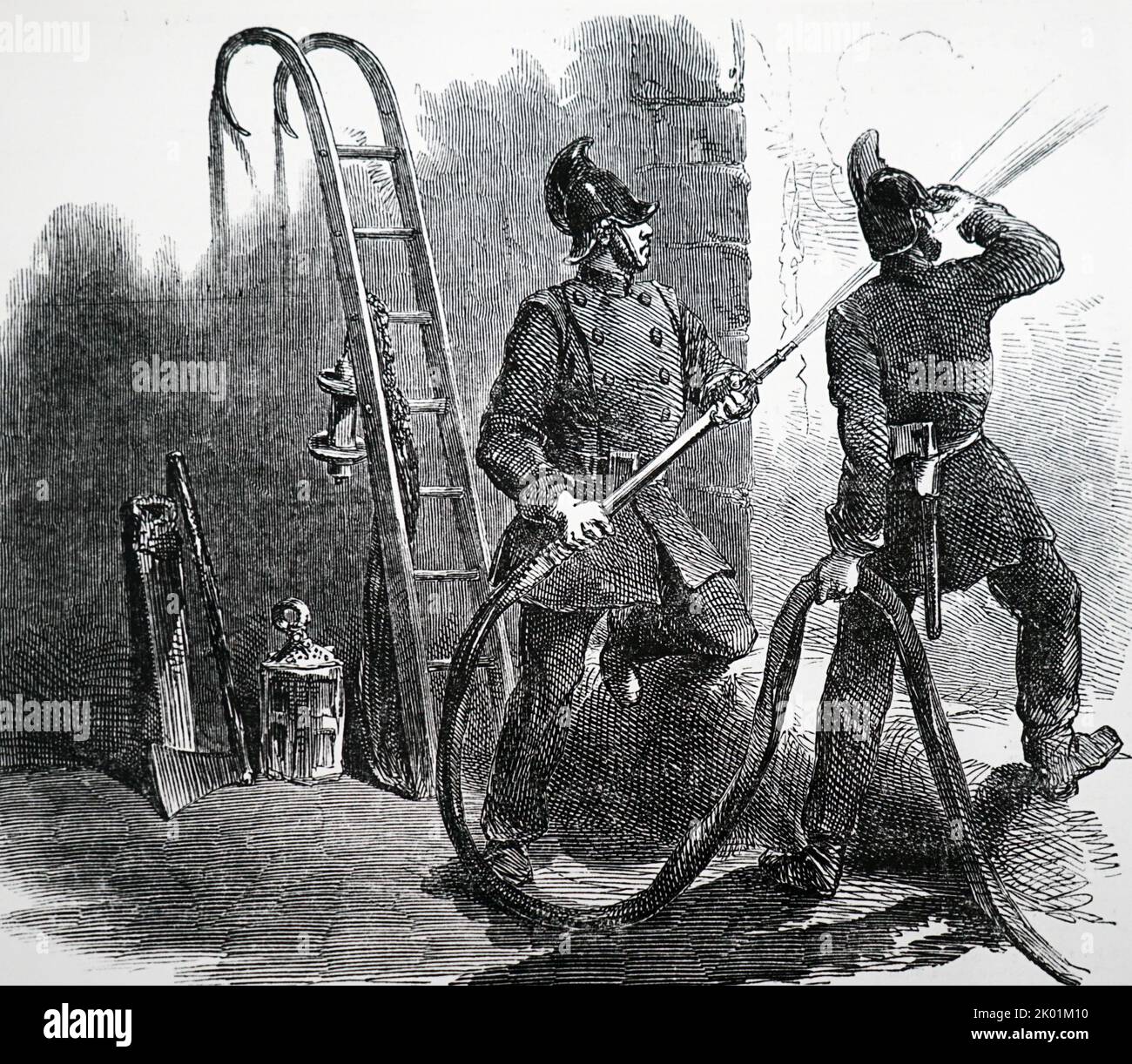 Members of the London Fire Brigade fighting a fire at the Olympic Theatre off The Strand. Stock Photohttps://www.alamy.com/image-license-details/?v=1https://www.alamy.com/members-of-the-london-fire-brigade-fighting-a-fire-at-the-olympic-theatre-off-the-strand-image481927964.html
Members of the London Fire Brigade fighting a fire at the Olympic Theatre off The Strand. Stock Photohttps://www.alamy.com/image-license-details/?v=1https://www.alamy.com/members-of-the-london-fire-brigade-fighting-a-fire-at-the-olympic-theatre-off-the-strand-image481927964.htmlRM2K01M10–Members of the London Fire Brigade fighting a fire at the Olympic Theatre off The Strand.
 Merryweather and Son's improved London Brigade fire engine, 1862. From A Concise History of The International Exhibition of 1862, published 1862. Stock Photohttps://www.alamy.com/image-license-details/?v=1https://www.alamy.com/merryweather-and-sons-improved-london-brigade-fire-engine-1862-from-a-concise-history-of-the-international-exhibition-of-1862-published-1862-image426436727.html
Merryweather and Son's improved London Brigade fire engine, 1862. From A Concise History of The International Exhibition of 1862, published 1862. Stock Photohttps://www.alamy.com/image-license-details/?v=1https://www.alamy.com/merryweather-and-sons-improved-london-brigade-fire-engine-1862-from-a-concise-history-of-the-international-exhibition-of-1862-published-1862-image426436727.htmlRM2FNNTB3–Merryweather and Son's improved London Brigade fire engine, 1862. From A Concise History of The International Exhibition of 1862, published 1862.
 LONDON: The Fire Brigade- Group of Firemen, with Engine and Turncocks, 1896 Stock Photohttps://www.alamy.com/image-license-details/?v=1https://www.alamy.com/stock-photo-london-the-fire-brigade-group-of-firemen-with-engine-and-turncocks-94438675.html
LONDON: The Fire Brigade- Group of Firemen, with Engine and Turncocks, 1896 Stock Photohttps://www.alamy.com/image-license-details/?v=1https://www.alamy.com/stock-photo-london-the-fire-brigade-group-of-firemen-with-engine-and-turncocks-94438675.htmlRMFDJ1DR–LONDON: The Fire Brigade- Group of Firemen, with Engine and Turncocks, 1896
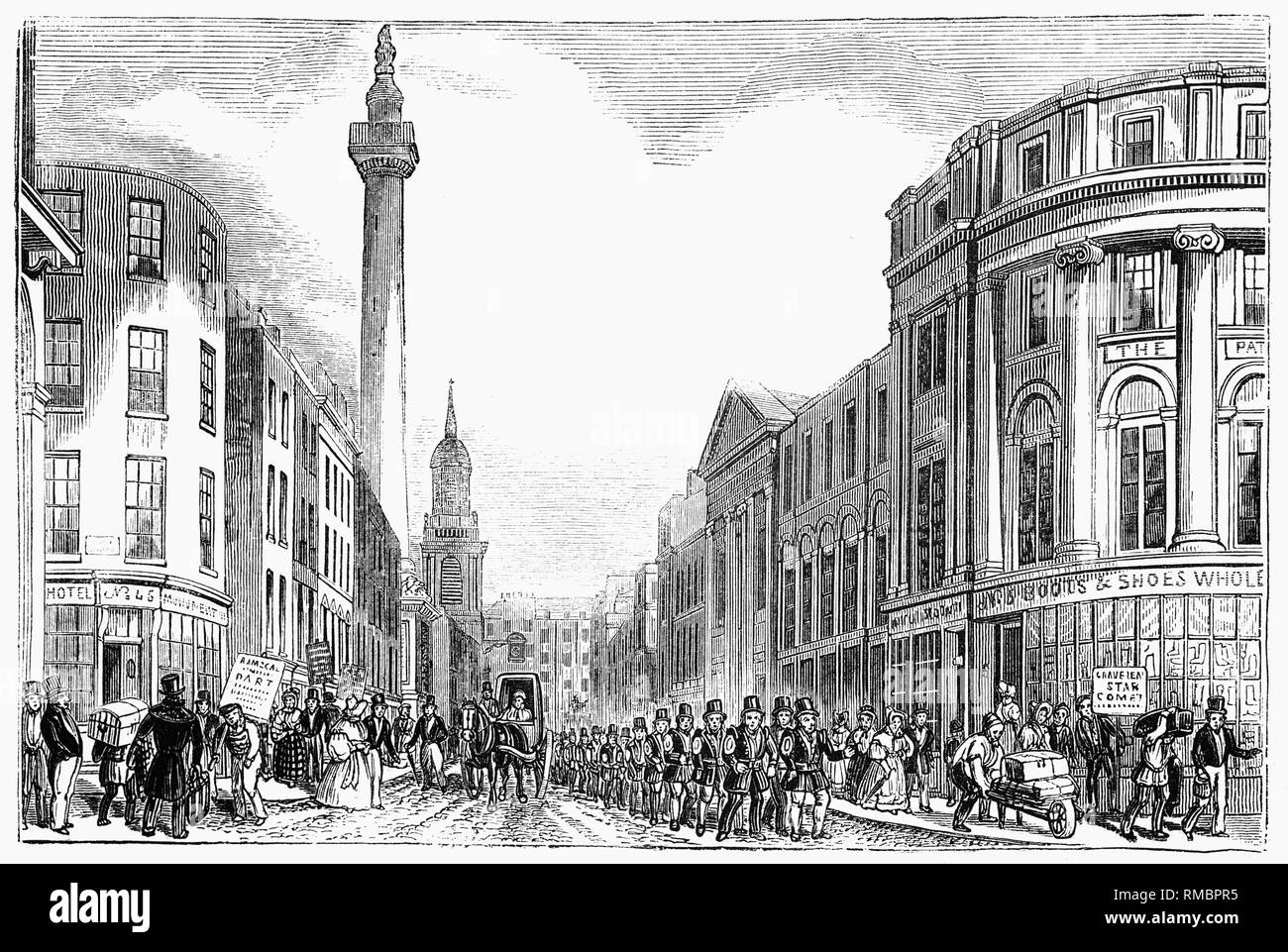 Members of the 19th century London Fire Brigade march on Old Fish Street Hill below the Monument to the Great Fire, a Doric column in London, United Kingdom, situated near the northern end of London Bridge. Commemorating the Great Fire of London, it stands at the junction of Monument Street and Fish Street Hill, 202 feet just west of the spot in Pudding Lane where the Great Fire started on 2 September 1666. Constructed between 1671 and 1677, it was built on the site of St. Margaret's, Fish Street, the first church to be destroyed by the Great Fire. Stock Photohttps://www.alamy.com/image-license-details/?v=1https://www.alamy.com/members-of-the-19th-century-london-fire-brigade-march-on-old-fish-street-hill-below-the-monument-to-the-great-fire-a-doric-column-in-london-united-kingdom-situated-near-the-northern-end-of-london-bridge-commemorating-the-great-fire-of-london-it-stands-at-the-junction-of-monument-street-and-fish-street-hill-202-feet-just-west-of-the-spot-in-pudding-lane-where-the-great-fire-started-on-2-september-1666-constructed-between-1671-and-1677-it-was-built-on-the-site-of-st-margarets-fish-street-the-first-church-to-be-destroyed-by-the-great-fire-image236287273.html
Members of the 19th century London Fire Brigade march on Old Fish Street Hill below the Monument to the Great Fire, a Doric column in London, United Kingdom, situated near the northern end of London Bridge. Commemorating the Great Fire of London, it stands at the junction of Monument Street and Fish Street Hill, 202 feet just west of the spot in Pudding Lane where the Great Fire started on 2 September 1666. Constructed between 1671 and 1677, it was built on the site of St. Margaret's, Fish Street, the first church to be destroyed by the Great Fire. Stock Photohttps://www.alamy.com/image-license-details/?v=1https://www.alamy.com/members-of-the-19th-century-london-fire-brigade-march-on-old-fish-street-hill-below-the-monument-to-the-great-fire-a-doric-column-in-london-united-kingdom-situated-near-the-northern-end-of-london-bridge-commemorating-the-great-fire-of-london-it-stands-at-the-junction-of-monument-street-and-fish-street-hill-202-feet-just-west-of-the-spot-in-pudding-lane-where-the-great-fire-started-on-2-september-1666-constructed-between-1671-and-1677-it-was-built-on-the-site-of-st-margarets-fish-street-the-first-church-to-be-destroyed-by-the-great-fire-image236287273.htmlRMRMBPR5–Members of the 19th century London Fire Brigade march on Old Fish Street Hill below the Monument to the Great Fire, a Doric column in London, United Kingdom, situated near the northern end of London Bridge. Commemorating the Great Fire of London, it stands at the junction of Monument Street and Fish Street Hill, 202 feet just west of the spot in Pudding Lane where the Great Fire started on 2 September 1666. Constructed between 1671 and 1677, it was built on the site of St. Margaret's, Fish Street, the first church to be destroyed by the Great Fire.
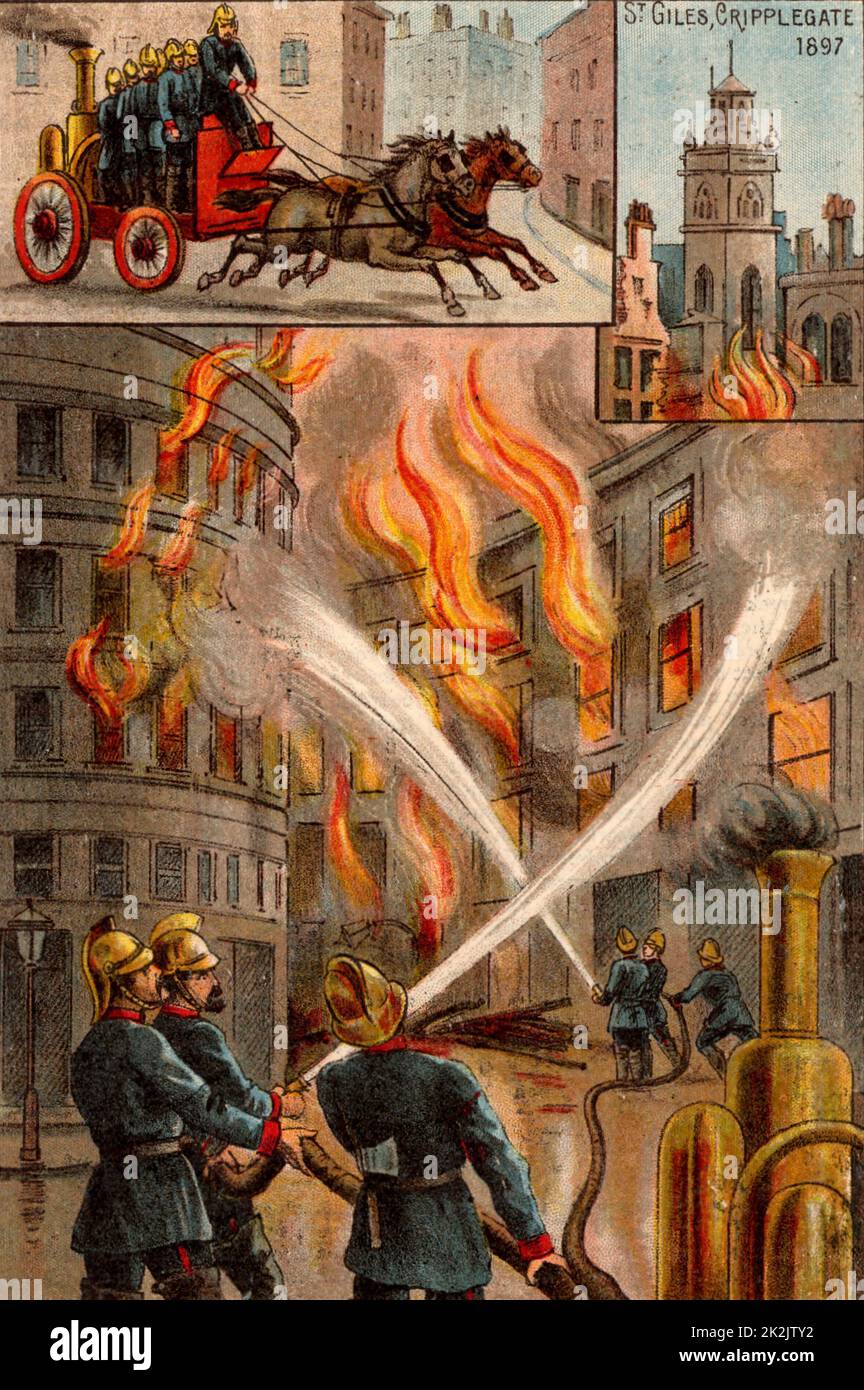 Men of the Metropolitan Fire Brigade fighting outbreak of fire in the City of London 19 November 1897. About 100 warehouses destroyed and the roof of St Giles Church, Cripplegate which had survived Great Fire of 1666 was damaged and John Milton's monument burnt. Horse-drawn steam fire engine used to pump water. From 'Bubbles' c1900 published by Dr Barnados Homes for children. Oleograph. Stock Photohttps://www.alamy.com/image-license-details/?v=1https://www.alamy.com/men-of-the-metropolitan-fire-brigade-fighting-outbreak-of-fire-in-the-city-of-london-19-november-1897-about-100-warehouses-destroyed-and-the-roof-of-st-giles-church-cripplegate-which-had-survived-great-fire-of-1666-was-damaged-and-john-miltons-monument-burnt-horse-drawn-steam-fire-engine-used-to-pump-water-from-bubbles-c1900-published-by-dr-barnados-homes-for-children-oleograph-image483534326.html
Men of the Metropolitan Fire Brigade fighting outbreak of fire in the City of London 19 November 1897. About 100 warehouses destroyed and the roof of St Giles Church, Cripplegate which had survived Great Fire of 1666 was damaged and John Milton's monument burnt. Horse-drawn steam fire engine used to pump water. From 'Bubbles' c1900 published by Dr Barnados Homes for children. Oleograph. Stock Photohttps://www.alamy.com/image-license-details/?v=1https://www.alamy.com/men-of-the-metropolitan-fire-brigade-fighting-outbreak-of-fire-in-the-city-of-london-19-november-1897-about-100-warehouses-destroyed-and-the-roof-of-st-giles-church-cripplegate-which-had-survived-great-fire-of-1666-was-damaged-and-john-miltons-monument-burnt-horse-drawn-steam-fire-engine-used-to-pump-water-from-bubbles-c1900-published-by-dr-barnados-homes-for-children-oleograph-image483534326.htmlRM2K2JTY2–Men of the Metropolitan Fire Brigade fighting outbreak of fire in the City of London 19 November 1897. About 100 warehouses destroyed and the roof of St Giles Church, Cripplegate which had survived Great Fire of 1666 was damaged and John Milton's monument burnt. Horse-drawn steam fire engine used to pump water. From 'Bubbles' c1900 published by Dr Barnados Homes for children. Oleograph.
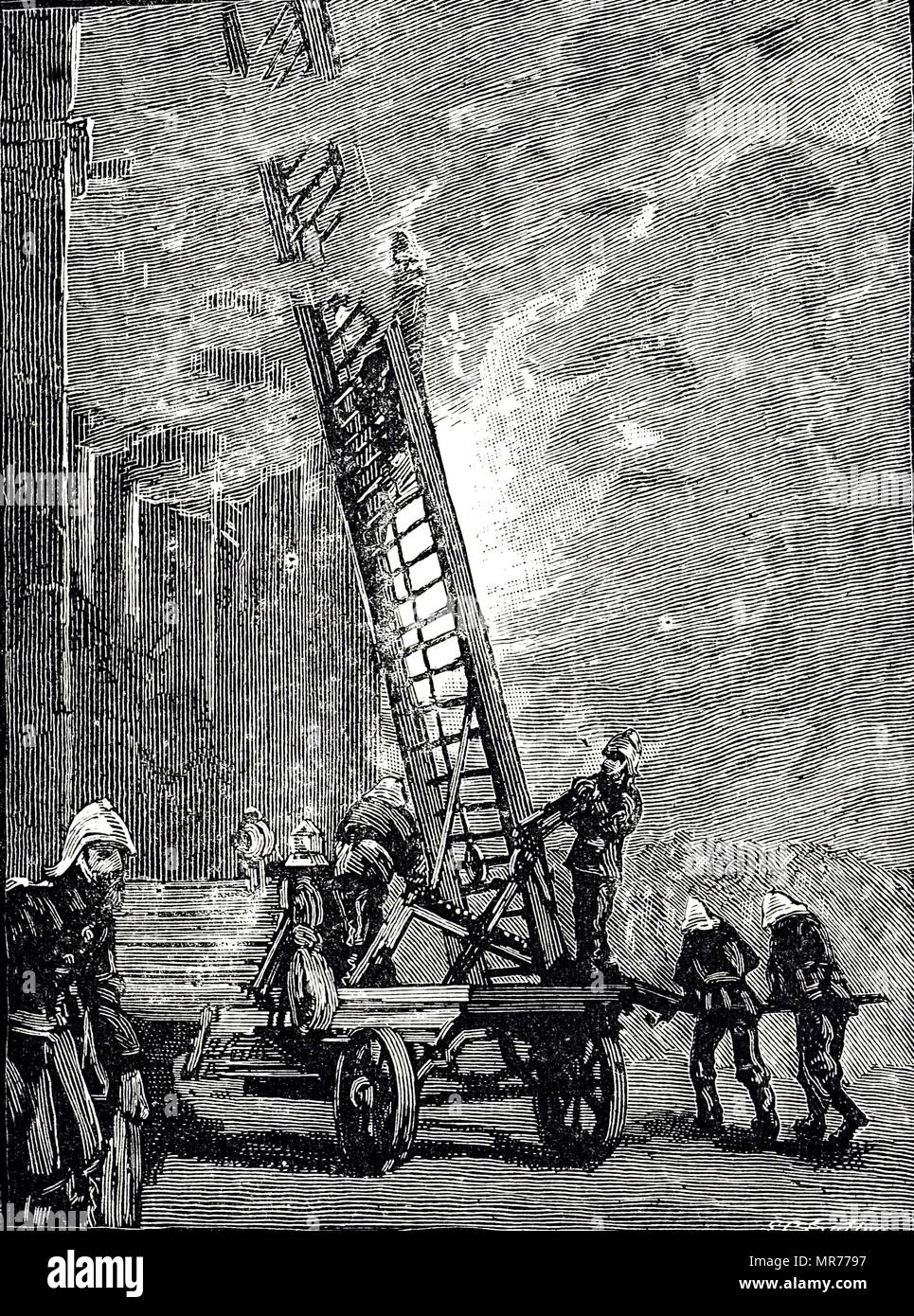 Engraving depicting members of the London Fire Brigade using the newly introduced fire-ladder truck. Dated 19th century Stock Photohttps://www.alamy.com/image-license-details/?v=1https://www.alamy.com/engraving-depicting-members-of-the-london-fire-brigade-using-the-newly-introduced-fire-ladder-truck-dated-19th-century-image186400179.html
Engraving depicting members of the London Fire Brigade using the newly introduced fire-ladder truck. Dated 19th century Stock Photohttps://www.alamy.com/image-license-details/?v=1https://www.alamy.com/engraving-depicting-members-of-the-london-fire-brigade-using-the-newly-introduced-fire-ladder-truck-dated-19th-century-image186400179.htmlRMMR7797–Engraving depicting members of the London Fire Brigade using the newly introduced fire-ladder truck. Dated 19th century
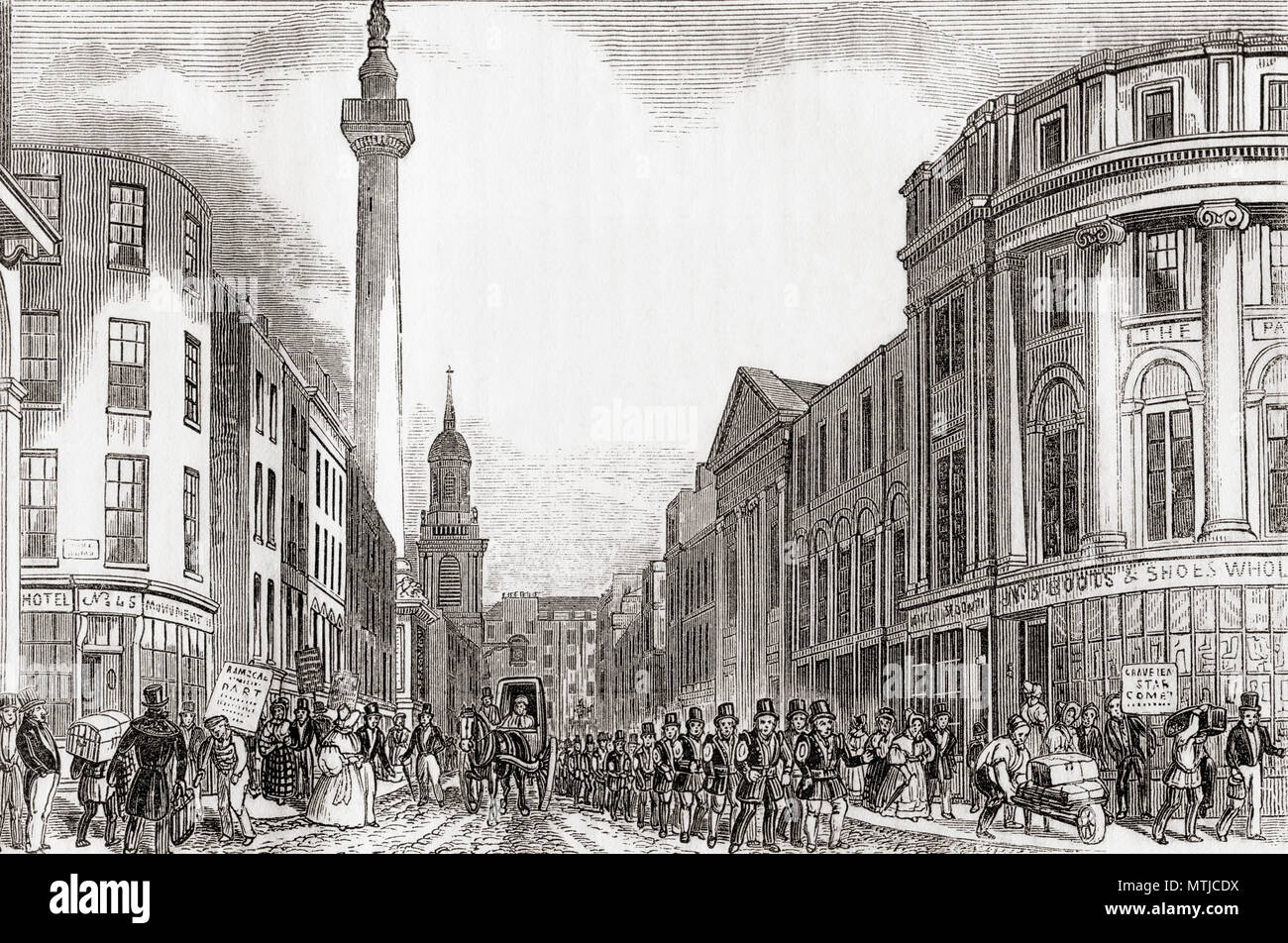 Old Fish Street Hill and the Monument to the Great Fire with members of the London Fire Brigade, London, England, 19th century. From Old England: A Pictorial Museum, published 1847. Stock Photohttps://www.alamy.com/image-license-details/?v=1https://www.alamy.com/old-fish-street-hill-and-the-monument-to-the-great-fire-with-members-of-the-london-fire-brigade-london-england-19th-century-from-old-england-a-pictorial-museum-published-1847-image187260358.html
Old Fish Street Hill and the Monument to the Great Fire with members of the London Fire Brigade, London, England, 19th century. From Old England: A Pictorial Museum, published 1847. Stock Photohttps://www.alamy.com/image-license-details/?v=1https://www.alamy.com/old-fish-street-hill-and-the-monument-to-the-great-fire-with-members-of-the-london-fire-brigade-london-england-19th-century-from-old-england-a-pictorial-museum-published-1847-image187260358.htmlRMMTJCDX–Old Fish Street Hill and the Monument to the Great Fire with members of the London Fire Brigade, London, England, 19th century. From Old England: A Pictorial Museum, published 1847.
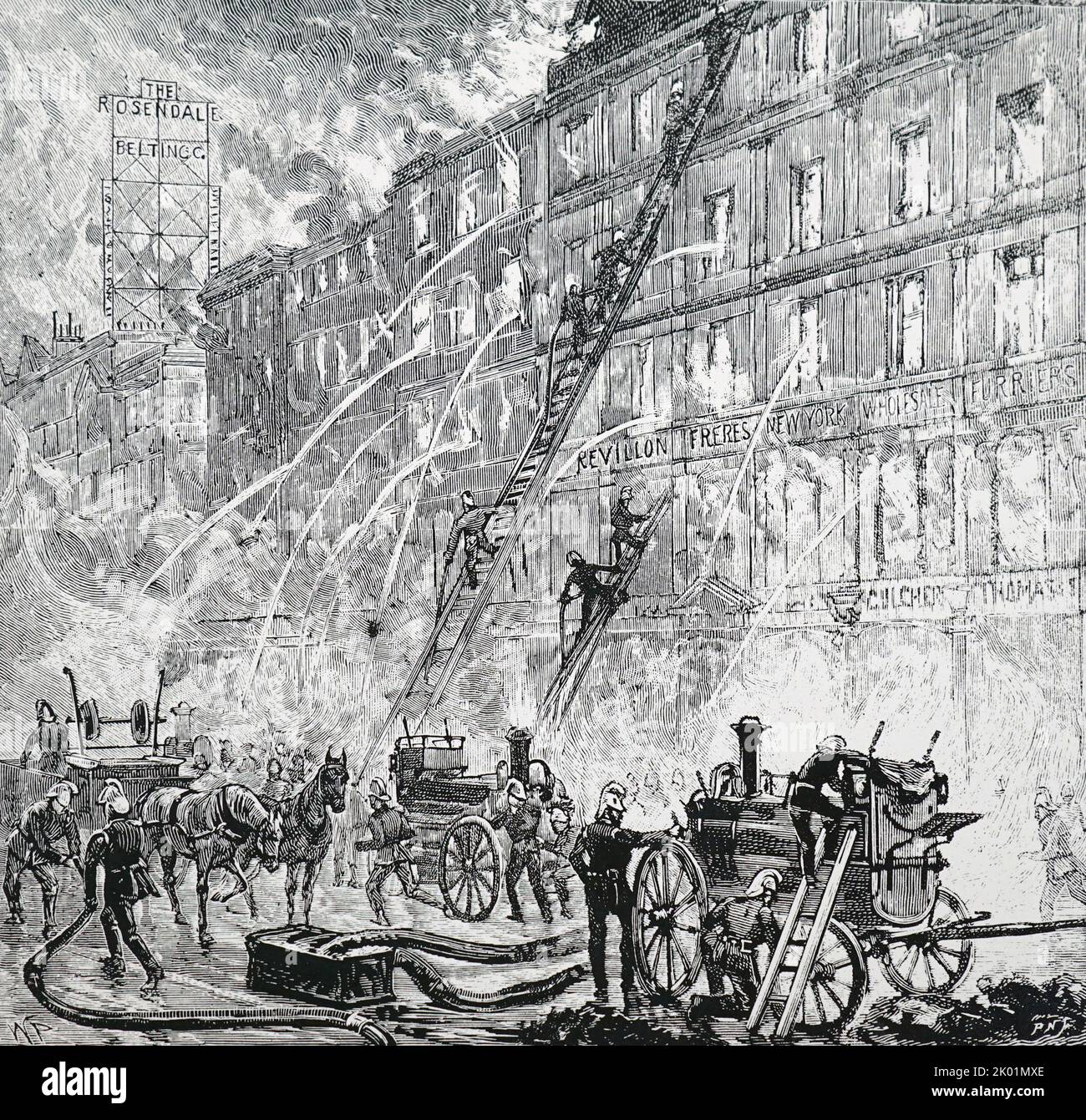 Firemen fighting a fire in Victoria Street, London, 1890. The Metropolitan Fire Brigade, under the direction of Captain Shaw, used 23 steam fire engines. Stock Photohttps://www.alamy.com/image-license-details/?v=1https://www.alamy.com/firemen-fighting-a-fire-in-victoria-street-london-1890-the-metropolitan-fire-brigade-under-the-direction-of-captain-shaw-used-23-steam-fire-engines-image481928678.html
Firemen fighting a fire in Victoria Street, London, 1890. The Metropolitan Fire Brigade, under the direction of Captain Shaw, used 23 steam fire engines. Stock Photohttps://www.alamy.com/image-license-details/?v=1https://www.alamy.com/firemen-fighting-a-fire-in-victoria-street-london-1890-the-metropolitan-fire-brigade-under-the-direction-of-captain-shaw-used-23-steam-fire-engines-image481928678.htmlRM2K01MXE–Firemen fighting a fire in Victoria Street, London, 1890. The Metropolitan Fire Brigade, under the direction of Captain Shaw, used 23 steam fire engines.
 Illustration depicting Captain Eyre Massey Shaw (1830-1908) the Superintendent of the Metropolitan Fire Brigade and the London Fire Engine Establishment. Dated 19th Century Stock Photohttps://www.alamy.com/image-license-details/?v=1https://www.alamy.com/illustration-depicting-captain-eyre-massey-shaw-1830-1908-the-superintendent-of-the-metropolitan-fire-brigade-and-the-london-fire-engine-establishment-dated-19th-century-image642218770.html
Illustration depicting Captain Eyre Massey Shaw (1830-1908) the Superintendent of the Metropolitan Fire Brigade and the London Fire Engine Establishment. Dated 19th Century Stock Photohttps://www.alamy.com/image-license-details/?v=1https://www.alamy.com/illustration-depicting-captain-eyre-massey-shaw-1830-1908-the-superintendent-of-the-metropolitan-fire-brigade-and-the-london-fire-engine-establishment-dated-19th-century-image642218770.htmlRM2S8RGGJ–Illustration depicting Captain Eyre Massey Shaw (1830-1908) the Superintendent of the Metropolitan Fire Brigade and the London Fire Engine Establishment. Dated 19th Century
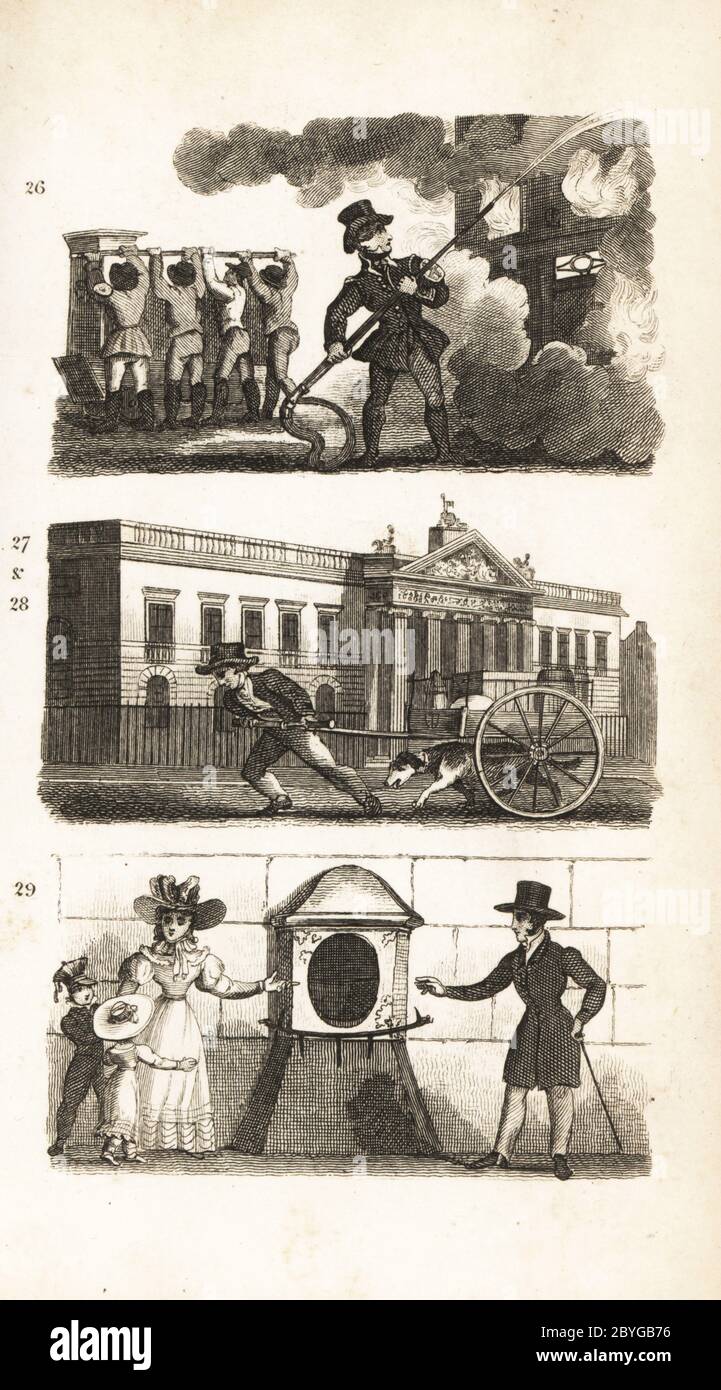 The Fire-Engine, Drawing Goods on a Truck, East India House and London Stone. London fire brigade pumping water on a fire 26, man hauling freight on a dog-drawn cart 27 in front of East India House 28, and the London Stone in Cannon Street erected by the Romans 29. Woodcut engraving after an illustration by Isaac Taylor from City Scenes, or a Peep into London, by Ann Taylor and Jane Taylor, published by Harvey and Darton, Gracechurch Street, London, 1828. English sisters Ann and Jane Taylor were prolific Romantic poets and writers of children’s books in the early 19th century. Stock Photohttps://www.alamy.com/image-license-details/?v=1https://www.alamy.com/the-fire-engine-drawing-goods-on-a-truck-east-india-house-and-london-stone-london-fire-brigade-pumping-water-on-a-fire-26-man-hauling-freight-on-a-dog-drawn-cart-27-in-front-of-east-india-house-28-and-the-london-stone-in-cannon-street-erected-by-the-romans-29-woodcut-engraving-after-an-illustration-by-isaac-taylor-from-city-scenes-or-a-peep-into-london-by-ann-taylor-and-jane-taylor-published-by-harvey-and-darton-gracechurch-street-london-1828-english-sisters-ann-and-jane-taylor-were-prolific-romantic-poets-and-writers-of-childrens-books-in-the-early-19th-century-image361163130.html
The Fire-Engine, Drawing Goods on a Truck, East India House and London Stone. London fire brigade pumping water on a fire 26, man hauling freight on a dog-drawn cart 27 in front of East India House 28, and the London Stone in Cannon Street erected by the Romans 29. Woodcut engraving after an illustration by Isaac Taylor from City Scenes, or a Peep into London, by Ann Taylor and Jane Taylor, published by Harvey and Darton, Gracechurch Street, London, 1828. English sisters Ann and Jane Taylor were prolific Romantic poets and writers of children’s books in the early 19th century. Stock Photohttps://www.alamy.com/image-license-details/?v=1https://www.alamy.com/the-fire-engine-drawing-goods-on-a-truck-east-india-house-and-london-stone-london-fire-brigade-pumping-water-on-a-fire-26-man-hauling-freight-on-a-dog-drawn-cart-27-in-front-of-east-india-house-28-and-the-london-stone-in-cannon-street-erected-by-the-romans-29-woodcut-engraving-after-an-illustration-by-isaac-taylor-from-city-scenes-or-a-peep-into-london-by-ann-taylor-and-jane-taylor-published-by-harvey-and-darton-gracechurch-street-london-1828-english-sisters-ann-and-jane-taylor-were-prolific-romantic-poets-and-writers-of-childrens-books-in-the-early-19th-century-image361163130.htmlRM2BYGB76–The Fire-Engine, Drawing Goods on a Truck, East India House and London Stone. London fire brigade pumping water on a fire 26, man hauling freight on a dog-drawn cart 27 in front of East India House 28, and the London Stone in Cannon Street erected by the Romans 29. Woodcut engraving after an illustration by Isaac Taylor from City Scenes, or a Peep into London, by Ann Taylor and Jane Taylor, published by Harvey and Darton, Gracechurch Street, London, 1828. English sisters Ann and Jane Taylor were prolific Romantic poets and writers of children’s books in the early 19th century.
 Fire at the Covent Garden Theatre, London (6 March 1856) during a bal masque given by Professor Anderson. Opened 7 December Stock Photohttps://www.alamy.com/image-license-details/?v=1https://www.alamy.com/stock-photo-fire-at-the-covent-garden-theatre-london-6-march-1856-during-a-bal-83357574.html
Fire at the Covent Garden Theatre, London (6 March 1856) during a bal masque given by Professor Anderson. Opened 7 December Stock Photohttps://www.alamy.com/image-license-details/?v=1https://www.alamy.com/stock-photo-fire-at-the-covent-garden-theatre-london-6-march-1856-during-a-bal-83357574.htmlRMERH7C6–Fire at the Covent Garden Theatre, London (6 March 1856) during a bal masque given by Professor Anderson. Opened 7 December
 The London Fire Brigade at practice on the Thames Embankment. Trades 1868 Stock Photohttps://www.alamy.com/image-license-details/?v=1https://www.alamy.com/the-london-fire-brigade-at-practice-on-the-thames-embankment-trades-1868-image272489524.html
The London Fire Brigade at practice on the Thames Embankment. Trades 1868 Stock Photohttps://www.alamy.com/image-license-details/?v=1https://www.alamy.com/the-london-fire-brigade-at-practice-on-the-thames-embankment-trades-1868-image272489524.htmlRFWR8Y4M–The London Fire Brigade at practice on the Thames Embankment. Trades 1868
 Fire at the Covent Garden Theatre, London (6 March 1856) during a bal masque given by Professor Anderson. Opened 7 December Stock Photohttps://www.alamy.com/image-license-details/?v=1https://www.alamy.com/stock-photo-fire-at-the-covent-garden-theatre-london-6-march-1856-during-a-bal-83358408.html
Fire at the Covent Garden Theatre, London (6 March 1856) during a bal masque given by Professor Anderson. Opened 7 December Stock Photohttps://www.alamy.com/image-license-details/?v=1https://www.alamy.com/stock-photo-fire-at-the-covent-garden-theatre-london-6-march-1856-during-a-bal-83358408.htmlRMERH8E0–Fire at the Covent Garden Theatre, London (6 March 1856) during a bal masque given by Professor Anderson. Opened 7 December
 Headquarters of the Metropolitan fire Brigade. London 1896 old antique print Stock Photohttps://www.alamy.com/image-license-details/?v=1https://www.alamy.com/headquarters-of-the-metropolitan-fire-brigade-london-1896-old-antique-print-image183035241.html
Headquarters of the Metropolitan fire Brigade. London 1896 old antique print Stock Photohttps://www.alamy.com/image-license-details/?v=1https://www.alamy.com/headquarters-of-the-metropolitan-fire-brigade-london-1896-old-antique-print-image183035241.htmlRFMHNY8W–Headquarters of the Metropolitan fire Brigade. London 1896 old antique print
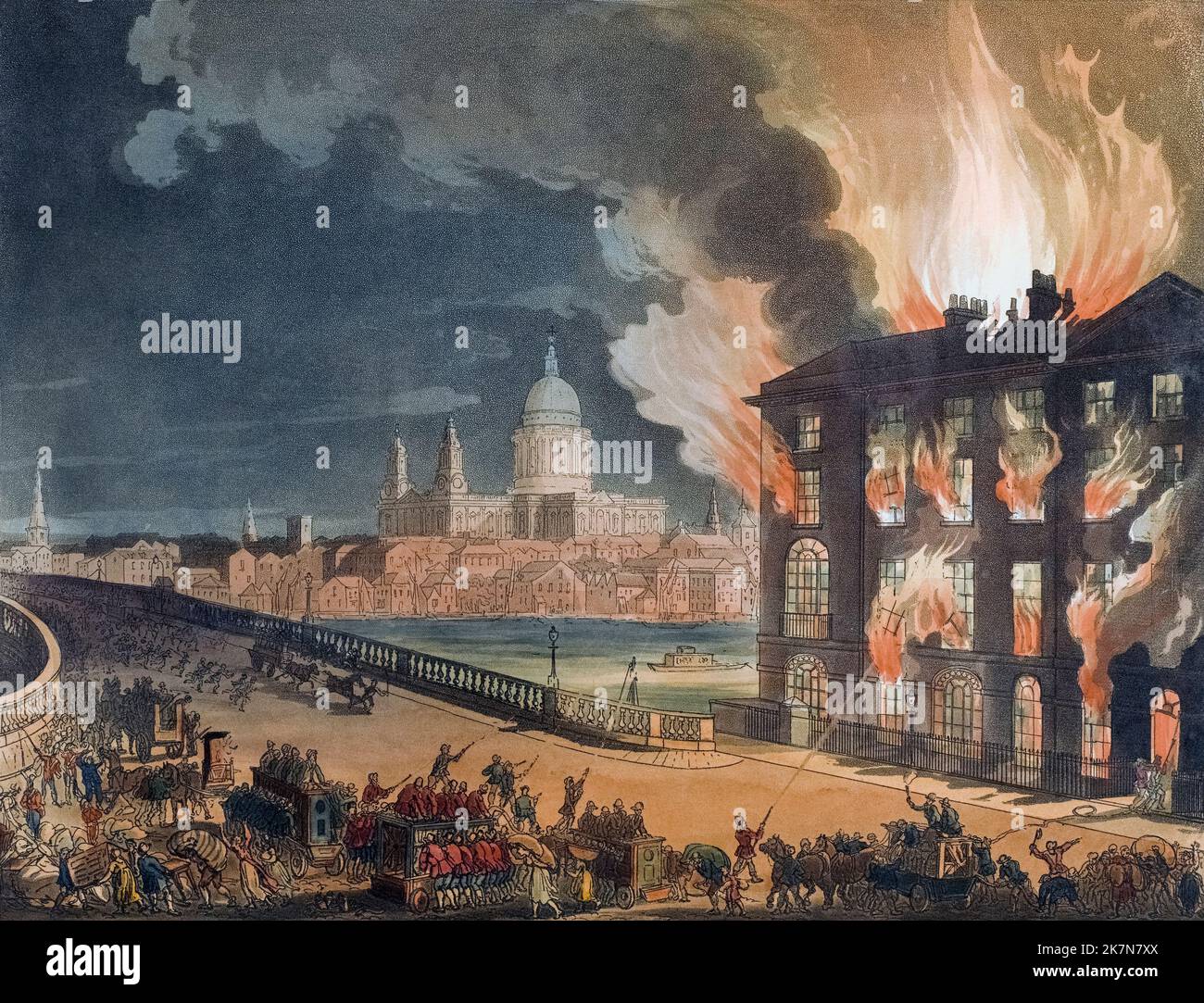 Fire in London. The destruction of the Albion flour mill beside the Blackfriars Bridge, March 2, 1791. After a work by August Pugin and Thomas Rowlandson in the Microcosm of London, published in three volumes between 1808 and 1810 by Rudolph Ackermann. Pugin was the artist responsible for the architectural elements in the Microcosm pictures; Thomas Rowlandson was hired to add the lively human figures. Stock Photohttps://www.alamy.com/image-license-details/?v=1https://www.alamy.com/fire-in-london-the-destruction-of-the-albion-flour-mill-beside-the-blackfriars-bridge-march-2-1791-after-a-work-by-august-pugin-and-thomas-rowlandson-in-the-microcosm-of-london-published-in-three-volumes-between-1808-and-1810-by-rudolph-ackermann-pugin-was-the-artist-responsible-for-the-architectural-elements-in-the-microcosm-pictures-thomas-rowlandson-was-hired-to-add-the-lively-human-figures-image486660130.html
Fire in London. The destruction of the Albion flour mill beside the Blackfriars Bridge, March 2, 1791. After a work by August Pugin and Thomas Rowlandson in the Microcosm of London, published in three volumes between 1808 and 1810 by Rudolph Ackermann. Pugin was the artist responsible for the architectural elements in the Microcosm pictures; Thomas Rowlandson was hired to add the lively human figures. Stock Photohttps://www.alamy.com/image-license-details/?v=1https://www.alamy.com/fire-in-london-the-destruction-of-the-albion-flour-mill-beside-the-blackfriars-bridge-march-2-1791-after-a-work-by-august-pugin-and-thomas-rowlandson-in-the-microcosm-of-london-published-in-three-volumes-between-1808-and-1810-by-rudolph-ackermann-pugin-was-the-artist-responsible-for-the-architectural-elements-in-the-microcosm-pictures-thomas-rowlandson-was-hired-to-add-the-lively-human-figures-image486660130.htmlRM2K7N7XX–Fire in London. The destruction of the Albion flour mill beside the Blackfriars Bridge, March 2, 1791. After a work by August Pugin and Thomas Rowlandson in the Microcosm of London, published in three volumes between 1808 and 1810 by Rudolph Ackermann. Pugin was the artist responsible for the architectural elements in the Microcosm pictures; Thomas Rowlandson was hired to add the lively human figures.
 Burning of the Irwell Building, Manchester; Black and White Illustration from the London Illustrated News; August 1844. Stock Photohttps://www.alamy.com/image-license-details/?v=1https://www.alamy.com/burning-of-the-irwell-building-manchester-black-and-white-illustration-from-the-london-illustrated-news-august-1844-image504778146.html
Burning of the Irwell Building, Manchester; Black and White Illustration from the London Illustrated News; August 1844. Stock Photohttps://www.alamy.com/image-license-details/?v=1https://www.alamy.com/burning-of-the-irwell-building-manchester-black-and-white-illustration-from-the-london-illustrated-news-august-1844-image504778146.htmlRM2M96HJX–Burning of the Irwell Building, Manchester; Black and White Illustration from the London Illustrated News; August 1844.
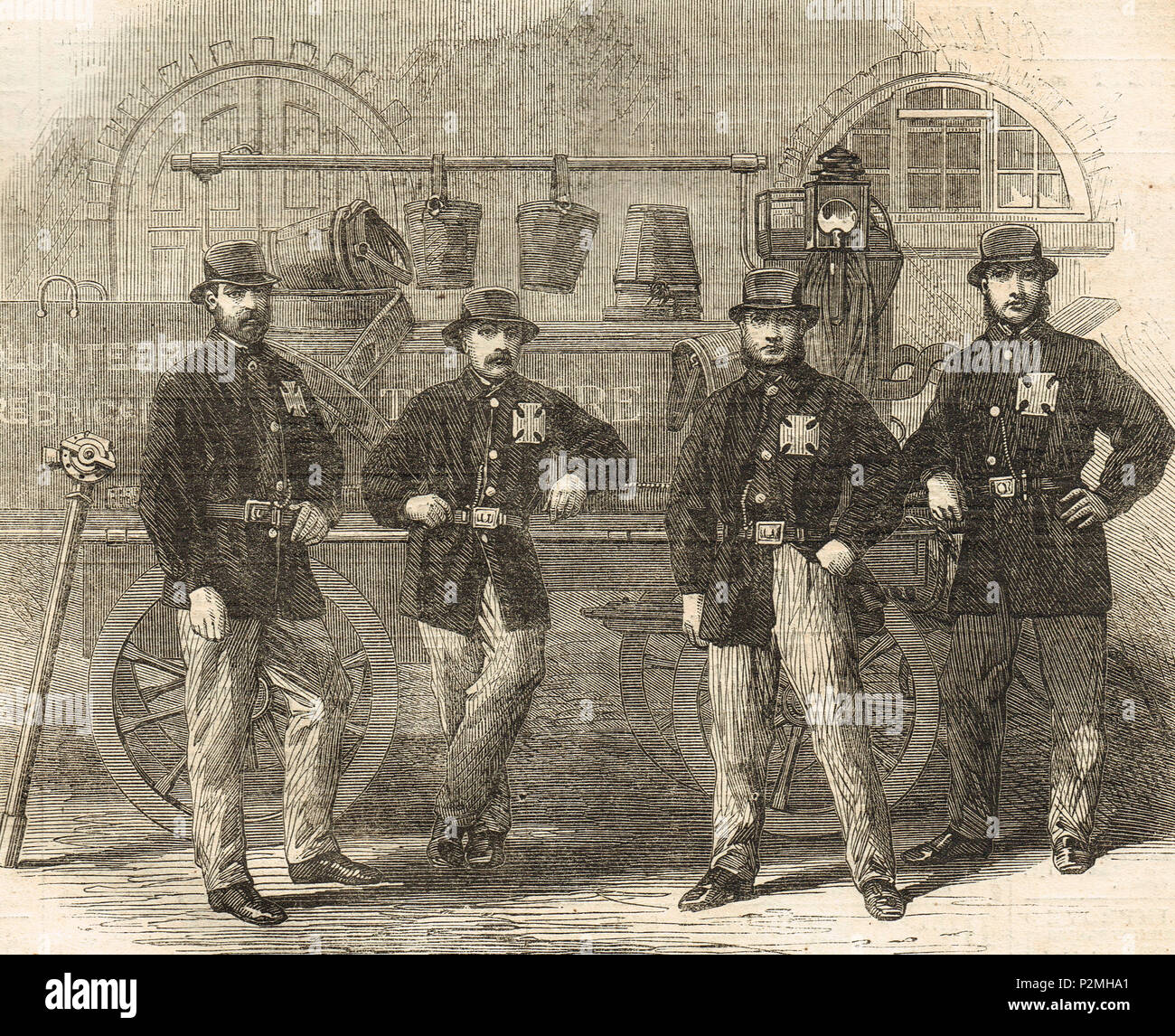 Members of the Coventry Volunteer Fire Brigade, 1862 Stock Photohttps://www.alamy.com/image-license-details/?v=1https://www.alamy.com/members-of-the-coventry-volunteer-fire-brigade-1862-image208206377.html
Members of the Coventry Volunteer Fire Brigade, 1862 Stock Photohttps://www.alamy.com/image-license-details/?v=1https://www.alamy.com/members-of-the-coventry-volunteer-fire-brigade-1862-image208206377.htmlRMP2MHA1–Members of the Coventry Volunteer Fire Brigade, 1862
 An old engraving of a Thames fire-fighting barge or boat, LFE 20, in Victorian times, London, England, UK. In London individual insurance companies established fire-fighting units to tackle fires in buildings that each company insured. They co-operated to form the London Fire (Engine) Establishment (LFEE or LFE) in 1833 under the leadership of James Braidwood. One mode of tackling fires along the River Thames was by fire-boat. The fire insurance companies informed the government it was not commercially viable to fight fires and in 1866 the Metropolitan Fire Brigade (MFB) came into being. Stock Photohttps://www.alamy.com/image-license-details/?v=1https://www.alamy.com/an-old-engraving-of-a-thames-fire-fighting-barge-or-boat-lfe-20-in-victorian-times-london-england-uk-in-london-individual-insurance-companies-established-fire-fighting-units-to-tackle-fires-in-buildings-that-each-company-insured-they-co-operated-to-form-the-london-fire-engine-establishment-lfee-or-lfe-in-1833-under-the-leadership-of-james-braidwood-one-mode-of-tackling-fires-along-the-river-thames-was-by-fire-boat-the-fire-insurance-companies-informed-the-government-it-was-not-commercially-viable-to-fight-fires-and-in-1866-the-metropolitan-fire-brigade-mfb-came-into-being-image370537751.html
An old engraving of a Thames fire-fighting barge or boat, LFE 20, in Victorian times, London, England, UK. In London individual insurance companies established fire-fighting units to tackle fires in buildings that each company insured. They co-operated to form the London Fire (Engine) Establishment (LFEE or LFE) in 1833 under the leadership of James Braidwood. One mode of tackling fires along the River Thames was by fire-boat. The fire insurance companies informed the government it was not commercially viable to fight fires and in 1866 the Metropolitan Fire Brigade (MFB) came into being. Stock Photohttps://www.alamy.com/image-license-details/?v=1https://www.alamy.com/an-old-engraving-of-a-thames-fire-fighting-barge-or-boat-lfe-20-in-victorian-times-london-england-uk-in-london-individual-insurance-companies-established-fire-fighting-units-to-tackle-fires-in-buildings-that-each-company-insured-they-co-operated-to-form-the-london-fire-engine-establishment-lfee-or-lfe-in-1833-under-the-leadership-of-james-braidwood-one-mode-of-tackling-fires-along-the-river-thames-was-by-fire-boat-the-fire-insurance-companies-informed-the-government-it-was-not-commercially-viable-to-fight-fires-and-in-1866-the-metropolitan-fire-brigade-mfb-came-into-being-image370537751.htmlRM2CERCK3–An old engraving of a Thames fire-fighting barge or boat, LFE 20, in Victorian times, London, England, UK. In London individual insurance companies established fire-fighting units to tackle fires in buildings that each company insured. They co-operated to form the London Fire (Engine) Establishment (LFEE or LFE) in 1833 under the leadership of James Braidwood. One mode of tackling fires along the River Thames was by fire-boat. The fire insurance companies informed the government it was not commercially viable to fight fires and in 1866 the Metropolitan Fire Brigade (MFB) came into being.
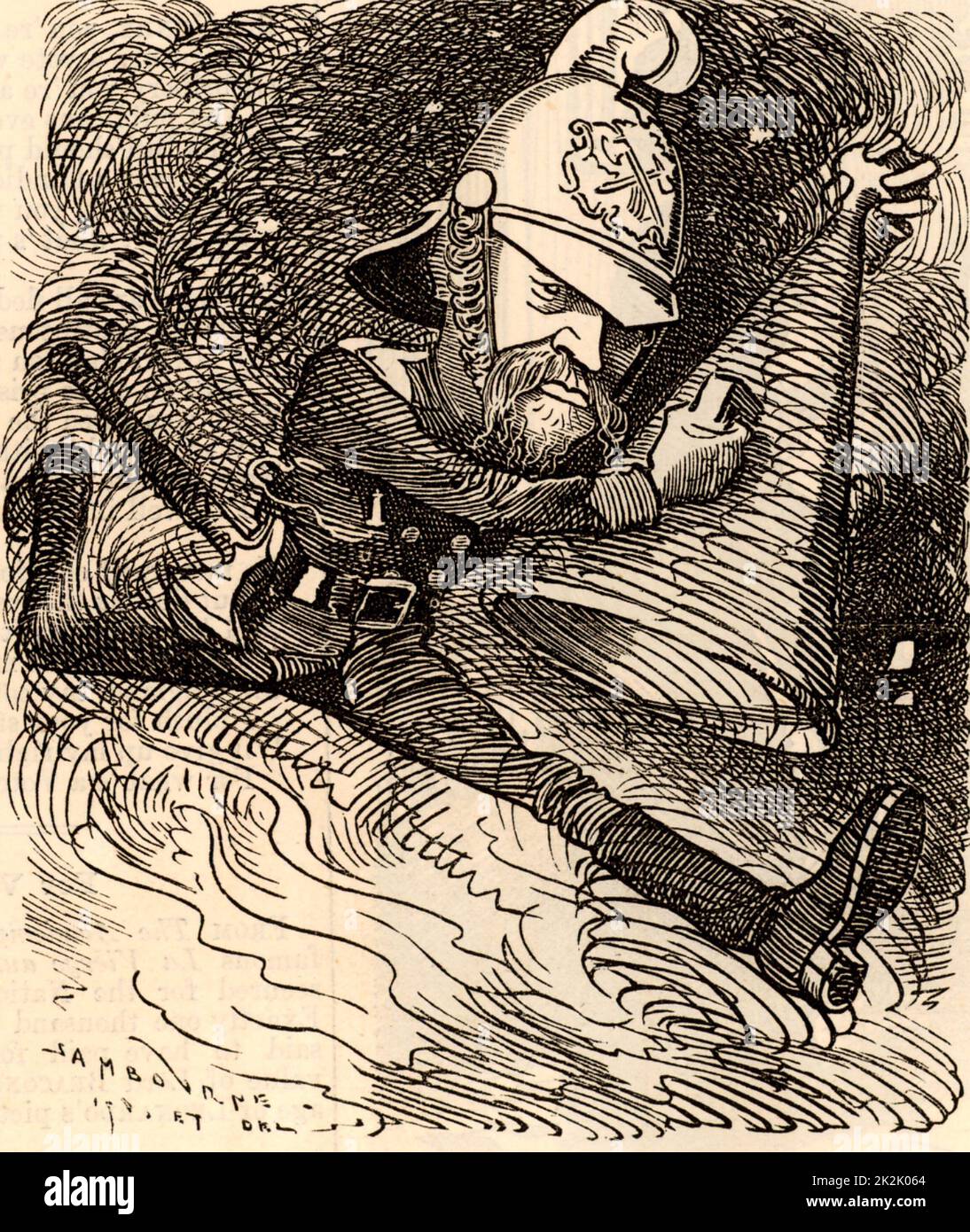 Eyre Massey Shaw (1830-1908) Irish soldier who served in the British army. Widely known as 'Captain Shaw', he was founder and Superintendant of the Metropolitan (now London) Fire Brigade 1861-1891. In Gilbert and Sullivan's light opera 'Iolanthe' the fairy wonders if Captain Shaw's 'brigade with cold cascade' could quench her love. Cartoon by Edward Linley Sambourne in Punch's Fancy Portraits series from 'Punch' (London, 22 January 1881). Stock Photohttps://www.alamy.com/image-license-details/?v=1https://www.alamy.com/eyre-massey-shaw-1830-1908-irish-soldier-who-served-in-the-british-army-widely-known-as-captain-shaw-he-was-founder-and-superintendant-of-the-metropolitan-now-london-fire-brigade-1861-1891-in-gilbert-and-sullivans-light-opera-iolanthe-the-fairy-wonders-if-captain-shaws-brigade-with-cold-cascade-could-quench-her-love-cartoon-by-edward-linley-sambourne-in-punchs-fancy-portraits-series-from-punch-london-22-january-1881-image483536876.html
Eyre Massey Shaw (1830-1908) Irish soldier who served in the British army. Widely known as 'Captain Shaw', he was founder and Superintendant of the Metropolitan (now London) Fire Brigade 1861-1891. In Gilbert and Sullivan's light opera 'Iolanthe' the fairy wonders if Captain Shaw's 'brigade with cold cascade' could quench her love. Cartoon by Edward Linley Sambourne in Punch's Fancy Portraits series from 'Punch' (London, 22 January 1881). Stock Photohttps://www.alamy.com/image-license-details/?v=1https://www.alamy.com/eyre-massey-shaw-1830-1908-irish-soldier-who-served-in-the-british-army-widely-known-as-captain-shaw-he-was-founder-and-superintendant-of-the-metropolitan-now-london-fire-brigade-1861-1891-in-gilbert-and-sullivans-light-opera-iolanthe-the-fairy-wonders-if-captain-shaws-brigade-with-cold-cascade-could-quench-her-love-cartoon-by-edward-linley-sambourne-in-punchs-fancy-portraits-series-from-punch-london-22-january-1881-image483536876.htmlRM2K2K064–Eyre Massey Shaw (1830-1908) Irish soldier who served in the British army. Widely known as 'Captain Shaw', he was founder and Superintendant of the Metropolitan (now London) Fire Brigade 1861-1891. In Gilbert and Sullivan's light opera 'Iolanthe' the fairy wonders if Captain Shaw's 'brigade with cold cascade' could quench her love. Cartoon by Edward Linley Sambourne in Punch's Fancy Portraits series from 'Punch' (London, 22 January 1881).
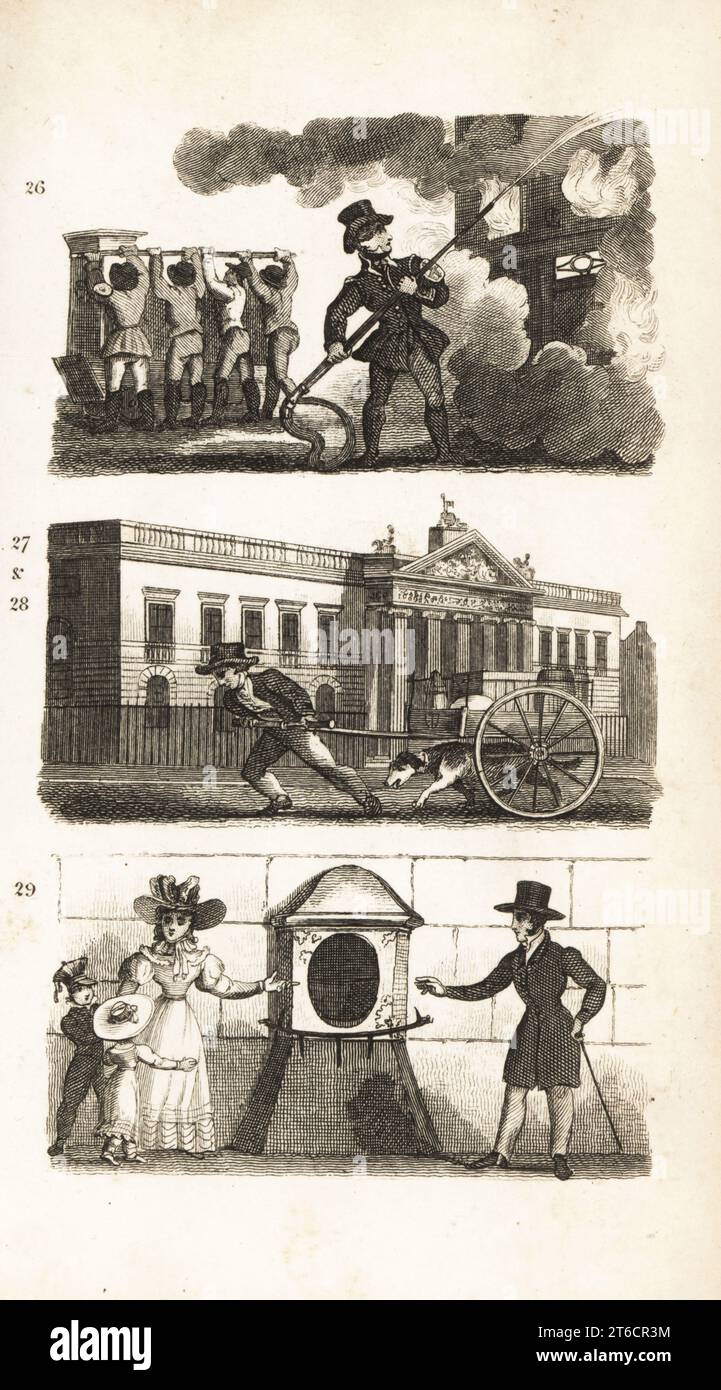 The Fire-Engine, Drawing Goods on a Truck, East India House and London Stone. London fire brigade pumping water on a fire 26, man hauling freight on a dog-drawn cart 27 in front of East India House 28, and the London Stone in Cannon Street erected by the Romans 29. Woodcut engraving after an illustration by Isaac Taylor from City Scenes, or a Peep into London, by Ann Taylor and Jane Taylor, published by Harvey and Darton, Gracechurch Street, London, 1828. English sisters Ann and Jane Taylor were prolific Romantic poets and writers of childrens books in the early 19th century. Stock Photohttps://www.alamy.com/image-license-details/?v=1https://www.alamy.com/the-fire-engine-drawing-goods-on-a-truck-east-india-house-and-london-stone-london-fire-brigade-pumping-water-on-a-fire-26-man-hauling-freight-on-a-dog-drawn-cart-27-in-front-of-east-india-house-28-and-the-london-stone-in-cannon-street-erected-by-the-romans-29-woodcut-engraving-after-an-illustration-by-isaac-taylor-from-city-scenes-or-a-peep-into-london-by-ann-taylor-and-jane-taylor-published-by-harvey-and-darton-gracechurch-street-london-1828-english-sisters-ann-and-jane-taylor-were-prolific-romantic-poets-and-writers-of-childrens-books-in-the-early-19th-century-image571911640.html
The Fire-Engine, Drawing Goods on a Truck, East India House and London Stone. London fire brigade pumping water on a fire 26, man hauling freight on a dog-drawn cart 27 in front of East India House 28, and the London Stone in Cannon Street erected by the Romans 29. Woodcut engraving after an illustration by Isaac Taylor from City Scenes, or a Peep into London, by Ann Taylor and Jane Taylor, published by Harvey and Darton, Gracechurch Street, London, 1828. English sisters Ann and Jane Taylor were prolific Romantic poets and writers of childrens books in the early 19th century. Stock Photohttps://www.alamy.com/image-license-details/?v=1https://www.alamy.com/the-fire-engine-drawing-goods-on-a-truck-east-india-house-and-london-stone-london-fire-brigade-pumping-water-on-a-fire-26-man-hauling-freight-on-a-dog-drawn-cart-27-in-front-of-east-india-house-28-and-the-london-stone-in-cannon-street-erected-by-the-romans-29-woodcut-engraving-after-an-illustration-by-isaac-taylor-from-city-scenes-or-a-peep-into-london-by-ann-taylor-and-jane-taylor-published-by-harvey-and-darton-gracechurch-street-london-1828-english-sisters-ann-and-jane-taylor-were-prolific-romantic-poets-and-writers-of-childrens-books-in-the-early-19th-century-image571911640.htmlRM2T6CR3M–The Fire-Engine, Drawing Goods on a Truck, East India House and London Stone. London fire brigade pumping water on a fire 26, man hauling freight on a dog-drawn cart 27 in front of East India House 28, and the London Stone in Cannon Street erected by the Romans 29. Woodcut engraving after an illustration by Isaac Taylor from City Scenes, or a Peep into London, by Ann Taylor and Jane Taylor, published by Harvey and Darton, Gracechurch Street, London, 1828. English sisters Ann and Jane Taylor were prolific Romantic poets and writers of childrens books in the early 19th century.
 FIRE BRIGADE COMPETITION AT THE ALEXANDRA PALACE, LONDON, ENGRAVING 1876, UK, britain, british, europe, united kingdom Stock Photohttps://www.alamy.com/image-license-details/?v=1https://www.alamy.com/stock-photo-fire-brigade-competition-at-the-alexandra-palace-london-engraving-59951594.html
FIRE BRIGADE COMPETITION AT THE ALEXANDRA PALACE, LONDON, ENGRAVING 1876, UK, britain, british, europe, united kingdom Stock Photohttps://www.alamy.com/image-license-details/?v=1https://www.alamy.com/stock-photo-fire-brigade-competition-at-the-alexandra-palace-london-engraving-59951594.htmlRMDDF0TA–FIRE BRIGADE COMPETITION AT THE ALEXANDRA PALACE, LONDON, ENGRAVING 1876, UK, britain, british, europe, united kingdom
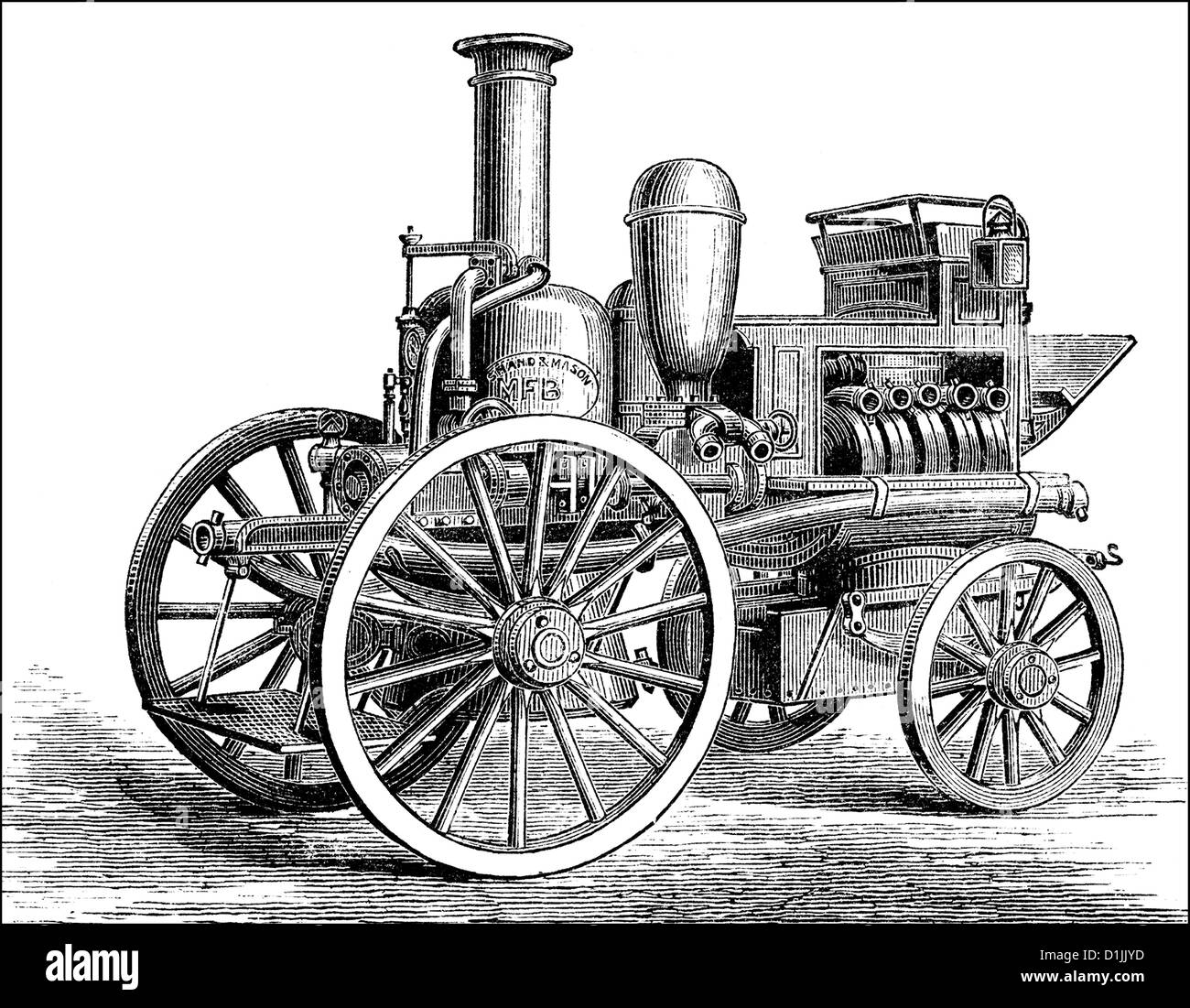 19th century, fire fighting pump, fire brigade of London, steam pump, around 1881, Stock Photohttps://www.alamy.com/image-license-details/?v=1https://www.alamy.com/stock-photo-19th-century-fire-fighting-pump-fire-brigade-of-london-steam-pump-52655777.html
19th century, fire fighting pump, fire brigade of London, steam pump, around 1881, Stock Photohttps://www.alamy.com/image-license-details/?v=1https://www.alamy.com/stock-photo-19th-century-fire-fighting-pump-fire-brigade-of-london-steam-pump-52655777.htmlRMD1JJYD–19th century, fire fighting pump, fire brigade of London, steam pump, around 1881,
 Following a multitude of ad-hoc firefighting arrangements and the Great Fire of London, various insurance companies established firefighting units to tackle fires that occurred in buildings that their respective companies insured. As demands grew the firefighting units began to coordinate and co-operate with each other. In 1833, the London Fire Engine Establishment was formed under the leadership of James Braidwood, who introduced a uniform that, for the first time, included personal protection from the hazards of firefighting. Stock Photohttps://www.alamy.com/image-license-details/?v=1https://www.alamy.com/following-a-multitude-of-ad-hoc-firefighting-arrangements-and-the-great-fire-of-london-various-insurance-companies-established-firefighting-units-to-tackle-fires-that-occurred-in-buildings-that-their-respective-companies-insured-as-demands-grew-the-firefighting-units-began-to-coordinate-and-co-operate-with-each-other-in-1833-the-london-fire-engine-establishment-was-formed-under-the-leadership-of-james-braidwood-who-introduced-a-uniform-that-for-the-first-time-included-personal-protection-from-the-hazards-of-firefighting-image236287287.html
Following a multitude of ad-hoc firefighting arrangements and the Great Fire of London, various insurance companies established firefighting units to tackle fires that occurred in buildings that their respective companies insured. As demands grew the firefighting units began to coordinate and co-operate with each other. In 1833, the London Fire Engine Establishment was formed under the leadership of James Braidwood, who introduced a uniform that, for the first time, included personal protection from the hazards of firefighting. Stock Photohttps://www.alamy.com/image-license-details/?v=1https://www.alamy.com/following-a-multitude-of-ad-hoc-firefighting-arrangements-and-the-great-fire-of-london-various-insurance-companies-established-firefighting-units-to-tackle-fires-that-occurred-in-buildings-that-their-respective-companies-insured-as-demands-grew-the-firefighting-units-began-to-coordinate-and-co-operate-with-each-other-in-1833-the-london-fire-engine-establishment-was-formed-under-the-leadership-of-james-braidwood-who-introduced-a-uniform-that-for-the-first-time-included-personal-protection-from-the-hazards-of-firefighting-image236287287.htmlRMRMBPRK–Following a multitude of ad-hoc firefighting arrangements and the Great Fire of London, various insurance companies established firefighting units to tackle fires that occurred in buildings that their respective companies insured. As demands grew the firefighting units began to coordinate and co-operate with each other. In 1833, the London Fire Engine Establishment was formed under the leadership of James Braidwood, who introduced a uniform that, for the first time, included personal protection from the hazards of firefighting.
 An old engraving of The Palace of Westminster, London, England, UK on fire – the medieval royal palace and home of the British parliament, was largely destroyed on 16 October 1834. It is from a Victorian history book of c.1900. The blaze began in the two furnaces under the House of Lords, which caused a chimney fire in the two flues that ran under the floor of the Lords' chamber and up through the walls. The resulting fire spread rapidly throughout the complex and developed into the largest conflagration in London since the Great Fire of 1666. The event attracted large crowds. Stock Photohttps://www.alamy.com/image-license-details/?v=1https://www.alamy.com/an-old-engraving-of-the-palace-of-westminster-london-england-uk-on-fire-the-medieval-royal-palace-and-home-of-the-british-parliament-was-largely-destroyed-on-16-october-1834-it-is-from-a-victorian-history-book-of-c1900-the-blaze-began-in-the-two-furnaces-under-the-house-of-lords-which-caused-a-chimney-fire-in-the-two-flues-that-ran-under-the-floor-of-the-lords-chamber-and-up-through-the-walls-the-resulting-fire-spread-rapidly-throughout-the-complex-and-developed-into-the-largest-conflagration-in-london-since-the-great-fire-of-1666-the-event-attracted-large-crowds-image635188202.html
An old engraving of The Palace of Westminster, London, England, UK on fire – the medieval royal palace and home of the British parliament, was largely destroyed on 16 October 1834. It is from a Victorian history book of c.1900. The blaze began in the two furnaces under the House of Lords, which caused a chimney fire in the two flues that ran under the floor of the Lords' chamber and up through the walls. The resulting fire spread rapidly throughout the complex and developed into the largest conflagration in London since the Great Fire of 1666. The event attracted large crowds. Stock Photohttps://www.alamy.com/image-license-details/?v=1https://www.alamy.com/an-old-engraving-of-the-palace-of-westminster-london-england-uk-on-fire-the-medieval-royal-palace-and-home-of-the-british-parliament-was-largely-destroyed-on-16-october-1834-it-is-from-a-victorian-history-book-of-c1900-the-blaze-began-in-the-two-furnaces-under-the-house-of-lords-which-caused-a-chimney-fire-in-the-two-flues-that-ran-under-the-floor-of-the-lords-chamber-and-up-through-the-walls-the-resulting-fire-spread-rapidly-throughout-the-complex-and-developed-into-the-largest-conflagration-in-london-since-the-great-fire-of-1666-the-event-attracted-large-crowds-image635188202.htmlRM2YWB90X–An old engraving of The Palace of Westminster, London, England, UK on fire – the medieval royal palace and home of the British parliament, was largely destroyed on 16 October 1834. It is from a Victorian history book of c.1900. The blaze began in the two furnaces under the House of Lords, which caused a chimney fire in the two flues that ran under the floor of the Lords' chamber and up through the walls. The resulting fire spread rapidly throughout the complex and developed into the largest conflagration in London since the Great Fire of 1666. The event attracted large crowds.
 Victorian caricature of Captain Eyre Massey Shaw, the Superintendent of the Metropolitan Fire Brigade, and its predecessor, the London Fire Engine Est Stock Photohttps://www.alamy.com/image-license-details/?v=1https://www.alamy.com/victorian-caricature-of-captain-eyre-massey-shaw-the-superintendent-of-the-metropolitan-fire-brigade-and-its-predecessor-the-london-fire-engine-est-image599091161.html
Victorian caricature of Captain Eyre Massey Shaw, the Superintendent of the Metropolitan Fire Brigade, and its predecessor, the London Fire Engine Est Stock Photohttps://www.alamy.com/image-license-details/?v=1https://www.alamy.com/victorian-caricature-of-captain-eyre-massey-shaw-the-superintendent-of-the-metropolitan-fire-brigade-and-its-predecessor-the-london-fire-engine-est-image599091161.htmlRM2WPJXTW–Victorian caricature of Captain Eyre Massey Shaw, the Superintendent of the Metropolitan Fire Brigade, and its predecessor, the London Fire Engine Est
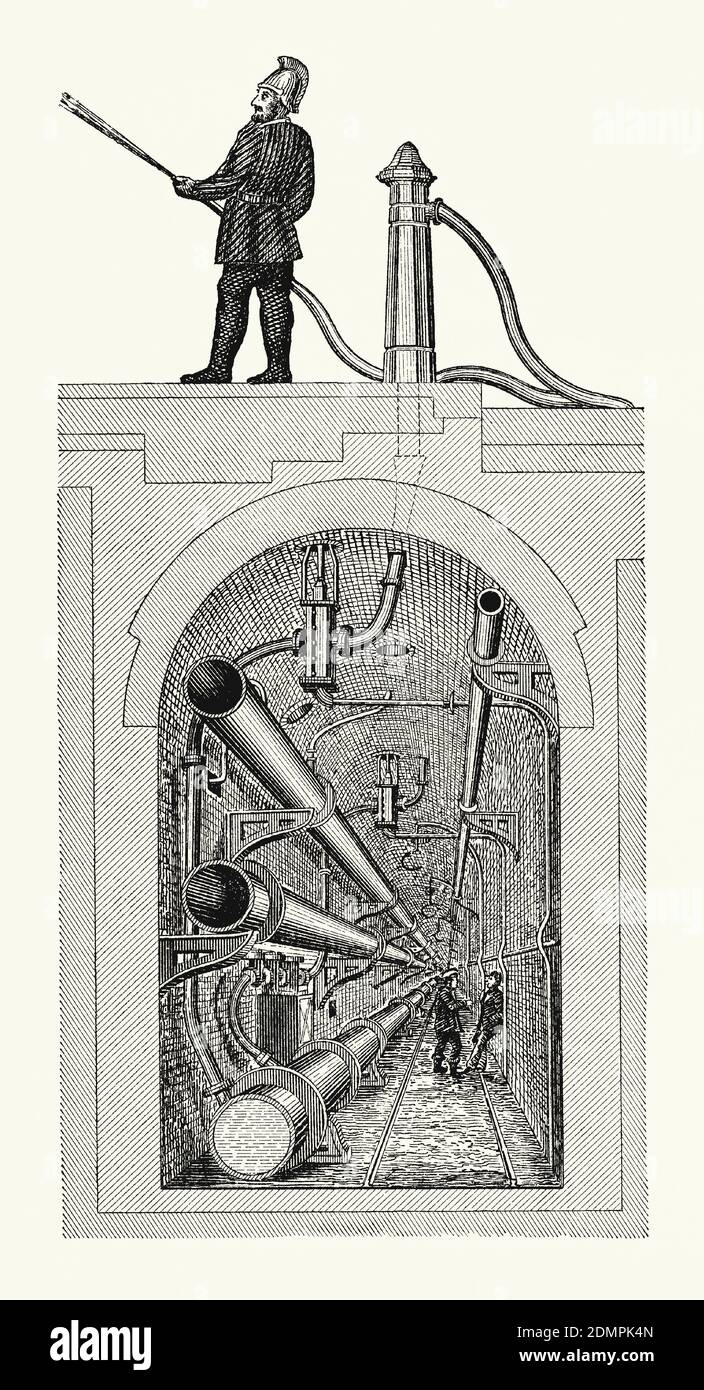 An old engraving of a firefighter using a hose from a hydrant supplied from underground tunnels or subways on Holborn Viaduct, London, England, UK c. 1880. It is from a Victorian mechanical engineering book of the 1880s. Large tunnels like this would also include pipes for gas and sewerage. Early firefighting was done by using buckets. Later horse-drawn fire-pumps were used – operated by hand or steam. When cast-iron pipes allowed a permanent underground water supply in cities, access points were included for the fire fighters. Some systems included fixed above-ground hydrants. Stock Photohttps://www.alamy.com/image-license-details/?v=1https://www.alamy.com/an-old-engraving-of-a-firefighter-using-a-hose-from-a-hydrant-supplied-from-underground-tunnels-or-subways-on-holborn-viaduct-london-england-uk-c-1880-it-is-from-a-victorian-mechanical-engineering-book-of-the-1880s-large-tunnels-like-this-would-also-include-pipes-for-gas-and-sewerage-early-firefighting-was-done-by-using-buckets-later-horse-drawn-fire-pumps-were-used-operated-by-hand-or-steam-when-cast-iron-pipes-allowed-a-permanent-underground-water-supply-in-cities-access-points-were-included-for-the-fire-fighters-some-systems-included-fixed-above-ground-hydrants-image391419189.html
An old engraving of a firefighter using a hose from a hydrant supplied from underground tunnels or subways on Holborn Viaduct, London, England, UK c. 1880. It is from a Victorian mechanical engineering book of the 1880s. Large tunnels like this would also include pipes for gas and sewerage. Early firefighting was done by using buckets. Later horse-drawn fire-pumps were used – operated by hand or steam. When cast-iron pipes allowed a permanent underground water supply in cities, access points were included for the fire fighters. Some systems included fixed above-ground hydrants. Stock Photohttps://www.alamy.com/image-license-details/?v=1https://www.alamy.com/an-old-engraving-of-a-firefighter-using-a-hose-from-a-hydrant-supplied-from-underground-tunnels-or-subways-on-holborn-viaduct-london-england-uk-c-1880-it-is-from-a-victorian-mechanical-engineering-book-of-the-1880s-large-tunnels-like-this-would-also-include-pipes-for-gas-and-sewerage-early-firefighting-was-done-by-using-buckets-later-horse-drawn-fire-pumps-were-used-operated-by-hand-or-steam-when-cast-iron-pipes-allowed-a-permanent-underground-water-supply-in-cities-access-points-were-included-for-the-fire-fighters-some-systems-included-fixed-above-ground-hydrants-image391419189.htmlRM2DMPK4N–An old engraving of a firefighter using a hose from a hydrant supplied from underground tunnels or subways on Holborn Viaduct, London, England, UK c. 1880. It is from a Victorian mechanical engineering book of the 1880s. Large tunnels like this would also include pipes for gas and sewerage. Early firefighting was done by using buckets. Later horse-drawn fire-pumps were used – operated by hand or steam. When cast-iron pipes allowed a permanent underground water supply in cities, access points were included for the fire fighters. Some systems included fixed above-ground hydrants.
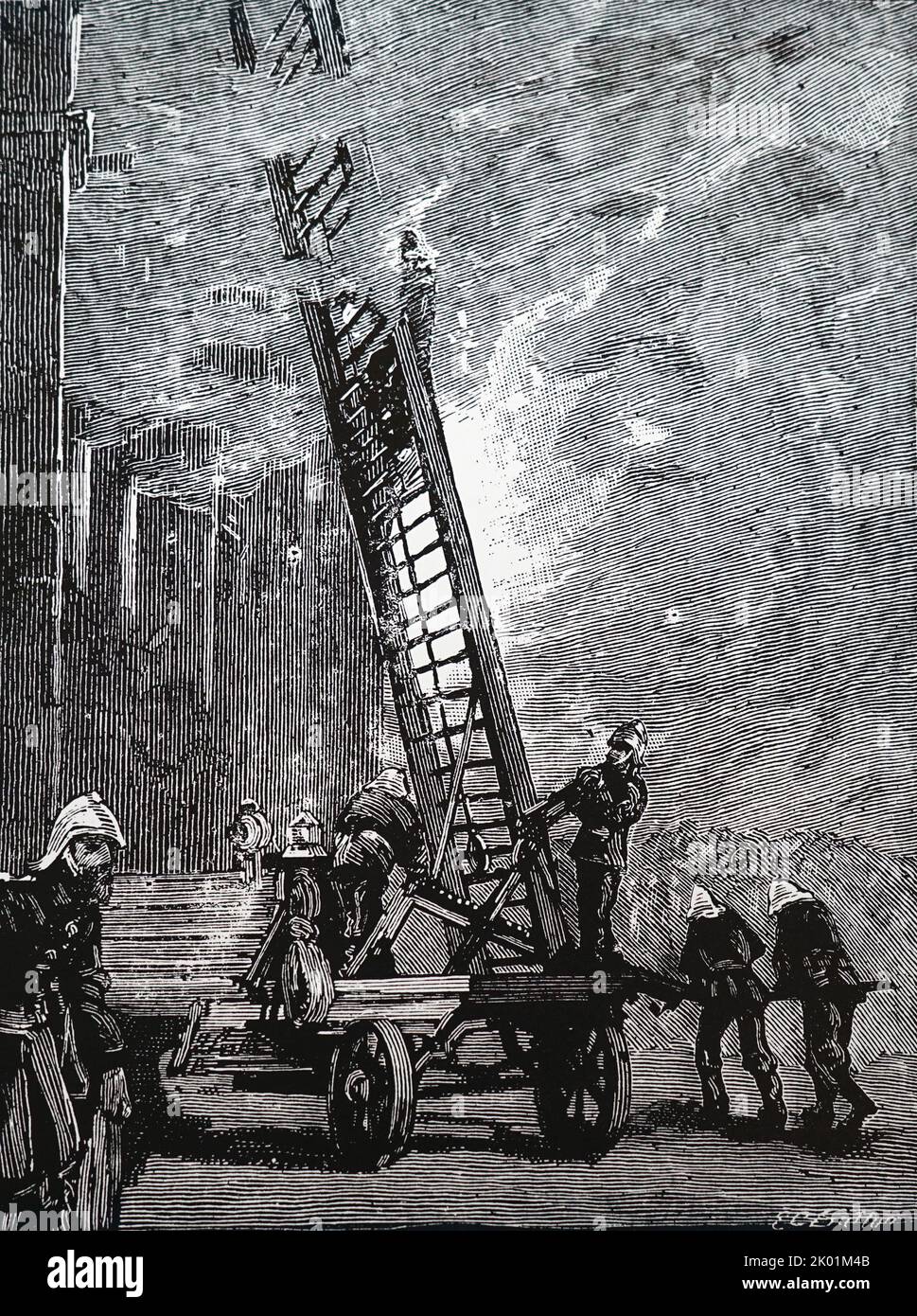 Members of the London Fire Brigade using the newly introduced fire ladder truck. Stock Photohttps://www.alamy.com/image-license-details/?v=1https://www.alamy.com/members-of-the-london-fire-brigade-using-the-newly-introduced-fire-ladder-truck-image481928059.html
Members of the London Fire Brigade using the newly introduced fire ladder truck. Stock Photohttps://www.alamy.com/image-license-details/?v=1https://www.alamy.com/members-of-the-london-fire-brigade-using-the-newly-introduced-fire-ladder-truck-image481928059.htmlRM2K01M4B–Members of the London Fire Brigade using the newly introduced fire ladder truck.
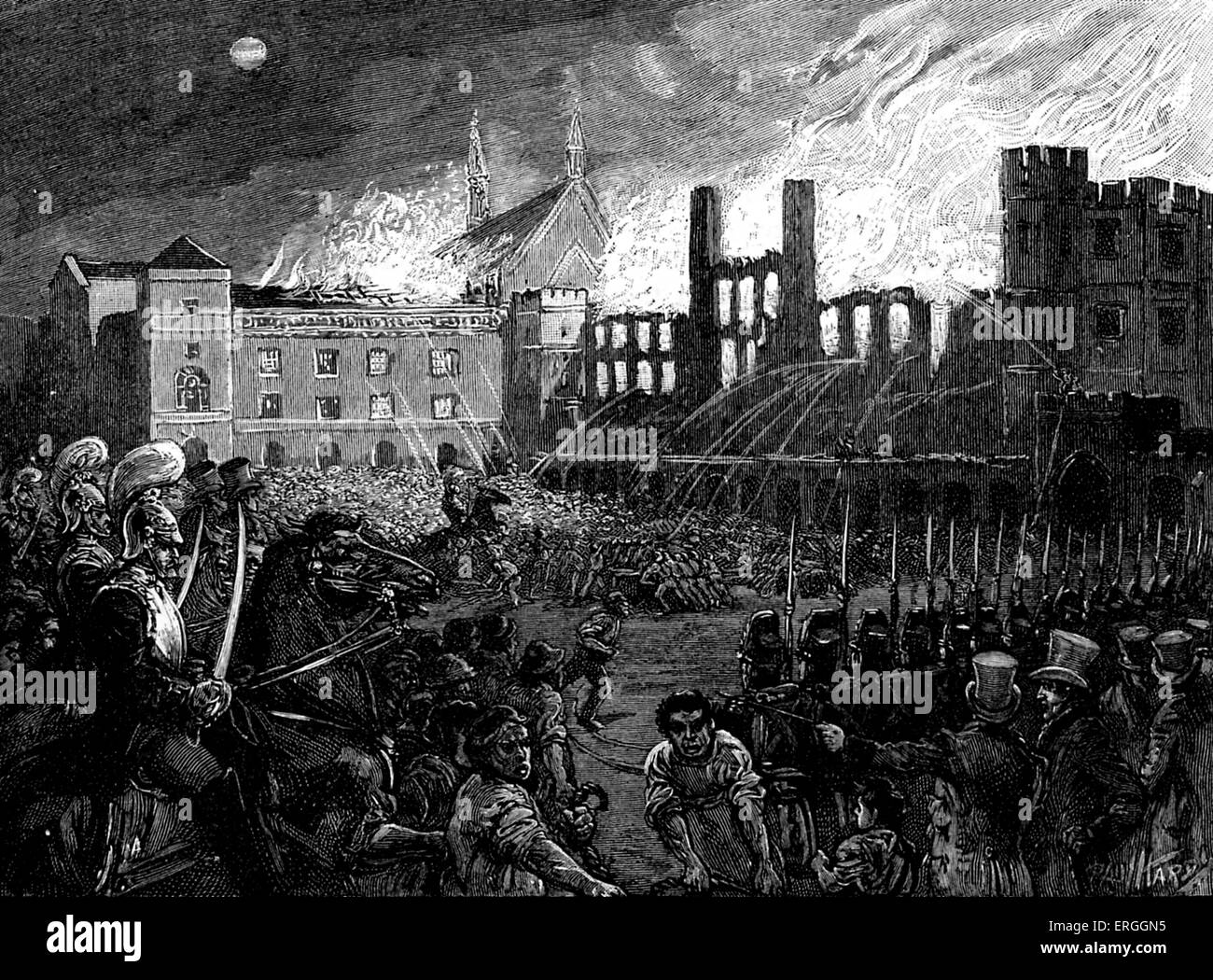 Burning of Parliament, 16 October 1834. Fire which destroyed the Palace of Westminster (Houses of Parliament). Stock Photohttps://www.alamy.com/image-license-details/?v=1https://www.alamy.com/stock-photo-burning-of-parliament-16-october-1834-fire-which-destroyed-the-palace-83342929.html
Burning of Parliament, 16 October 1834. Fire which destroyed the Palace of Westminster (Houses of Parliament). Stock Photohttps://www.alamy.com/image-license-details/?v=1https://www.alamy.com/stock-photo-burning-of-parliament-16-october-1834-fire-which-destroyed-the-palace-83342929.htmlRMERGGN5–Burning of Parliament, 16 October 1834. Fire which destroyed the Palace of Westminster (Houses of Parliament).
 Victorian advert for Merryweather's London Brigade Fire Pump. 1896 Stock Photohttps://www.alamy.com/image-license-details/?v=1https://www.alamy.com/stock-photo-victorian-advert-for-merryweathers-london-brigade-fire-pump-1896-124886566.html
Victorian advert for Merryweather's London Brigade Fire Pump. 1896 Stock Photohttps://www.alamy.com/image-license-details/?v=1https://www.alamy.com/stock-photo-victorian-advert-for-merryweathers-london-brigade-fire-pump-1896-124886566.htmlRMH7522E–Victorian advert for Merryweather's London Brigade Fire Pump. 1896
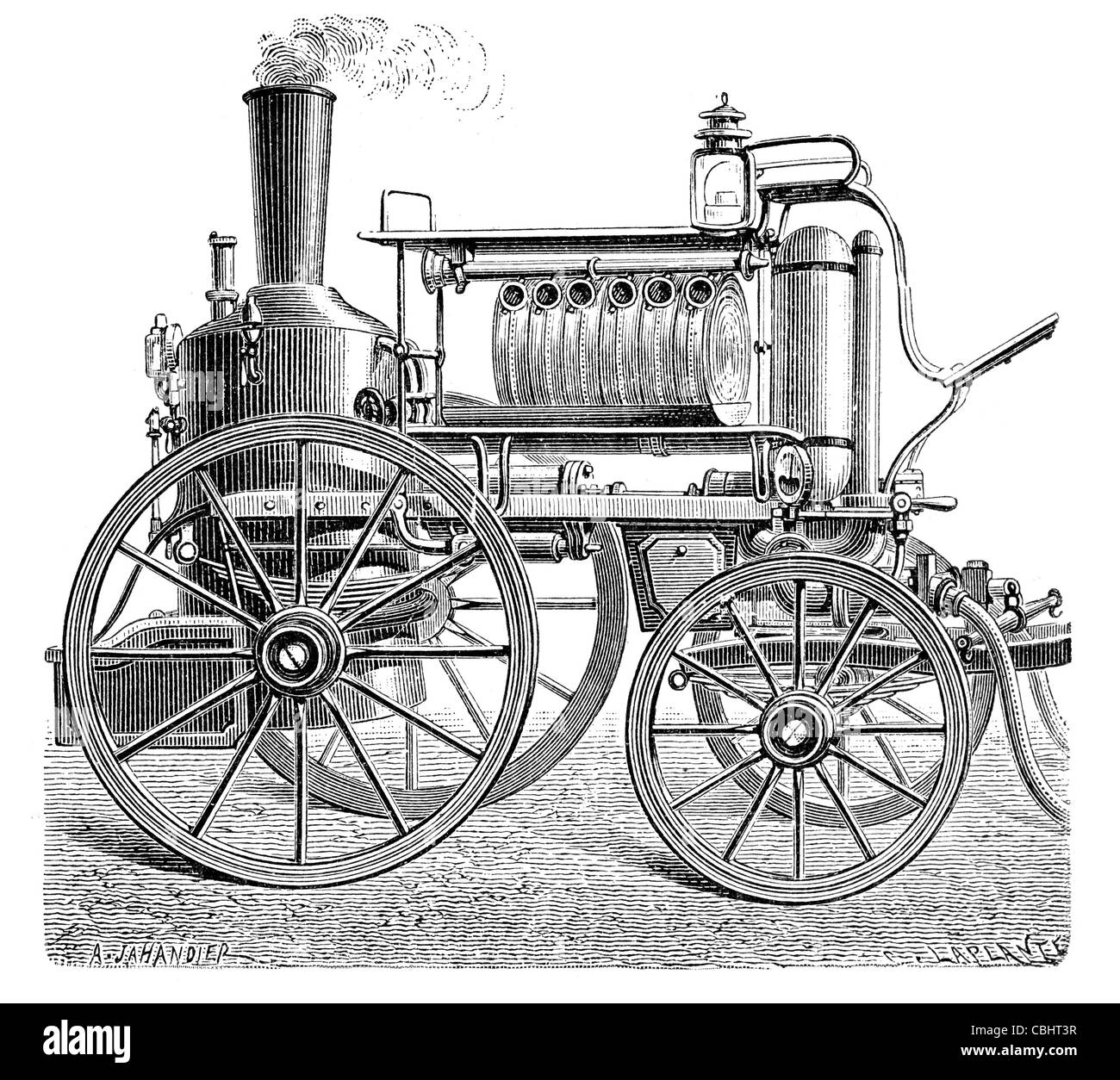 Fire pump vapor Meryweather M. fire engine brigade service rescue hose fireman firemen Stock Photohttps://www.alamy.com/image-license-details/?v=1https://www.alamy.com/stock-photo-fire-pump-vapor-meryweather-m-fire-engine-brigade-service-rescue-hose-41574059.html
Fire pump vapor Meryweather M. fire engine brigade service rescue hose fireman firemen Stock Photohttps://www.alamy.com/image-license-details/?v=1https://www.alamy.com/stock-photo-fire-pump-vapor-meryweather-m-fire-engine-brigade-service-rescue-hose-41574059.htmlRMCBHT3R–Fire pump vapor Meryweather M. fire engine brigade service rescue hose fireman firemen
 Remains of the Pavilion Theatre, after the Fire, 1856. Theatre in east London. '...the firemen went to work in an admirable manner; and, by conveying the hose through the different entrances to the theatre...the brigade were enabled to throw the water in the right direction; but, notwithstanding, the work of devastation continued, and in less than half an hour after the first appearance of the fire the flames had seized upon the pit, and also the boxes and proscenium. To stop the fire at those places the firemen exerted themselves to the utmost, but, unfortunately, without the least success... Stock Photohttps://www.alamy.com/image-license-details/?v=1https://www.alamy.com/remains-of-the-pavilion-theatre-after-the-fire-1856-theatre-in-east-london-the-firemen-went-to-work-in-an-admirable-manner-and-by-conveying-the-hose-through-the-different-entrances-to-the-theatrethe-brigade-were-enabled-to-throw-the-water-in-the-right-direction-but-notwithstanding-the-work-of-devastation-continued-and-in-less-than-half-an-hour-after-the-first-appearance-of-the-fire-the-flames-had-seized-upon-the-pit-and-also-the-boxes-and-proscenium-to-stop-the-fire-at-those-places-the-firemen-exerted-themselves-to-the-utmost-but-unfortunately-without-the-least-success-image553490256.html
Remains of the Pavilion Theatre, after the Fire, 1856. Theatre in east London. '...the firemen went to work in an admirable manner; and, by conveying the hose through the different entrances to the theatre...the brigade were enabled to throw the water in the right direction; but, notwithstanding, the work of devastation continued, and in less than half an hour after the first appearance of the fire the flames had seized upon the pit, and also the boxes and proscenium. To stop the fire at those places the firemen exerted themselves to the utmost, but, unfortunately, without the least success... Stock Photohttps://www.alamy.com/image-license-details/?v=1https://www.alamy.com/remains-of-the-pavilion-theatre-after-the-fire-1856-theatre-in-east-london-the-firemen-went-to-work-in-an-admirable-manner-and-by-conveying-the-hose-through-the-different-entrances-to-the-theatrethe-brigade-were-enabled-to-throw-the-water-in-the-right-direction-but-notwithstanding-the-work-of-devastation-continued-and-in-less-than-half-an-hour-after-the-first-appearance-of-the-fire-the-flames-had-seized-upon-the-pit-and-also-the-boxes-and-proscenium-to-stop-the-fire-at-those-places-the-firemen-exerted-themselves-to-the-utmost-but-unfortunately-without-the-least-success-image553490256.htmlRM2R4DJD4–Remains of the Pavilion Theatre, after the Fire, 1856. Theatre in east London. '...the firemen went to work in an admirable manner; and, by conveying the hose through the different entrances to the theatre...the brigade were enabled to throw the water in the right direction; but, notwithstanding, the work of devastation continued, and in less than half an hour after the first appearance of the fire the flames had seized upon the pit, and also the boxes and proscenium. To stop the fire at those places the firemen exerted themselves to the utmost, but, unfortunately, without the least success...
 The Awful Destruction of the Royal Exchange (2nd) fire, London, 1838. Artist: W Clerk Stock Photohttps://www.alamy.com/image-license-details/?v=1https://www.alamy.com/the-awful-destruction-of-the-royal-exchange-2nd-fire-london-1838-artist-image60083507.html
The Awful Destruction of the Royal Exchange (2nd) fire, London, 1838. Artist: W Clerk Stock Photohttps://www.alamy.com/image-license-details/?v=1https://www.alamy.com/the-awful-destruction-of-the-royal-exchange-2nd-fire-london-1838-artist-image60083507.htmlRMDDN13F–The Awful Destruction of the Royal Exchange (2nd) fire, London, 1838. Artist: W Clerk
 LONDON: Southwark Street- HQ of Metropolitan Fire Brigade, antique print 1896 Stock Photohttps://www.alamy.com/image-license-details/?v=1https://www.alamy.com/stock-photo-london-southwark-street-hq-of-metropolitan-fire-brigade-antique-print-94438671.html
LONDON: Southwark Street- HQ of Metropolitan Fire Brigade, antique print 1896 Stock Photohttps://www.alamy.com/image-license-details/?v=1https://www.alamy.com/stock-photo-london-southwark-street-hq-of-metropolitan-fire-brigade-antique-print-94438671.htmlRMFDJ1DK–LONDON: Southwark Street- HQ of Metropolitan Fire Brigade, antique print 1896
 Steam fire-engine going to a riverside fire, London fire brigade, 1890.Artist: WB Murray Stock Photohttps://www.alamy.com/image-license-details/?v=1https://www.alamy.com/steam-fire-engine-going-to-a-riverside-fire-london-fire-brigade-1890artist-wb-murray-image262748143.html
Steam fire-engine going to a riverside fire, London fire brigade, 1890.Artist: WB Murray Stock Photohttps://www.alamy.com/image-license-details/?v=1https://www.alamy.com/steam-fire-engine-going-to-a-riverside-fire-london-fire-brigade-1890artist-wb-murray-image262748143.htmlRMW7D5X7–Steam fire-engine going to a riverside fire, London fire brigade, 1890.Artist: WB Murray
 Fire at the Olympic Theatre, Wych Street, Westminster, London, 1849. Artist: J Maund Stock Photohttps://www.alamy.com/image-license-details/?v=1https://www.alamy.com/stock-photo-fire-at-the-olympic-theatre-wych-street-westminster-london-1849-artist-28168002.html
Fire at the Olympic Theatre, Wych Street, Westminster, London, 1849. Artist: J Maund Stock Photohttps://www.alamy.com/image-license-details/?v=1https://www.alamy.com/stock-photo-fire-at-the-olympic-theatre-wych-street-westminster-london-1849-artist-28168002.htmlRMBHR4G2–Fire at the Olympic Theatre, Wych Street, Westminster, London, 1849. Artist: J Maund
 The Fire at the Vauxhall Railway Station, seen from Millbank, 1856. 'The moment the plugs of the Lambeth, Vauxhall, and Southwark Companies' mains were drawn, a sufficient supply of water was obtained to set the engines of Price's candleworks, and Messrs. Burnett and Hodges' distillery to work, as well as that of the West of England office, and many of the London Brigade. The station, however, standing upon the top of the line, and being built of wood, and the wind blowing stiffly off the River Thames, the conflagration continued to extend, and at length attacked the houses on the south side o Stock Photohttps://www.alamy.com/image-license-details/?v=1https://www.alamy.com/the-fire-at-the-vauxhall-railway-station-seen-from-millbank-1856-the-moment-the-plugs-of-the-lambeth-vauxhall-and-southwark-companies-mains-were-drawn-a-sufficient-supply-of-water-was-obtained-to-set-the-engines-of-prices-candleworks-and-messrs-burnett-and-hodges-distillery-to-work-as-well-as-that-of-the-west-of-england-office-and-many-of-the-london-brigade-the-station-however-standing-upon-the-top-of-the-line-and-being-built-of-wood-and-the-wind-blowing-stiffly-off-the-river-thames-the-conflagration-continued-to-extend-and-at-length-attacked-the-houses-on-the-south-side-o-image553489949.html
The Fire at the Vauxhall Railway Station, seen from Millbank, 1856. 'The moment the plugs of the Lambeth, Vauxhall, and Southwark Companies' mains were drawn, a sufficient supply of water was obtained to set the engines of Price's candleworks, and Messrs. Burnett and Hodges' distillery to work, as well as that of the West of England office, and many of the London Brigade. The station, however, standing upon the top of the line, and being built of wood, and the wind blowing stiffly off the River Thames, the conflagration continued to extend, and at length attacked the houses on the south side o Stock Photohttps://www.alamy.com/image-license-details/?v=1https://www.alamy.com/the-fire-at-the-vauxhall-railway-station-seen-from-millbank-1856-the-moment-the-plugs-of-the-lambeth-vauxhall-and-southwark-companies-mains-were-drawn-a-sufficient-supply-of-water-was-obtained-to-set-the-engines-of-prices-candleworks-and-messrs-burnett-and-hodges-distillery-to-work-as-well-as-that-of-the-west-of-england-office-and-many-of-the-london-brigade-the-station-however-standing-upon-the-top-of-the-line-and-being-built-of-wood-and-the-wind-blowing-stiffly-off-the-river-thames-the-conflagration-continued-to-extend-and-at-length-attacked-the-houses-on-the-south-side-o-image553489949.htmlRM2R4DJ25–The Fire at the Vauxhall Railway Station, seen from Millbank, 1856. 'The moment the plugs of the Lambeth, Vauxhall, and Southwark Companies' mains were drawn, a sufficient supply of water was obtained to set the engines of Price's candleworks, and Messrs. Burnett and Hodges' distillery to work, as well as that of the West of England office, and many of the London Brigade. The station, however, standing upon the top of the line, and being built of wood, and the wind blowing stiffly off the River Thames, the conflagration continued to extend, and at length attacked the houses on the south side o
 Firemen fighting the blaze at the Cotton's Wharf Fire, Bermondsey, London, 1861. Artist: Anon Stock Photohttps://www.alamy.com/image-license-details/?v=1https://www.alamy.com/firemen-fighting-the-blaze-at-the-cottons-wharf-fire-bermondsey-london-image60084562.html
Firemen fighting the blaze at the Cotton's Wharf Fire, Bermondsey, London, 1861. Artist: Anon Stock Photohttps://www.alamy.com/image-license-details/?v=1https://www.alamy.com/firemen-fighting-the-blaze-at-the-cottons-wharf-fire-bermondsey-london-image60084562.htmlRMDDN2D6–Firemen fighting the blaze at the Cotton's Wharf Fire, Bermondsey, London, 1861. Artist: Anon
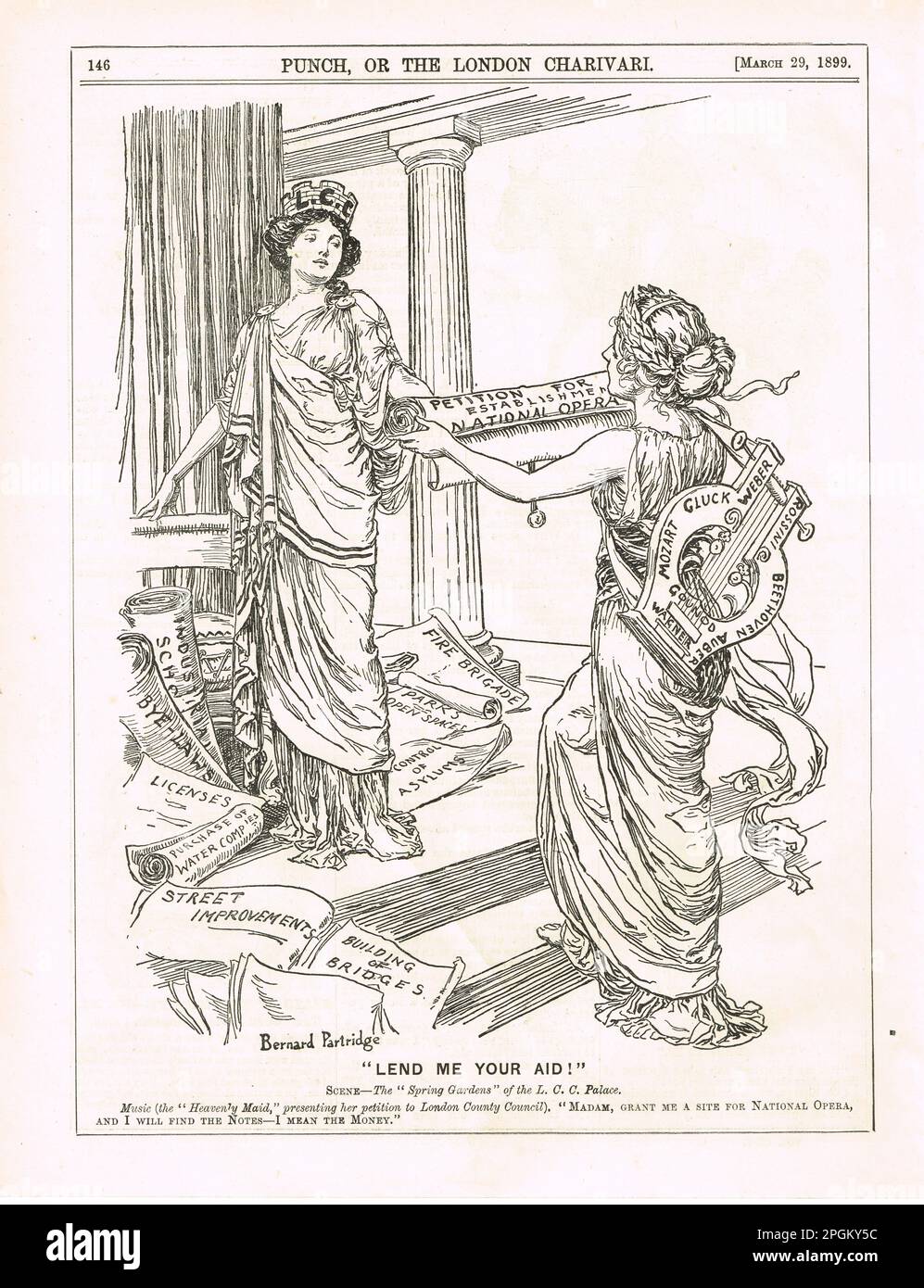 Punch Cartoon from 1899 by Bernard Partridge portraying the difficult choices in public spending by the LCC. Entitled Lend me your aid it shows music as the heavenly maid presenting a petition for the establishment of a national opera house to the LCC. It shows all the other calls on the public purse like bridge building, parks, fire brigade etc. Stock Photohttps://www.alamy.com/image-license-details/?v=1https://www.alamy.com/punch-cartoon-from-1899-by-bernard-partridge-portraying-the-difficult-choices-in-public-spending-by-the-lcc-entitled-lend-me-your-aid-it-shows-music-as-the-heavenly-maid-presenting-a-petition-for-the-establishment-of-a-national-opera-house-to-the-lcc-it-shows-all-the-other-calls-on-the-public-purse-like-bridge-building-parks-fire-brigade-etc-image543794312.html
Punch Cartoon from 1899 by Bernard Partridge portraying the difficult choices in public spending by the LCC. Entitled Lend me your aid it shows music as the heavenly maid presenting a petition for the establishment of a national opera house to the LCC. It shows all the other calls on the public purse like bridge building, parks, fire brigade etc. Stock Photohttps://www.alamy.com/image-license-details/?v=1https://www.alamy.com/punch-cartoon-from-1899-by-bernard-partridge-portraying-the-difficult-choices-in-public-spending-by-the-lcc-entitled-lend-me-your-aid-it-shows-music-as-the-heavenly-maid-presenting-a-petition-for-the-establishment-of-a-national-opera-house-to-the-lcc-it-shows-all-the-other-calls-on-the-public-purse-like-bridge-building-parks-fire-brigade-etc-image543794312.htmlRM2PGKY5C–Punch Cartoon from 1899 by Bernard Partridge portraying the difficult choices in public spending by the LCC. Entitled Lend me your aid it shows music as the heavenly maid presenting a petition for the establishment of a national opera house to the LCC. It shows all the other calls on the public purse like bridge building, parks, fire brigade etc.
 Print; coloured aquatint and etching - Fire in London. Date/Period: 1808. Paintings, Prints and Drawings. Author: ROWLANDSON, THOMAS. BLUCK, J.Pugin, A. C.ACKERMANN, RUDOLPH. PYNE, WILLIAM HENRY. Pugin, A. C. Stock Photohttps://www.alamy.com/image-license-details/?v=1https://www.alamy.com/print-coloured-aquatint-and-etching-fire-in-london-dateperiod-1808-paintings-prints-and-drawings-author-rowlandson-thomas-bluck-jpugin-a-cackermann-rudolph-pyne-william-henry-pugin-a-c-image225855983.html
Print; coloured aquatint and etching - Fire in London. Date/Period: 1808. Paintings, Prints and Drawings. Author: ROWLANDSON, THOMAS. BLUCK, J.Pugin, A. C.ACKERMANN, RUDOLPH. PYNE, WILLIAM HENRY. Pugin, A. C. Stock Photohttps://www.alamy.com/image-license-details/?v=1https://www.alamy.com/print-coloured-aquatint-and-etching-fire-in-london-dateperiod-1808-paintings-prints-and-drawings-author-rowlandson-thomas-bluck-jpugin-a-cackermann-rudolph-pyne-william-henry-pugin-a-c-image225855983.htmlRMR3CHH3–Print; coloured aquatint and etching - Fire in London. Date/Period: 1808. Paintings, Prints and Drawings. Author: ROWLANDSON, THOMAS. BLUCK, J.Pugin, A. C.ACKERMANN, RUDOLPH. PYNE, WILLIAM HENRY. Pugin, A. C.
 Fire Brigade Competition at the Alexandra Palace, London, Engraving 1876, UK, Britain, British, Europe, United Kingdom, Great Britain, European Stock Photohttps://www.alamy.com/image-license-details/?v=1https://www.alamy.com/fire-brigade-competition-at-the-alexandra-palace-london-engraving-1876-uk-britain-british-europe-united-kingdom-great-britain-european-image240635060.html
Fire Brigade Competition at the Alexandra Palace, London, Engraving 1876, UK, Britain, British, Europe, United Kingdom, Great Britain, European Stock Photohttps://www.alamy.com/image-license-details/?v=1https://www.alamy.com/fire-brigade-competition-at-the-alexandra-palace-london-engraving-1876-uk-britain-british-europe-united-kingdom-great-britain-european-image240635060.htmlRMRYDTD8–Fire Brigade Competition at the Alexandra Palace, London, Engraving 1876, UK, Britain, British, Europe, United Kingdom, Great Britain, European
 technical equipment , a portrait of Captain Sir Eyre Massey Shaw, KCB, 1830 - 1908, chief of the fire brigade of London England Stock Photohttps://www.alamy.com/image-license-details/?v=1https://www.alamy.com/stock-photo-technical-equipment-a-portrait-of-captain-sir-eyre-massey-shaw-kcb-52655791.html
technical equipment , a portrait of Captain Sir Eyre Massey Shaw, KCB, 1830 - 1908, chief of the fire brigade of London England Stock Photohttps://www.alamy.com/image-license-details/?v=1https://www.alamy.com/stock-photo-technical-equipment-a-portrait-of-captain-sir-eyre-massey-shaw-kcb-52655791.htmlRMD1JJYY–technical equipment , a portrait of Captain Sir Eyre Massey Shaw, KCB, 1830 - 1908, chief of the fire brigade of London England
 Following a multitude of ad-hoc firefighting arrangements and the Great Fire of London, various insurance companies established firefighting units to tackle fires that occurred in buildings that their respective companies insured. As demands grew on the primitive firefighting units they began to coordinate and co-operate with each other until, on 1 January 1833, the London Fire Engine Establishment was formed under the leadership of James Braidwood; one mode of fire fighting was the barge-like ship moored in the River Thames. Stock Photohttps://www.alamy.com/image-license-details/?v=1https://www.alamy.com/following-a-multitude-of-ad-hoc-firefighting-arrangements-and-the-great-fire-of-london-various-insurance-companies-established-firefighting-units-to-tackle-fires-that-occurred-in-buildings-that-their-respective-companies-insured-as-demands-grew-on-the-primitive-firefighting-units-they-began-to-coordinate-and-co-operate-with-each-other-until-on-1-january-1833-the-london-fire-engine-establishment-was-formed-under-the-leadership-of-james-braidwood-one-mode-of-fire-fighting-was-the-barge-like-ship-moored-in-the-river-thames-image236287236.html
Following a multitude of ad-hoc firefighting arrangements and the Great Fire of London, various insurance companies established firefighting units to tackle fires that occurred in buildings that their respective companies insured. As demands grew on the primitive firefighting units they began to coordinate and co-operate with each other until, on 1 January 1833, the London Fire Engine Establishment was formed under the leadership of James Braidwood; one mode of fire fighting was the barge-like ship moored in the River Thames. Stock Photohttps://www.alamy.com/image-license-details/?v=1https://www.alamy.com/following-a-multitude-of-ad-hoc-firefighting-arrangements-and-the-great-fire-of-london-various-insurance-companies-established-firefighting-units-to-tackle-fires-that-occurred-in-buildings-that-their-respective-companies-insured-as-demands-grew-on-the-primitive-firefighting-units-they-began-to-coordinate-and-co-operate-with-each-other-until-on-1-january-1833-the-london-fire-engine-establishment-was-formed-under-the-leadership-of-james-braidwood-one-mode-of-fire-fighting-was-the-barge-like-ship-moored-in-the-river-thames-image236287236.htmlRMRMBPNT–Following a multitude of ad-hoc firefighting arrangements and the Great Fire of London, various insurance companies established firefighting units to tackle fires that occurred in buildings that their respective companies insured. As demands grew on the primitive firefighting units they began to coordinate and co-operate with each other until, on 1 January 1833, the London Fire Engine Establishment was formed under the leadership of James Braidwood; one mode of fire fighting was the barge-like ship moored in the River Thames.
 James Braidwood Superintendent of the London Fire Engine Establishment James Braidwood (1800 - 1861) founded the world's first municipal fire service in Edinburgh in 1824, and was the first director of the London Fire Engine Establishment (the brigade which was eventually to become the London Fire Brigade) He is credited with the development of the modern municipal fire service Stock Photohttps://www.alamy.com/image-license-details/?v=1https://www.alamy.com/james-braidwood-superintendent-of-the-london-fire-engine-establishment-james-braidwood-1800-1861-founded-the-worlds-first-municipal-fire-service-in-edinburgh-in-1824-and-was-the-first-director-of-the-london-fire-engine-establishment-the-brigade-which-was-eventually-to-become-the-london-fire-brigade-he-is-credited-with-the-development-of-the-modern-municipal-fire-service-image623904707.html
James Braidwood Superintendent of the London Fire Engine Establishment James Braidwood (1800 - 1861) founded the world's first municipal fire service in Edinburgh in 1824, and was the first director of the London Fire Engine Establishment (the brigade which was eventually to become the London Fire Brigade) He is credited with the development of the modern municipal fire service Stock Photohttps://www.alamy.com/image-license-details/?v=1https://www.alamy.com/james-braidwood-superintendent-of-the-london-fire-engine-establishment-james-braidwood-1800-1861-founded-the-worlds-first-municipal-fire-service-in-edinburgh-in-1824-and-was-the-first-director-of-the-london-fire-engine-establishment-the-brigade-which-was-eventually-to-become-the-london-fire-brigade-he-is-credited-with-the-development-of-the-modern-municipal-fire-service-image623904707.htmlRM2Y718PY–James Braidwood Superintendent of the London Fire Engine Establishment James Braidwood (1800 - 1861) founded the world's first municipal fire service in Edinburgh in 1824, and was the first director of the London Fire Engine Establishment (the brigade which was eventually to become the London Fire Brigade) He is credited with the development of the modern municipal fire service
 Burning of Covent Garden Theatre, 1856 (1897). Artist: Unknown. Stock Photohttps://www.alamy.com/image-license-details/?v=1https://www.alamy.com/stock-photo-burning-of-covent-garden-theatre-1856-1897-artist-unknown-135270096.html
Burning of Covent Garden Theatre, 1856 (1897). Artist: Unknown. Stock Photohttps://www.alamy.com/image-license-details/?v=1https://www.alamy.com/stock-photo-burning-of-covent-garden-theatre-1856-1897-artist-unknown-135270096.htmlRMHT22AT–Burning of Covent Garden Theatre, 1856 (1897). Artist: Unknown.
 The funeral of James Braidwood , the late chief of the London Fire Brigade in Abney park cemetery . 1861 Superintendent of the London Fire Engine Establishment James Braidwood (1800 - 1861) founded the world's first municipal fire service in Edinburgh in 1824, and was the first director of the London Fire Engine Establishment (the brigade which was eventually to become the London Fire Brigade) He is credited with the development of the modern municipal fire service Stock Photohttps://www.alamy.com/image-license-details/?v=1https://www.alamy.com/the-funeral-of-james-braidwood-the-late-chief-of-the-london-fire-brigade-in-abney-park-cemetery-1861-superintendent-of-the-london-fire-engine-establishment-james-braidwood-1800-1861-founded-the-worlds-first-municipal-fire-service-in-edinburgh-in-1824-and-was-the-first-director-of-the-london-fire-engine-establishment-the-brigade-which-was-eventually-to-become-the-london-fire-brigade-he-is-credited-with-the-development-of-the-modern-municipal-fire-service-image623904716.html
The funeral of James Braidwood , the late chief of the London Fire Brigade in Abney park cemetery . 1861 Superintendent of the London Fire Engine Establishment James Braidwood (1800 - 1861) founded the world's first municipal fire service in Edinburgh in 1824, and was the first director of the London Fire Engine Establishment (the brigade which was eventually to become the London Fire Brigade) He is credited with the development of the modern municipal fire service Stock Photohttps://www.alamy.com/image-license-details/?v=1https://www.alamy.com/the-funeral-of-james-braidwood-the-late-chief-of-the-london-fire-brigade-in-abney-park-cemetery-1861-superintendent-of-the-london-fire-engine-establishment-james-braidwood-1800-1861-founded-the-worlds-first-municipal-fire-service-in-edinburgh-in-1824-and-was-the-first-director-of-the-london-fire-engine-establishment-the-brigade-which-was-eventually-to-become-the-london-fire-brigade-he-is-credited-with-the-development-of-the-modern-municipal-fire-service-image623904716.htmlRM2Y718R8–The funeral of James Braidwood , the late chief of the London Fire Brigade in Abney park cemetery . 1861 Superintendent of the London Fire Engine Establishment James Braidwood (1800 - 1861) founded the world's first municipal fire service in Edinburgh in 1824, and was the first director of the London Fire Engine Establishment (the brigade which was eventually to become the London Fire Brigade) He is credited with the development of the modern municipal fire service
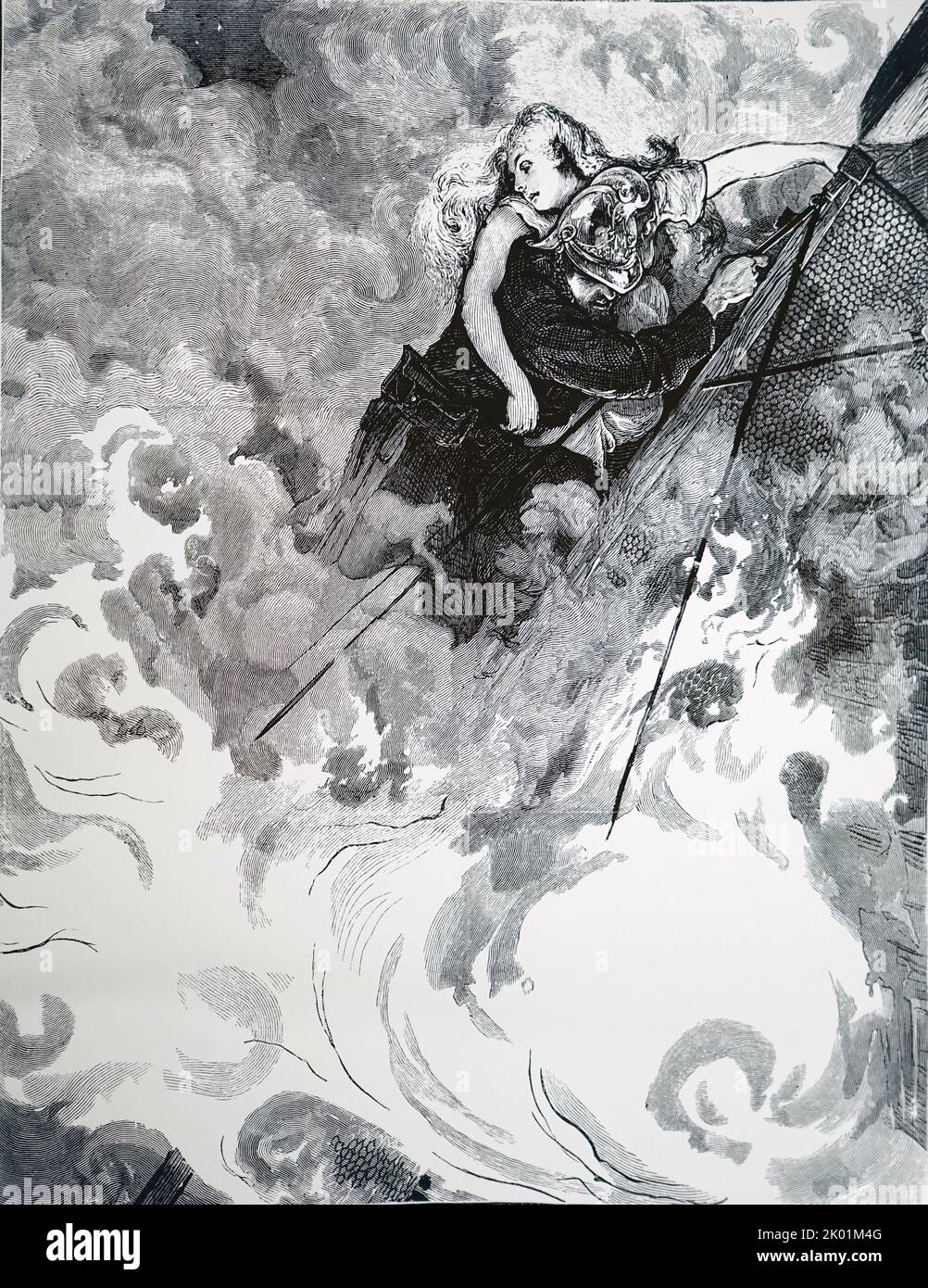 Joseph Ford of the London Fire Brigade making his sixth rescue from a burning building in Gray's Inn Road, London. Stock Photohttps://www.alamy.com/image-license-details/?v=1https://www.alamy.com/joseph-ford-of-the-london-fire-brigade-making-his-sixth-rescue-from-a-burning-building-in-grays-inn-road-london-image481928064.html
Joseph Ford of the London Fire Brigade making his sixth rescue from a burning building in Gray's Inn Road, London. Stock Photohttps://www.alamy.com/image-license-details/?v=1https://www.alamy.com/joseph-ford-of-the-london-fire-brigade-making-his-sixth-rescue-from-a-burning-building-in-grays-inn-road-london-image481928064.htmlRM2K01M4G–Joseph Ford of the London Fire Brigade making his sixth rescue from a burning building in Gray's Inn Road, London.
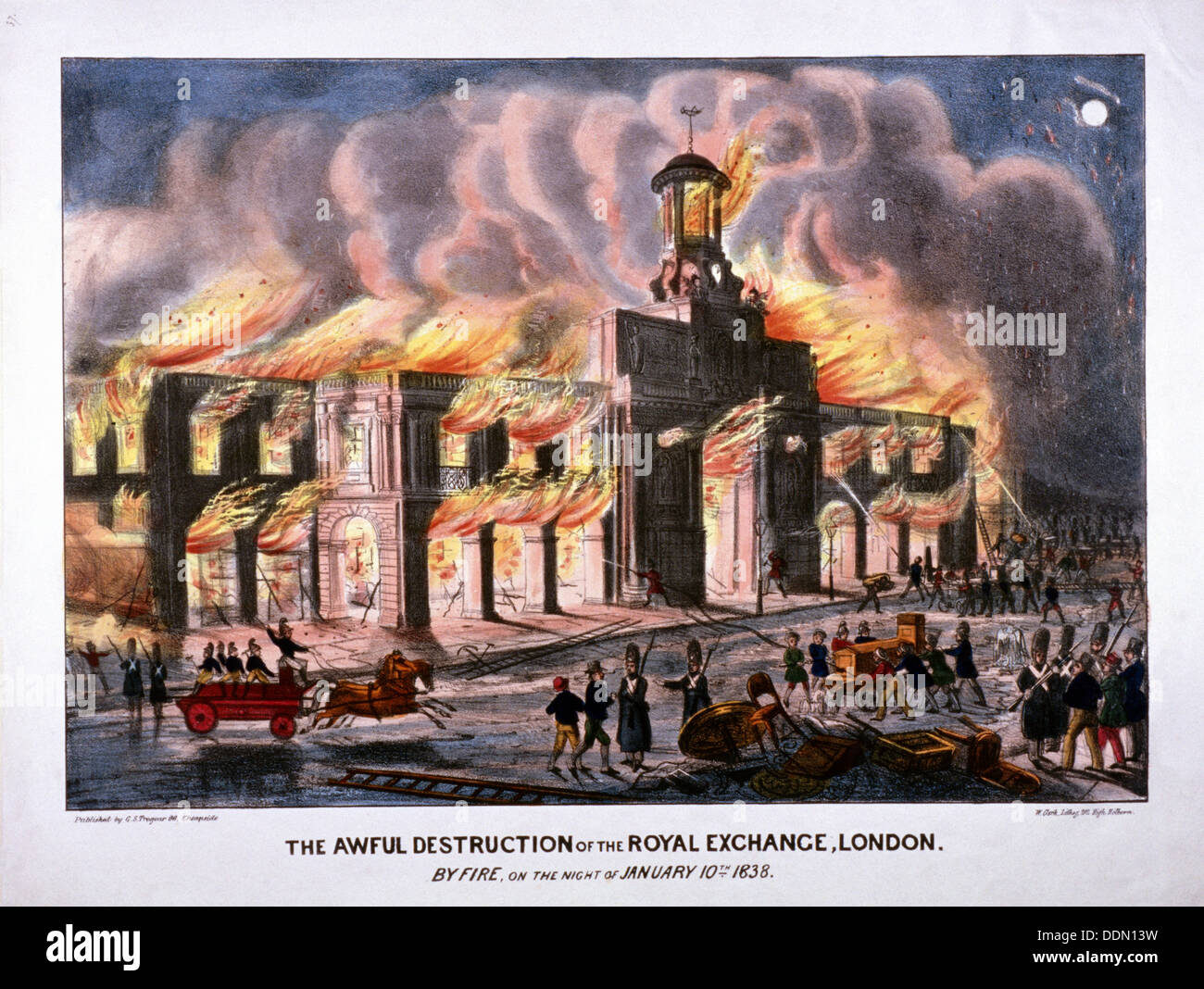 Royal Exchange (2nd) fire, London, 1838. Artist: W Clerk Stock Photohttps://www.alamy.com/image-license-details/?v=1https://www.alamy.com/royal-exchange-2nd-fire-london-1838-artist-w-clerk-image60083517.html
Royal Exchange (2nd) fire, London, 1838. Artist: W Clerk Stock Photohttps://www.alamy.com/image-license-details/?v=1https://www.alamy.com/royal-exchange-2nd-fire-london-1838-artist-w-clerk-image60083517.htmlRMDDN13W–Royal Exchange (2nd) fire, London, 1838. Artist: W Clerk
 Fire Engine Stock Photohttps://www.alamy.com/image-license-details/?v=1https://www.alamy.com/stock-photo-fire-engine-105253115.html
Fire Engine Stock Photohttps://www.alamy.com/image-license-details/?v=1https://www.alamy.com/stock-photo-fire-engine-105253115.htmlRMG36KBR–Fire Engine
 LONDON, UK - APRIL 19TH 2018: A plaque marking the location where District Officer Charles Pearson lost his life during the Sidney Street Siege in Lon Stock Photohttps://www.alamy.com/image-license-details/?v=1https://www.alamy.com/london-uk-april-19th-2018-a-plaque-marking-the-location-where-district-officer-charles-pearson-lost-his-life-during-the-sidney-street-siege-in-lon-image184715594.html
LONDON, UK - APRIL 19TH 2018: A plaque marking the location where District Officer Charles Pearson lost his life during the Sidney Street Siege in Lon Stock Photohttps://www.alamy.com/image-license-details/?v=1https://www.alamy.com/london-uk-april-19th-2018-a-plaque-marking-the-location-where-district-officer-charles-pearson-lost-his-life-during-the-sidney-street-siege-in-lon-image184715594.htmlRMMMEEHE–LONDON, UK - APRIL 19TH 2018: A plaque marking the location where District Officer Charles Pearson lost his life during the Sidney Street Siege in Lon
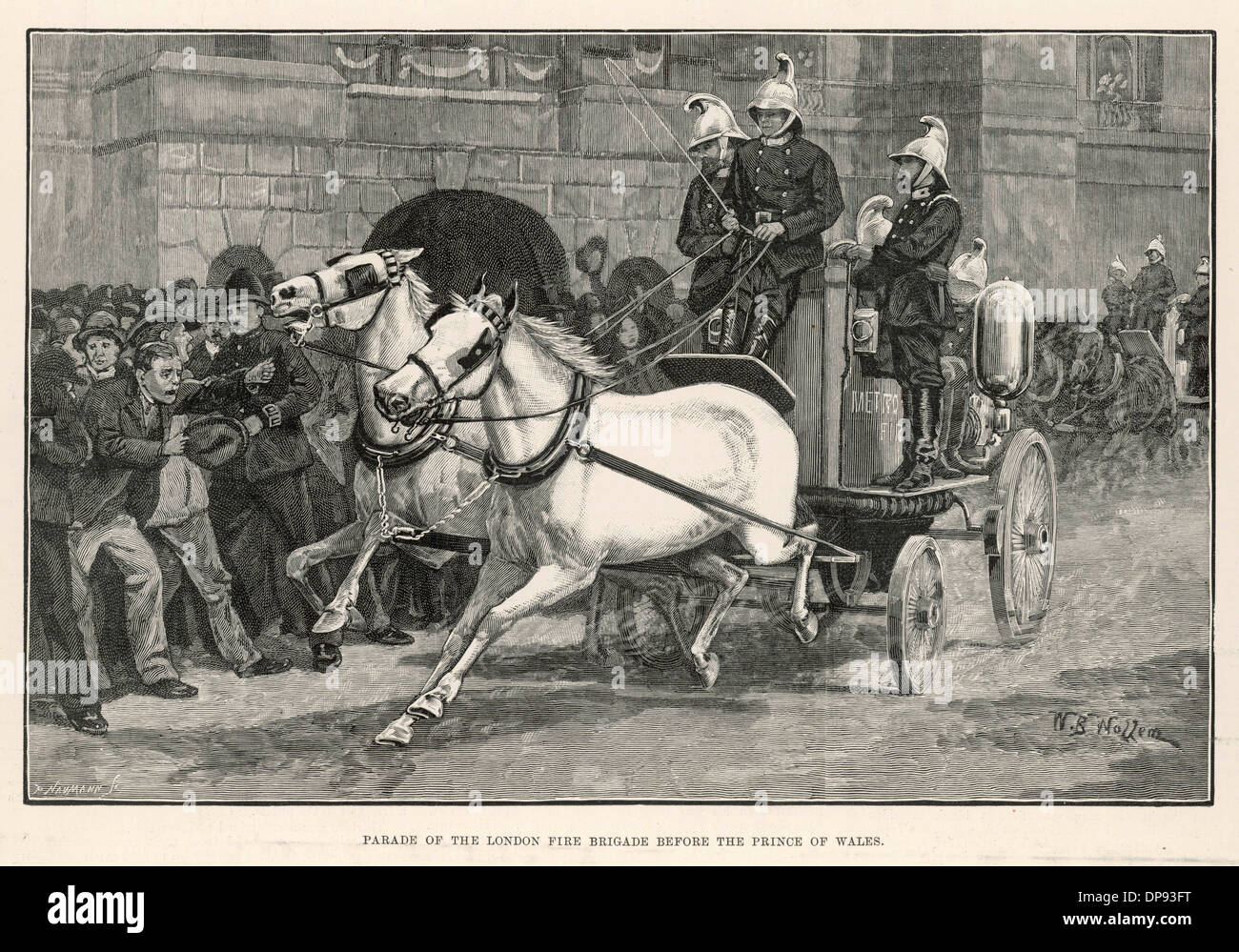 Horse drawn fire engine Stock Photohttps://www.alamy.com/image-license-details/?v=1https://www.alamy.com/horse-drawn-fire-engine-image65353900.html
Horse drawn fire engine Stock Photohttps://www.alamy.com/image-license-details/?v=1https://www.alamy.com/horse-drawn-fire-engine-image65353900.htmlRMDP93FT–Horse drawn fire engine
 Southwark street - the Head-Quarters of the metropolitan fire Brigade Stock Photohttps://www.alamy.com/image-license-details/?v=1https://www.alamy.com/southwark-street-the-head-quarters-of-the-metropolitan-fire-brigade-image242550213.html
Southwark street - the Head-Quarters of the metropolitan fire Brigade Stock Photohttps://www.alamy.com/image-license-details/?v=1https://www.alamy.com/southwark-street-the-head-quarters-of-the-metropolitan-fire-brigade-image242550213.htmlRFT2H37H–Southwark street - the Head-Quarters of the metropolitan fire Brigade
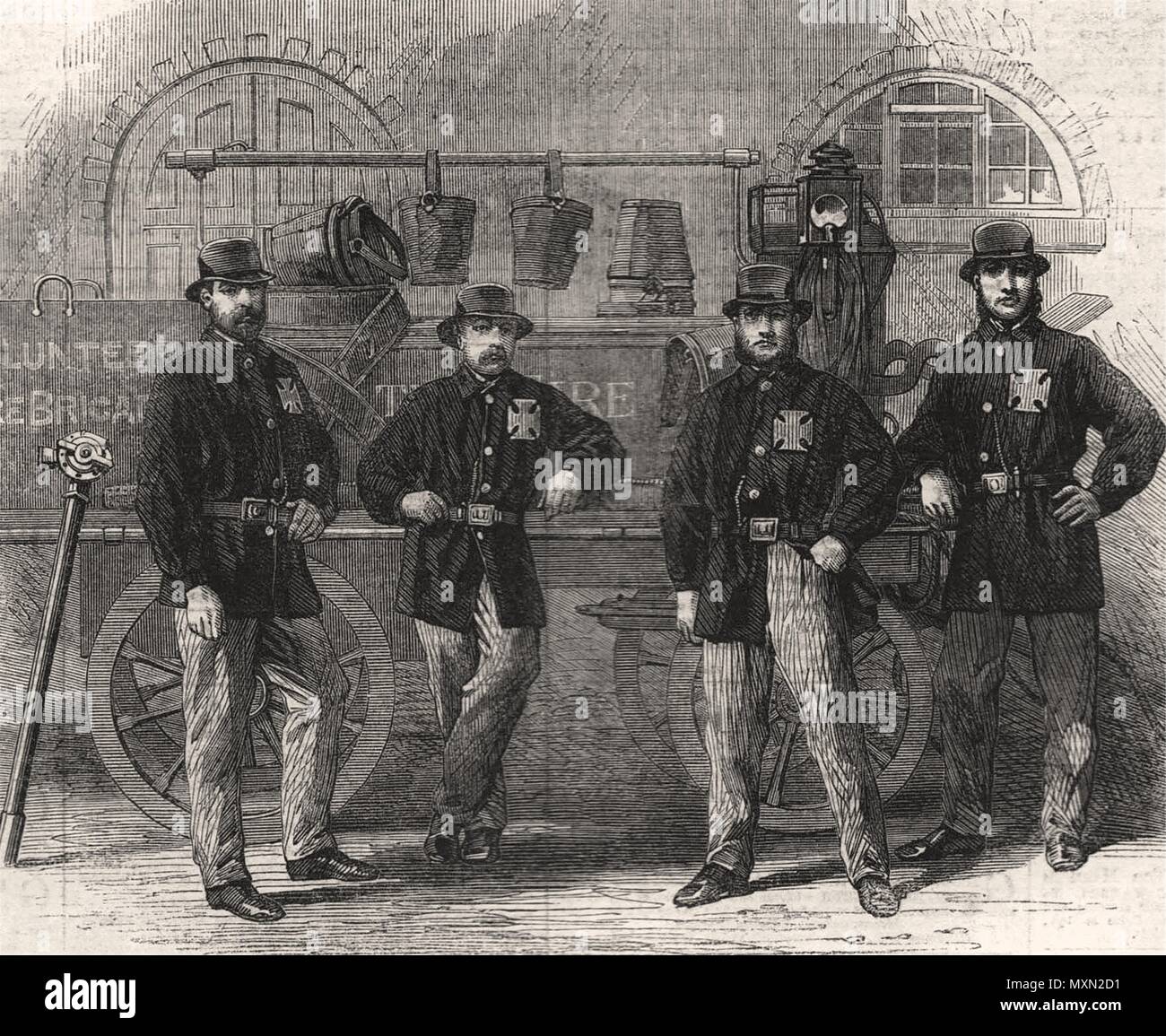 Members of the Coventry Volunteer Fire Brigade. Warwickshire 1862. The Illustrated London News Stock Photohttps://www.alamy.com/image-license-details/?v=1https://www.alamy.com/members-of-the-coventry-volunteer-fire-brigade-warwickshire-1862-the-illustrated-london-news-image188547661.html
Members of the Coventry Volunteer Fire Brigade. Warwickshire 1862. The Illustrated London News Stock Photohttps://www.alamy.com/image-license-details/?v=1https://www.alamy.com/members-of-the-coventry-volunteer-fire-brigade-warwickshire-1862-the-illustrated-london-news-image188547661.htmlRFMXN2D1–Members of the Coventry Volunteer Fire Brigade. Warwickshire 1862. The Illustrated London News
![The Great Fire at Brooks's Wharf, Queenhithe, [London], 1876. 'The...fire took place [in] a large bonded warehouse...having an extensive river frontage, in the occupation of Messrs. John Warner and Sons, merchants...about ten minutes past five the whole City was alarmed by huge masses of dense smoke rising suddenly into the air...The whole available strength of the Metropolitan Fire Brigade was speedily brought into requisition...for two hours, so dense were the smoke and steam, the firemen never saw the upper floors of the building, and their hose had to be brought up over fire-escapes and la Stock Photo The Great Fire at Brooks's Wharf, Queenhithe, [London], 1876. 'The...fire took place [in] a large bonded warehouse...having an extensive river frontage, in the occupation of Messrs. John Warner and Sons, merchants...about ten minutes past five the whole City was alarmed by huge masses of dense smoke rising suddenly into the air...The whole available strength of the Metropolitan Fire Brigade was speedily brought into requisition...for two hours, so dense were the smoke and steam, the firemen never saw the upper floors of the building, and their hose had to be brought up over fire-escapes and la Stock Photo](https://c8.alamy.com/comp/2RRJABG/the-great-fire-at-brookss-wharf-queenhithe-london-1876-thefire-took-place-in-a-large-bonded-warehousehaving-an-extensive-river-frontage-in-the-occupation-of-messrs-john-warner-and-sons-merchantsabout-ten-minutes-past-five-the-whole-city-was-alarmed-by-huge-masses-of-dense-smoke-rising-suddenly-into-the-airthe-whole-available-strength-of-the-metropolitan-fire-brigade-was-speedily-brought-into-requisitionfor-two-hours-so-dense-were-the-smoke-and-steam-the-firemen-never-saw-the-upper-floors-of-the-building-and-their-hose-had-to-be-brought-up-over-fire-escapes-and-la-2RRJABG.jpg) The Great Fire at Brooks's Wharf, Queenhithe, [London], 1876. 'The...fire took place [in] a large bonded warehouse...having an extensive river frontage, in the occupation of Messrs. John Warner and Sons, merchants...about ten minutes past five the whole City was alarmed by huge masses of dense smoke rising suddenly into the air...The whole available strength of the Metropolitan Fire Brigade was speedily brought into requisition...for two hours, so dense were the smoke and steam, the firemen never saw the upper floors of the building, and their hose had to be brought up over fire-escapes and la Stock Photohttps://www.alamy.com/image-license-details/?v=1https://www.alamy.com/the-great-fire-at-brookss-wharf-queenhithe-london-1876-thefire-took-place-in-a-large-bonded-warehousehaving-an-extensive-river-frontage-in-the-occupation-of-messrs-john-warner-and-sons-merchantsabout-ten-minutes-past-five-the-whole-city-was-alarmed-by-huge-masses-of-dense-smoke-rising-suddenly-into-the-airthe-whole-available-strength-of-the-metropolitan-fire-brigade-was-speedily-brought-into-requisitionfor-two-hours-so-dense-were-the-smoke-and-steam-the-firemen-never-saw-the-upper-floors-of-the-building-and-their-hose-had-to-be-brought-up-over-fire-escapes-and-la-image565272164.html
The Great Fire at Brooks's Wharf, Queenhithe, [London], 1876. 'The...fire took place [in] a large bonded warehouse...having an extensive river frontage, in the occupation of Messrs. John Warner and Sons, merchants...about ten minutes past five the whole City was alarmed by huge masses of dense smoke rising suddenly into the air...The whole available strength of the Metropolitan Fire Brigade was speedily brought into requisition...for two hours, so dense were the smoke and steam, the firemen never saw the upper floors of the building, and their hose had to be brought up over fire-escapes and la Stock Photohttps://www.alamy.com/image-license-details/?v=1https://www.alamy.com/the-great-fire-at-brookss-wharf-queenhithe-london-1876-thefire-took-place-in-a-large-bonded-warehousehaving-an-extensive-river-frontage-in-the-occupation-of-messrs-john-warner-and-sons-merchantsabout-ten-minutes-past-five-the-whole-city-was-alarmed-by-huge-masses-of-dense-smoke-rising-suddenly-into-the-airthe-whole-available-strength-of-the-metropolitan-fire-brigade-was-speedily-brought-into-requisitionfor-two-hours-so-dense-were-the-smoke-and-steam-the-firemen-never-saw-the-upper-floors-of-the-building-and-their-hose-had-to-be-brought-up-over-fire-escapes-and-la-image565272164.htmlRM2RRJABG–The Great Fire at Brooks's Wharf, Queenhithe, [London], 1876. 'The...fire took place [in] a large bonded warehouse...having an extensive river frontage, in the occupation of Messrs. John Warner and Sons, merchants...about ten minutes past five the whole City was alarmed by huge masses of dense smoke rising suddenly into the air...The whole available strength of the Metropolitan Fire Brigade was speedily brought into requisition...for two hours, so dense were the smoke and steam, the firemen never saw the upper floors of the building, and their hose had to be brought up over fire-escapes and la
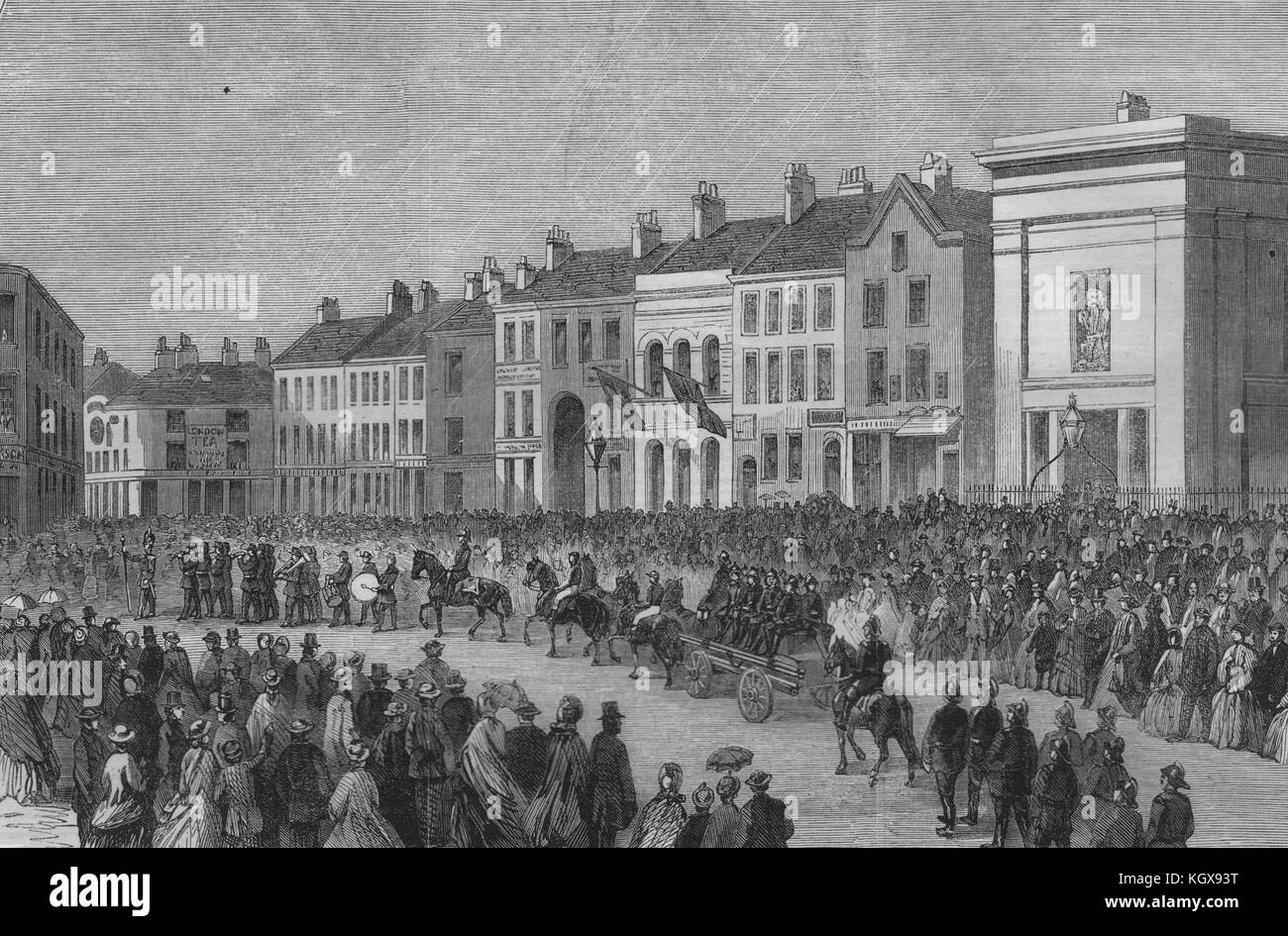 Macclesfield Fire Brigade inauguration market place parade. Cheshire 1863. The Illustrated London News Stock Photohttps://www.alamy.com/image-license-details/?v=1https://www.alamy.com/stock-image-macclesfield-fire-brigade-inauguration-market-place-parade-cheshire-165305724.html
Macclesfield Fire Brigade inauguration market place parade. Cheshire 1863. The Illustrated London News Stock Photohttps://www.alamy.com/image-license-details/?v=1https://www.alamy.com/stock-image-macclesfield-fire-brigade-inauguration-market-place-parade-cheshire-165305724.htmlRFKGX93T–Macclesfield Fire Brigade inauguration market place parade. Cheshire 1863. The Illustrated London News
 Captain Sir Eyre Massey Shaw, KCB, 1830 - 1908, head of the Metropolitan Fire Brigade, the fire brigade of London, England, Stock Photohttps://www.alamy.com/image-license-details/?v=1https://www.alamy.com/stock-photo-captain-sir-eyre-massey-shaw-kcb-1830-1908-head-of-the-metropolitan-52655779.html
Captain Sir Eyre Massey Shaw, KCB, 1830 - 1908, head of the Metropolitan Fire Brigade, the fire brigade of London, England, Stock Photohttps://www.alamy.com/image-license-details/?v=1https://www.alamy.com/stock-photo-captain-sir-eyre-massey-shaw-kcb-1830-1908-head-of-the-metropolitan-52655779.htmlRMD1JJYF–Captain Sir Eyre Massey Shaw, KCB, 1830 - 1908, head of the Metropolitan Fire Brigade, the fire brigade of London, England,
 A firefighter is rescuing two children, Hatton Garden, City of London, 1844 Stock Photohttps://www.alamy.com/image-license-details/?v=1https://www.alamy.com/a-firefighter-is-rescuing-two-children-hatton-garden-city-of-london-1844-image416841564.html
A firefighter is rescuing two children, Hatton Garden, City of London, 1844 Stock Photohttps://www.alamy.com/image-license-details/?v=1https://www.alamy.com/a-firefighter-is-rescuing-two-children-hatton-garden-city-of-london-1844-image416841564.htmlRM2F64NJM–A firefighter is rescuing two children, Hatton Garden, City of London, 1844
 Fire brigade in action in London, using a chest engine recharged from a street hydrant. London, 1850. Stock Photohttps://www.alamy.com/image-license-details/?v=1https://www.alamy.com/fire-brigade-in-action-in-london-using-a-chest-engine-recharged-from-a-street-hydrant-london-1850-image481927875.html
Fire brigade in action in London, using a chest engine recharged from a street hydrant. London, 1850. Stock Photohttps://www.alamy.com/image-license-details/?v=1https://www.alamy.com/fire-brigade-in-action-in-london-using-a-chest-engine-recharged-from-a-street-hydrant-london-1850-image481927875.htmlRM2K01KWR–Fire brigade in action in London, using a chest engine recharged from a street hydrant. London, 1850.
 'Destruction of the Royal Exchange' (2nd) fire, London, 1838. Artist: W Clerk Stock Photohttps://www.alamy.com/image-license-details/?v=1https://www.alamy.com/destruction-of-the-royal-exchange-2nd-fire-london-1838-artist-w-clerk-image60083483.html
'Destruction of the Royal Exchange' (2nd) fire, London, 1838. Artist: W Clerk Stock Photohttps://www.alamy.com/image-license-details/?v=1https://www.alamy.com/destruction-of-the-royal-exchange-2nd-fire-london-1838-artist-w-clerk-image60083483.htmlRMDDN12K–'Destruction of the Royal Exchange' (2nd) fire, London, 1838. Artist: W Clerk
 Cheapside, London, 1881. Artist: Anon Stock Photohttps://www.alamy.com/image-license-details/?v=1https://www.alamy.com/cheapside-london-1881-artist-anon-image60079264.html
Cheapside, London, 1881. Artist: Anon Stock Photohttps://www.alamy.com/image-license-details/?v=1https://www.alamy.com/cheapside-london-1881-artist-anon-image60079264.htmlRMDDMRM0–Cheapside, London, 1881. Artist: Anon
 LONDON, UK - APRIL 19TH 2018: A plaque marking the location where District Officer Charles Pearson lost his life during the Sidney Street Siege in Lon Stock Photohttps://www.alamy.com/image-license-details/?v=1https://www.alamy.com/london-uk-april-19th-2018-a-plaque-marking-the-location-where-district-officer-charles-pearson-lost-his-life-during-the-sidney-street-siege-in-lon-image184715590.html
LONDON, UK - APRIL 19TH 2018: A plaque marking the location where District Officer Charles Pearson lost his life during the Sidney Street Siege in Lon Stock Photohttps://www.alamy.com/image-license-details/?v=1https://www.alamy.com/london-uk-april-19th-2018-a-plaque-marking-the-location-where-district-officer-charles-pearson-lost-his-life-during-the-sidney-street-siege-in-lon-image184715590.htmlRMMMEEHA–LONDON, UK - APRIL 19TH 2018: A plaque marking the location where District Officer Charles Pearson lost his life during the Sidney Street Siege in Lon
![The Fire at the City Flour-Mills in Upper Thames-Street, [London, seen from the River Thames], 1872. This building [belonging to Messrs J. Hadley and Co.] stood a little below Blackfriars Bridge...Along the western side was the creek or dock, in which barges could be unloaded. An immense quantity of grain, said to amount to 200,000 quarters, was stored in these mills...It was in the third floor that the fire broke out. The alarm was given to the Metropolitan Fire Brigade, in Watling-street, where two engines, one a powerful steamer, were got out, and in less than five minutes were on the way t Stock Photo The Fire at the City Flour-Mills in Upper Thames-Street, [London, seen from the River Thames], 1872. This building [belonging to Messrs J. Hadley and Co.] stood a little below Blackfriars Bridge...Along the western side was the creek or dock, in which barges could be unloaded. An immense quantity of grain, said to amount to 200,000 quarters, was stored in these mills...It was in the third floor that the fire broke out. The alarm was given to the Metropolitan Fire Brigade, in Watling-street, where two engines, one a powerful steamer, were got out, and in less than five minutes were on the way t Stock Photo](https://c8.alamy.com/comp/2YX4B3F/the-fire-at-the-city-flour-mills-in-upper-thames-street-london-seen-from-the-river-thames-1872-this-building-belonging-to-messrs-j-hadley-and-co-stood-a-little-below-blackfriars-bridgealong-the-western-side-was-the-creek-or-dock-in-which-barges-could-be-unloaded-an-immense-quantity-of-grain-said-to-amount-to-200000-quarters-was-stored-in-these-millsit-was-in-the-third-floor-that-the-fire-broke-out-the-alarm-was-given-to-the-metropolitan-fire-brigade-in-watling-street-where-two-engines-one-a-powerful-steamer-were-got-out-and-in-less-than-five-minutes-were-on-the-way-t-2YX4B3F.jpg) The Fire at the City Flour-Mills in Upper Thames-Street, [London, seen from the River Thames], 1872. This building [belonging to Messrs J. Hadley and Co.] stood a little below Blackfriars Bridge...Along the western side was the creek or dock, in which barges could be unloaded. An immense quantity of grain, said to amount to 200,000 quarters, was stored in these mills...It was in the third floor that the fire broke out. The alarm was given to the Metropolitan Fire Brigade, in Watling-street, where two engines, one a powerful steamer, were got out, and in less than five minutes were on the way t Stock Photohttps://www.alamy.com/image-license-details/?v=1https://www.alamy.com/the-fire-at-the-city-flour-mills-in-upper-thames-street-london-seen-from-the-river-thames-1872-this-building-belonging-to-messrs-j-hadley-and-co-stood-a-little-below-blackfriars-bridgealong-the-western-side-was-the-creek-or-dock-in-which-barges-could-be-unloaded-an-immense-quantity-of-grain-said-to-amount-to-200000-quarters-was-stored-in-these-millsit-was-in-the-third-floor-that-the-fire-broke-out-the-alarm-was-given-to-the-metropolitan-fire-brigade-in-watling-street-where-two-engines-one-a-powerful-steamer-were-got-out-and-in-less-than-five-minutes-were-on-the-way-t-image635650835.html
The Fire at the City Flour-Mills in Upper Thames-Street, [London, seen from the River Thames], 1872. This building [belonging to Messrs J. Hadley and Co.] stood a little below Blackfriars Bridge...Along the western side was the creek or dock, in which barges could be unloaded. An immense quantity of grain, said to amount to 200,000 quarters, was stored in these mills...It was in the third floor that the fire broke out. The alarm was given to the Metropolitan Fire Brigade, in Watling-street, where two engines, one a powerful steamer, were got out, and in less than five minutes were on the way t Stock Photohttps://www.alamy.com/image-license-details/?v=1https://www.alamy.com/the-fire-at-the-city-flour-mills-in-upper-thames-street-london-seen-from-the-river-thames-1872-this-building-belonging-to-messrs-j-hadley-and-co-stood-a-little-below-blackfriars-bridgealong-the-western-side-was-the-creek-or-dock-in-which-barges-could-be-unloaded-an-immense-quantity-of-grain-said-to-amount-to-200000-quarters-was-stored-in-these-millsit-was-in-the-third-floor-that-the-fire-broke-out-the-alarm-was-given-to-the-metropolitan-fire-brigade-in-watling-street-where-two-engines-one-a-powerful-steamer-were-got-out-and-in-less-than-five-minutes-were-on-the-way-t-image635650835.htmlRM2YX4B3F–The Fire at the City Flour-Mills in Upper Thames-Street, [London, seen from the River Thames], 1872. This building [belonging to Messrs J. Hadley and Co.] stood a little below Blackfriars Bridge...Along the western side was the creek or dock, in which barges could be unloaded. An immense quantity of grain, said to amount to 200,000 quarters, was stored in these mills...It was in the third floor that the fire broke out. The alarm was given to the Metropolitan Fire Brigade, in Watling-street, where two engines, one a powerful steamer, were got out, and in less than five minutes were on the way t
 Fire brigade demonstration & public fête at Leighton Buzzard. Bedfordshire 1863. The Illustrated London News Stock Photohttps://www.alamy.com/image-license-details/?v=1https://www.alamy.com/fire-brigade-demonstration-public-fte-at-leighton-buzzard-bedfordshire-1863-the-illustrated-london-news-image188545694.html
Fire brigade demonstration & public fête at Leighton Buzzard. Bedfordshire 1863. The Illustrated London News Stock Photohttps://www.alamy.com/image-license-details/?v=1https://www.alamy.com/fire-brigade-demonstration-public-fte-at-leighton-buzzard-bedfordshire-1863-the-illustrated-london-news-image188545694.htmlRFMXMYXP–Fire brigade demonstration & public fête at Leighton Buzzard. Bedfordshire 1863. The Illustrated London News
 CORNWALL Truro Firemen at a fire, Quay side 1873. Illustrated London News Stock Photohttps://www.alamy.com/image-license-details/?v=1https://www.alamy.com/stock-photo-cornwall-truro-firemen-at-a-fire-quay-side-1873-illustrated-london-95366910.html
CORNWALL Truro Firemen at a fire, Quay side 1873. Illustrated London News Stock Photohttps://www.alamy.com/image-license-details/?v=1https://www.alamy.com/stock-photo-cornwall-truro-firemen-at-a-fire-quay-side-1873-illustrated-london-95366910.htmlRFFF49D2–CORNWALL Truro Firemen at a fire, Quay side 1873. Illustrated London News
 VANITY FAIR SPY CARTOON Eyre Massey Shaw 'He well deserves his popularity' 1871 Stock Photohttps://www.alamy.com/image-license-details/?v=1https://www.alamy.com/vanity-fair-spy-cartoon-eyre-massey-shaw-he-well-deserves-his-popularity-1871-image610584286.html
VANITY FAIR SPY CARTOON Eyre Massey Shaw 'He well deserves his popularity' 1871 Stock Photohttps://www.alamy.com/image-license-details/?v=1https://www.alamy.com/vanity-fair-spy-cartoon-eyre-massey-shaw-he-well-deserves-his-popularity-1871-image610584286.htmlRF2XDAEDJ–VANITY FAIR SPY CARTOON Eyre Massey Shaw 'He well deserves his popularity' 1871
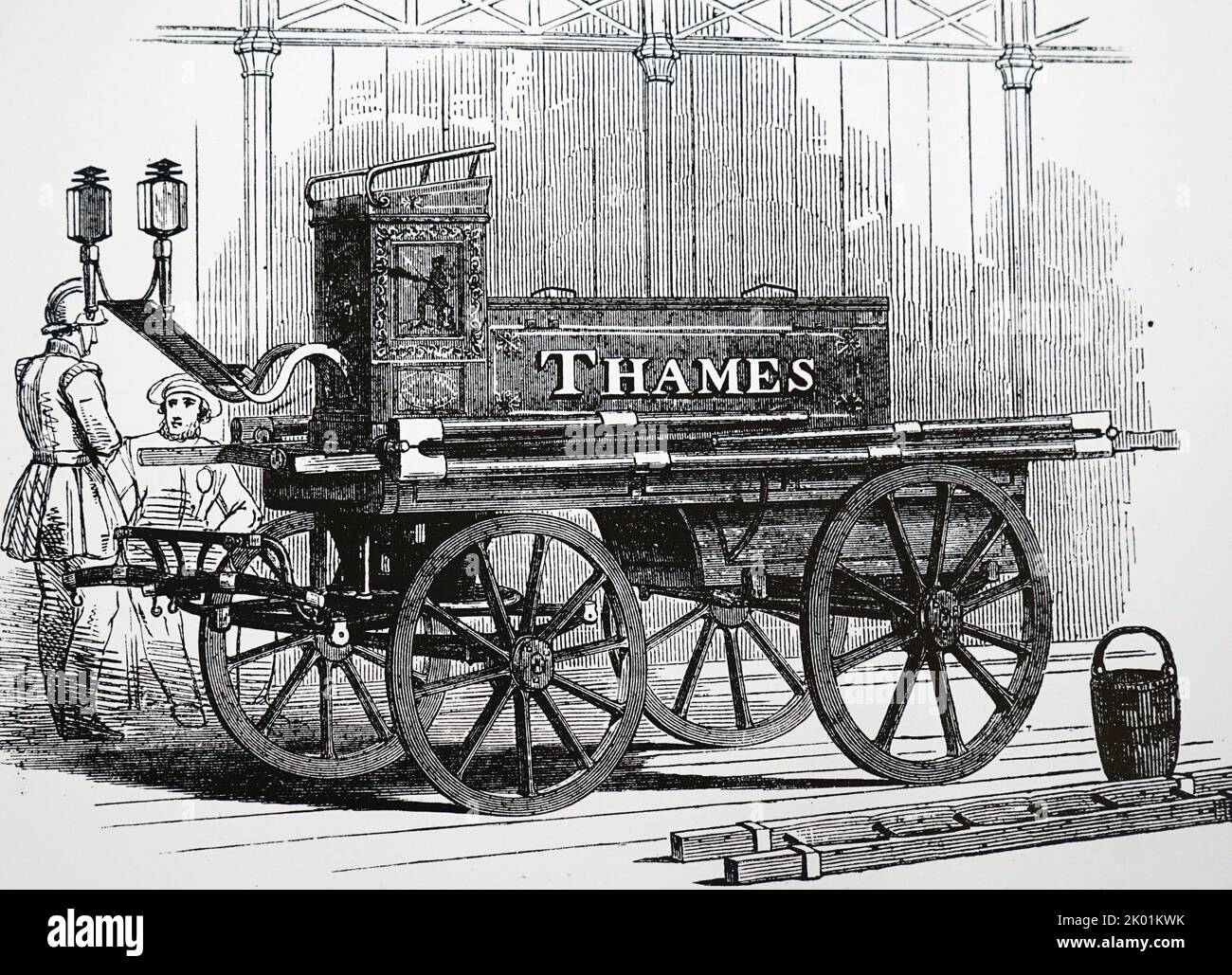 Shand and Mason's fire engine, used by the London Fire Brigade. 1851. Stock Photohttps://www.alamy.com/image-license-details/?v=1https://www.alamy.com/shand-and-masons-fire-engine-used-by-the-london-fire-brigade-1851-image481927871.html
Shand and Mason's fire engine, used by the London Fire Brigade. 1851. Stock Photohttps://www.alamy.com/image-license-details/?v=1https://www.alamy.com/shand-and-masons-fire-engine-used-by-the-london-fire-brigade-1851-image481927871.htmlRM2K01KWK–Shand and Mason's fire engine, used by the London Fire Brigade. 1851.
 Conflagration at Sir C. Price's Wharf, Blackfriars, 1845. The London fire brigade attempting to extinguish a fire '...in the warehouses belonging to Sir Charles Price and Co., oil and colourmen...adjoining Blackfriars-bridge...Now the fears of the inhabitants were raised to a painful pitch, lest there should be an explosion of gas - in which case there must have been fearful devastation...The man who lost his life is known to have been working at the engine that was destroyed; in all probability, he missed his way when he retreated, and, instead of jumping into the river, became fixed against Stock Photohttps://www.alamy.com/image-license-details/?v=1https://www.alamy.com/conflagration-at-sir-c-prices-wharf-blackfriars-1845-the-london-fire-brigade-attempting-to-extinguish-a-fire-in-the-warehouses-belonging-to-sir-charles-price-and-co-oil-and-colourmenadjoining-blackfriars-bridgenow-the-fears-of-the-inhabitants-were-raised-to-a-painful-pitch-lest-there-should-be-an-explosion-of-gas-in-which-case-there-must-have-been-fearful-devastationthe-man-who-lost-his-life-is-known-to-have-been-working-at-the-engine-that-was-destroyed-in-all-probability-he-missed-his-way-when-he-retreated-and-instead-of-jumping-into-the-river-became-fixed-against-image397471909.html
Conflagration at Sir C. Price's Wharf, Blackfriars, 1845. The London fire brigade attempting to extinguish a fire '...in the warehouses belonging to Sir Charles Price and Co., oil and colourmen...adjoining Blackfriars-bridge...Now the fears of the inhabitants were raised to a painful pitch, lest there should be an explosion of gas - in which case there must have been fearful devastation...The man who lost his life is known to have been working at the engine that was destroyed; in all probability, he missed his way when he retreated, and, instead of jumping into the river, became fixed against Stock Photohttps://www.alamy.com/image-license-details/?v=1https://www.alamy.com/conflagration-at-sir-c-prices-wharf-blackfriars-1845-the-london-fire-brigade-attempting-to-extinguish-a-fire-in-the-warehouses-belonging-to-sir-charles-price-and-co-oil-and-colourmenadjoining-blackfriars-bridgenow-the-fears-of-the-inhabitants-were-raised-to-a-painful-pitch-lest-there-should-be-an-explosion-of-gas-in-which-case-there-must-have-been-fearful-devastationthe-man-who-lost-his-life-is-known-to-have-been-working-at-the-engine-that-was-destroyed-in-all-probability-he-missed-his-way-when-he-retreated-and-instead-of-jumping-into-the-river-became-fixed-against-image397471909.htmlRM2E2JBD9–Conflagration at Sir C. Price's Wharf, Blackfriars, 1845. The London fire brigade attempting to extinguish a fire '...in the warehouses belonging to Sir Charles Price and Co., oil and colourmen...adjoining Blackfriars-bridge...Now the fears of the inhabitants were raised to a painful pitch, lest there should be an explosion of gas - in which case there must have been fearful devastation...The man who lost his life is known to have been working at the engine that was destroyed; in all probability, he missed his way when he retreated, and, instead of jumping into the river, became fixed against
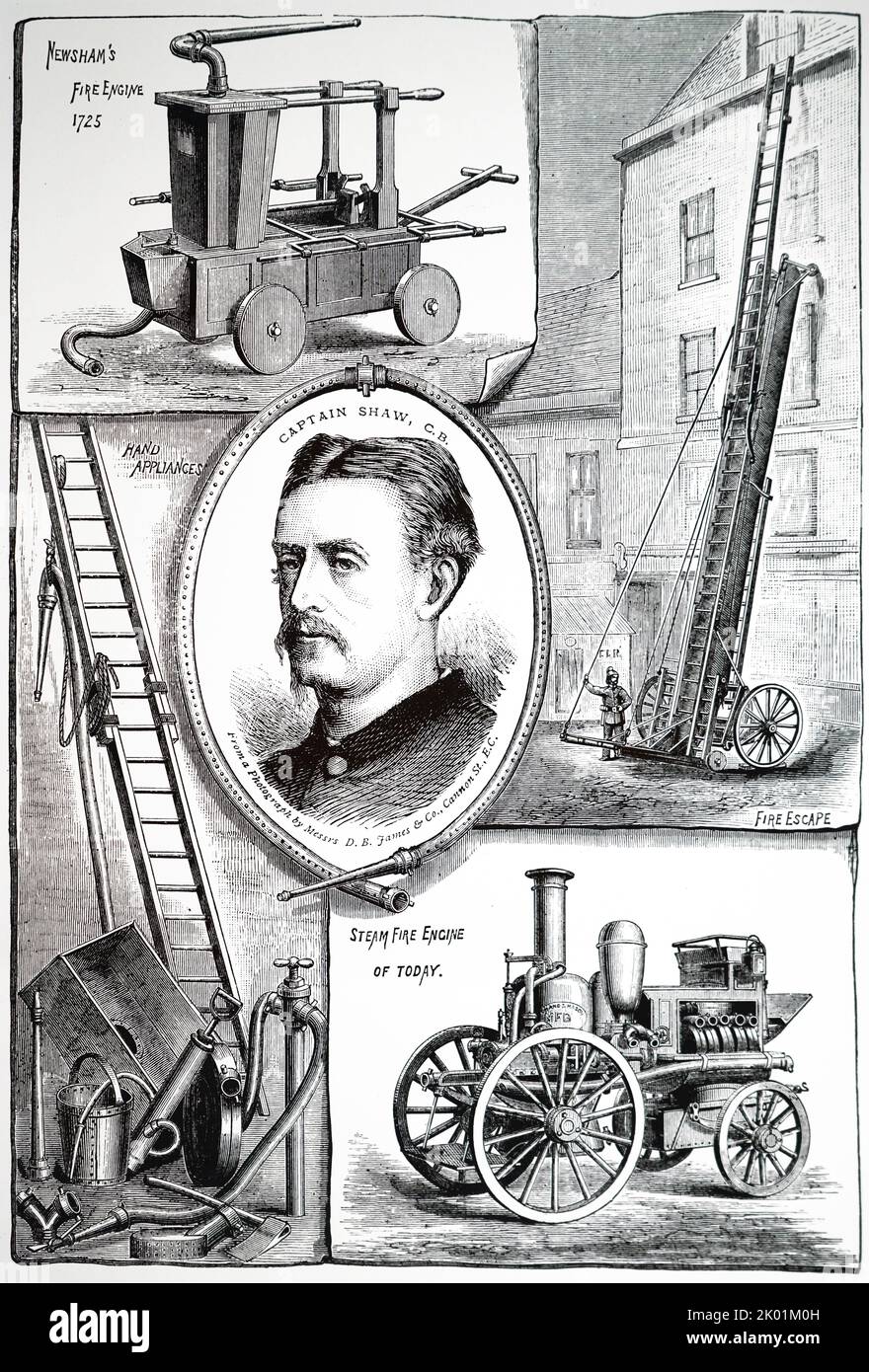 London Fire Brigade apparatus. Captain Shaw was Sir Eyre Massey Shaw (1830-1908). Head of London Metropolitan Fire Brigade. Stock Photohttps://www.alamy.com/image-license-details/?v=1https://www.alamy.com/london-fire-brigade-apparatus-captain-shaw-was-sir-eyre-massey-shaw-1830-1908-head-of-london-metropolitan-fire-brigade-image481927953.html
London Fire Brigade apparatus. Captain Shaw was Sir Eyre Massey Shaw (1830-1908). Head of London Metropolitan Fire Brigade. Stock Photohttps://www.alamy.com/image-license-details/?v=1https://www.alamy.com/london-fire-brigade-apparatus-captain-shaw-was-sir-eyre-massey-shaw-1830-1908-head-of-london-metropolitan-fire-brigade-image481927953.htmlRM2K01M0H–London Fire Brigade apparatus. Captain Shaw was Sir Eyre Massey Shaw (1830-1908). Head of London Metropolitan Fire Brigade.
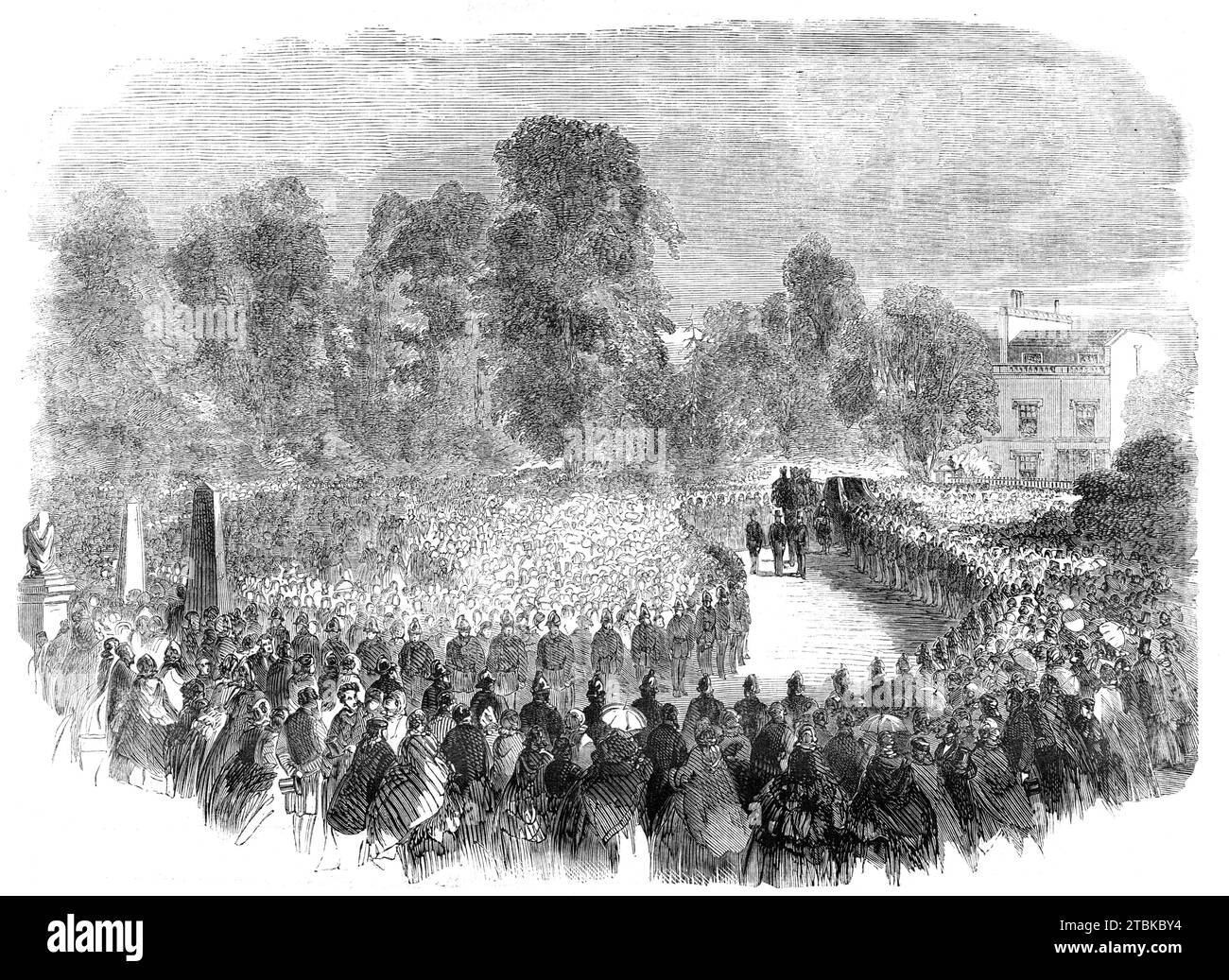 Funeral of Mr. Braidwood, the late Chief of the London Fire Brigade, in Abney-Park Cemetery, 1861. Braidwood died in the Tooley Street fire. 'Seldom if ever before in London has such a marked tribute of public respect been paid to a private individual. The London Rifle Brigade, the Tower Hamlets Volunteers, all the public and private fire brigades...formed part of the procession, which extended upwards of a mile in length. Every avenue...was blocked by a dense and almost impenetrable crowd, while throughout the entire length of the route along which it was to pass every path was thronged...The Stock Photohttps://www.alamy.com/image-license-details/?v=1https://www.alamy.com/funeral-of-mr-braidwood-the-late-chief-of-the-london-fire-brigade-in-abney-park-cemetery-1861-braidwood-died-in-the-tooley-street-fire-seldom-if-ever-before-in-london-has-such-a-marked-tribute-of-public-respect-been-paid-to-a-private-individual-the-london-rifle-brigade-the-tower-hamlets-volunteers-all-the-public-and-private-fire-brigadesformed-part-of-the-procession-which-extended-upwards-of-a-mile-in-length-every-avenuewas-blocked-by-a-dense-and-almost-impenetrable-crowd-while-throughout-the-entire-length-of-the-route-along-which-it-was-to-pass-every-path-was-throngedthe-image575129832.html
Funeral of Mr. Braidwood, the late Chief of the London Fire Brigade, in Abney-Park Cemetery, 1861. Braidwood died in the Tooley Street fire. 'Seldom if ever before in London has such a marked tribute of public respect been paid to a private individual. The London Rifle Brigade, the Tower Hamlets Volunteers, all the public and private fire brigades...formed part of the procession, which extended upwards of a mile in length. Every avenue...was blocked by a dense and almost impenetrable crowd, while throughout the entire length of the route along which it was to pass every path was thronged...The Stock Photohttps://www.alamy.com/image-license-details/?v=1https://www.alamy.com/funeral-of-mr-braidwood-the-late-chief-of-the-london-fire-brigade-in-abney-park-cemetery-1861-braidwood-died-in-the-tooley-street-fire-seldom-if-ever-before-in-london-has-such-a-marked-tribute-of-public-respect-been-paid-to-a-private-individual-the-london-rifle-brigade-the-tower-hamlets-volunteers-all-the-public-and-private-fire-brigadesformed-part-of-the-procession-which-extended-upwards-of-a-mile-in-length-every-avenuewas-blocked-by-a-dense-and-almost-impenetrable-crowd-while-throughout-the-entire-length-of-the-route-along-which-it-was-to-pass-every-path-was-throngedthe-image575129832.htmlRM2TBKBY4–Funeral of Mr. Braidwood, the late Chief of the London Fire Brigade, in Abney-Park Cemetery, 1861. Braidwood died in the Tooley Street fire. 'Seldom if ever before in London has such a marked tribute of public respect been paid to a private individual. The London Rifle Brigade, the Tower Hamlets Volunteers, all the public and private fire brigades...formed part of the procession, which extended upwards of a mile in length. Every avenue...was blocked by a dense and almost impenetrable crowd, while throughout the entire length of the route along which it was to pass every path was thronged...The
 Floating fire engine of the Metropolitan Fire Brigade, permantly stationed at Southwark Bridge, London, 1868. Stock Photohttps://www.alamy.com/image-license-details/?v=1https://www.alamy.com/floating-fire-engine-of-the-metropolitan-fire-brigade-permantly-stationed-at-southwark-bridge-london-1868-image481928466.html
Floating fire engine of the Metropolitan Fire Brigade, permantly stationed at Southwark Bridge, London, 1868. Stock Photohttps://www.alamy.com/image-license-details/?v=1https://www.alamy.com/floating-fire-engine-of-the-metropolitan-fire-brigade-permantly-stationed-at-southwark-bridge-london-1868-image481928466.htmlRM2K01MJX–Floating fire engine of the Metropolitan Fire Brigade, permantly stationed at Southwark Bridge, London, 1868.
 Engraving depicting a London fireman in standard uniform (right) and one equipped with smoke-proof dress and breathing pipe. Dated 19th century Stock Photohttps://www.alamy.com/image-license-details/?v=1https://www.alamy.com/engraving-depicting-a-london-fireman-in-standard-uniform-right-and-one-equipped-with-smoke-proof-dress-and-breathing-pipe-dated-19th-century-image186400192.html
Engraving depicting a London fireman in standard uniform (right) and one equipped with smoke-proof dress and breathing pipe. Dated 19th century Stock Photohttps://www.alamy.com/image-license-details/?v=1https://www.alamy.com/engraving-depicting-a-london-fireman-in-standard-uniform-right-and-one-equipped-with-smoke-proof-dress-and-breathing-pipe-dated-19th-century-image186400192.htmlRMMR779M–Engraving depicting a London fireman in standard uniform (right) and one equipped with smoke-proof dress and breathing pipe. Dated 19th century
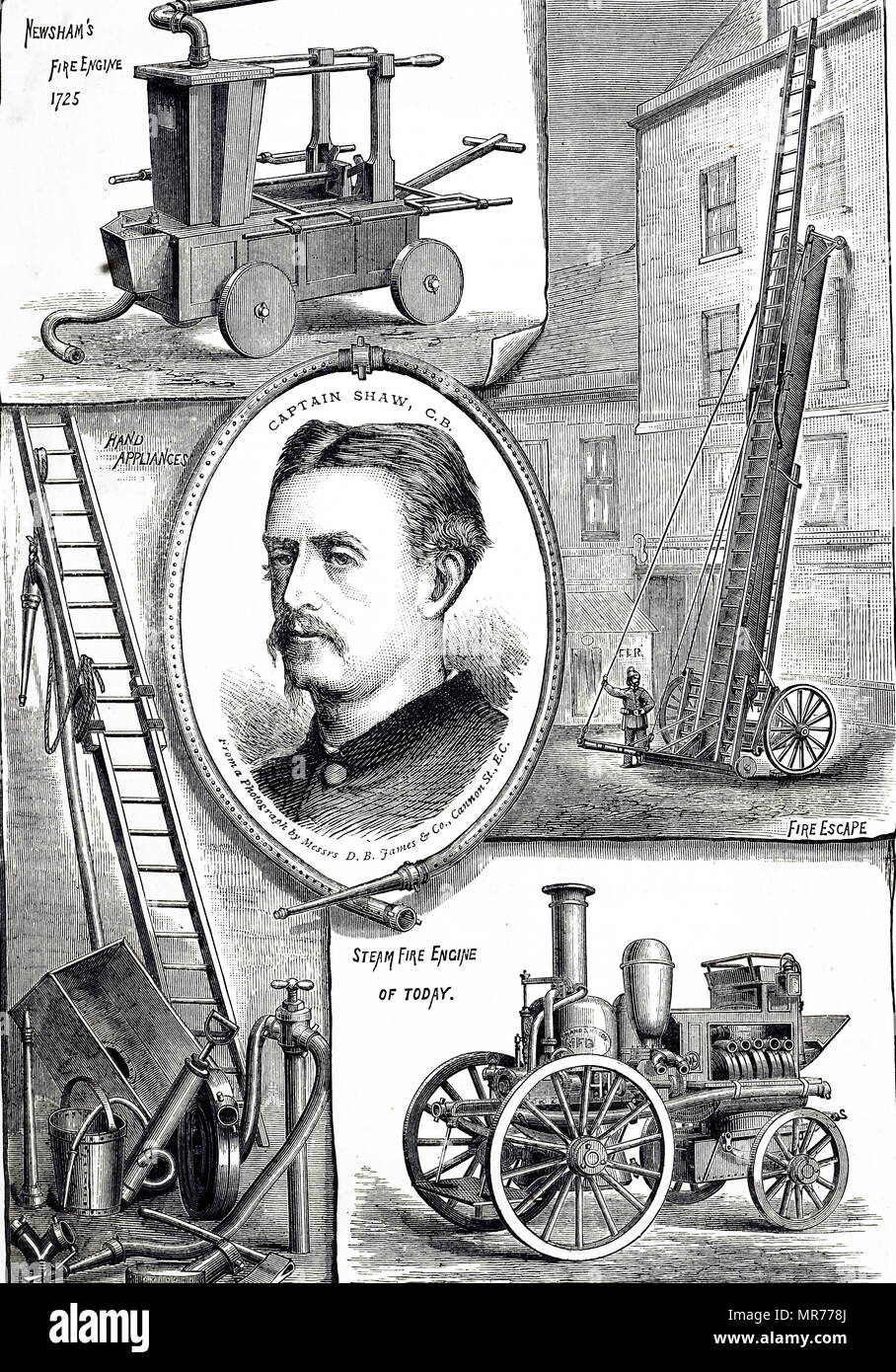 Engraving depicting Captain Eyre Massey Shaw (1830-1908) head of the London Metropolitan Fire Brigade, with fire apparatus. Dated 19th century Stock Photohttps://www.alamy.com/image-license-details/?v=1https://www.alamy.com/engraving-depicting-captain-eyre-massey-shaw-1830-1908-head-of-the-london-metropolitan-fire-brigade-with-fire-apparatus-dated-19th-century-image186400162.html
Engraving depicting Captain Eyre Massey Shaw (1830-1908) head of the London Metropolitan Fire Brigade, with fire apparatus. Dated 19th century Stock Photohttps://www.alamy.com/image-license-details/?v=1https://www.alamy.com/engraving-depicting-captain-eyre-massey-shaw-1830-1908-head-of-the-london-metropolitan-fire-brigade-with-fire-apparatus-dated-19th-century-image186400162.htmlRMMR778J–Engraving depicting Captain Eyre Massey Shaw (1830-1908) head of the London Metropolitan Fire Brigade, with fire apparatus. Dated 19th century
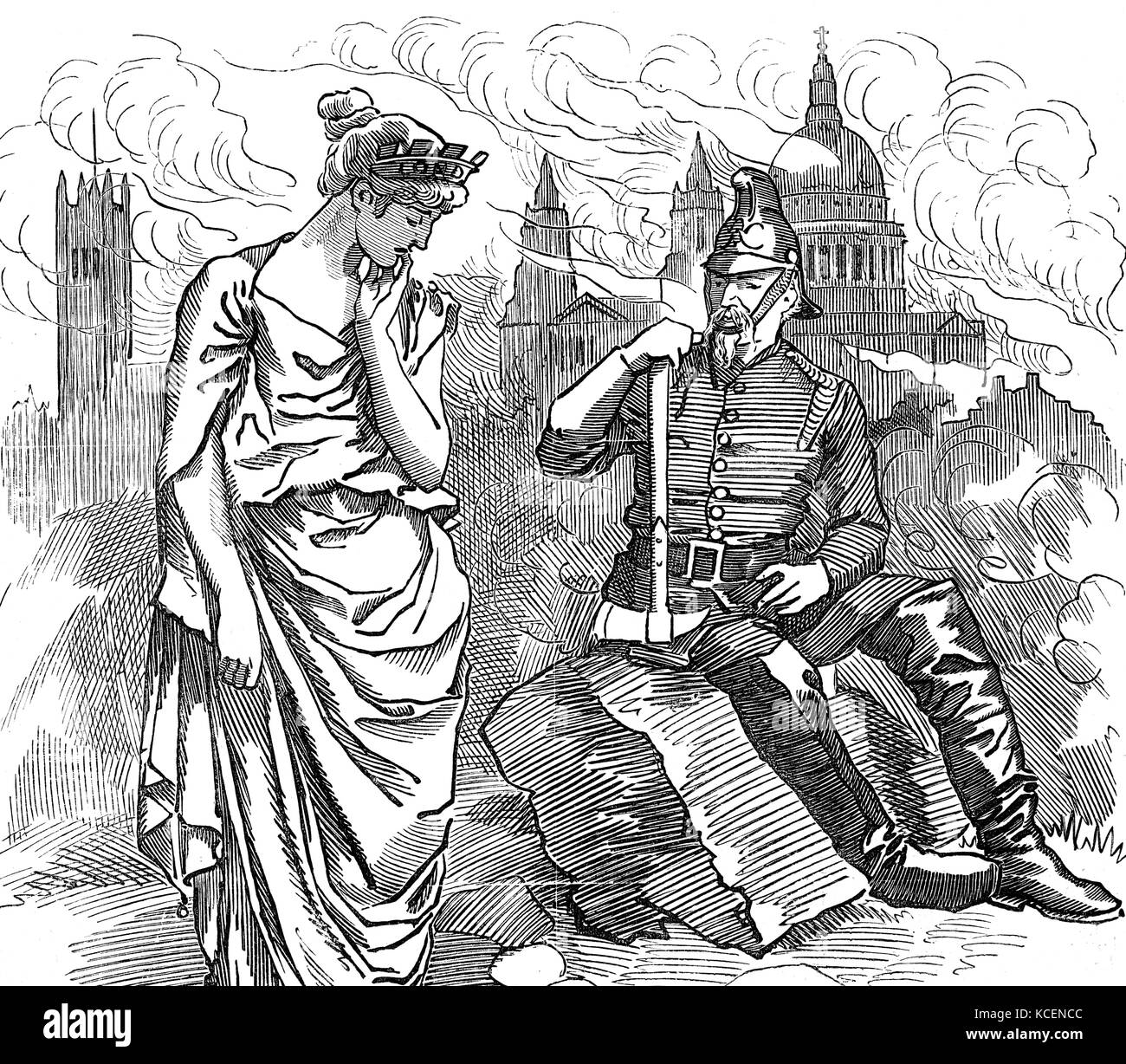 Illustration depicting Captain Eyre Massey Shaw (1830-1908) the Superintendent of the Metropolitan Fire Brigade and the London Fire Engine Establishment. Dated 19th Century Stock Photohttps://www.alamy.com/image-license-details/?v=1https://www.alamy.com/stock-image-illustration-depicting-captain-eyre-massey-shaw-1830-1908-the-superintendent-162593324.html
Illustration depicting Captain Eyre Massey Shaw (1830-1908) the Superintendent of the Metropolitan Fire Brigade and the London Fire Engine Establishment. Dated 19th Century Stock Photohttps://www.alamy.com/image-license-details/?v=1https://www.alamy.com/stock-image-illustration-depicting-captain-eyre-massey-shaw-1830-1908-the-superintendent-162593324.htmlRMKCENCC–Illustration depicting Captain Eyre Massey Shaw (1830-1908) the Superintendent of the Metropolitan Fire Brigade and the London Fire Engine Establishment. Dated 19th Century
 Engraving depicting Shand and Mason's fire engine, used by the London Fire Brigade. Dated 19th century Stock Photohttps://www.alamy.com/image-license-details/?v=1https://www.alamy.com/engraving-depicting-shand-and-masons-fire-engine-used-by-the-london-fire-brigade-dated-19th-century-image186399942.html
Engraving depicting Shand and Mason's fire engine, used by the London Fire Brigade. Dated 19th century Stock Photohttps://www.alamy.com/image-license-details/?v=1https://www.alamy.com/engraving-depicting-shand-and-masons-fire-engine-used-by-the-london-fire-brigade-dated-19th-century-image186399942.htmlRMMR770P–Engraving depicting Shand and Mason's fire engine, used by the London Fire Brigade. Dated 19th century
 Ruins of the Star and Garter Hotel at Richmond, 1870. Fire in south-west London. 'Colonel Bull, of the 19th Surrey Volunteers, held the ladder and desired Simpson and Lever to lower themselves from the window above. Simpson did so, by means of a sheet...It was hoped that Lever would have got down in the same manner; but he was observed suddenly to disappear from the window, having probably been suffocated by the smoke and rendered insensible...There were eight engines, one a steam fire-engine; but not a drop of water could be got till four o'clock. A man had to be sent to Battersea, to the off Stock Photohttps://www.alamy.com/image-license-details/?v=1https://www.alamy.com/ruins-of-the-star-and-garter-hotel-at-richmond-1870-fire-in-south-west-london-colonel-bull-of-the-19th-surrey-volunteers-held-the-ladder-and-desired-simpson-and-lever-to-lower-themselves-from-the-window-above-simpson-did-so-by-means-of-a-sheetit-was-hoped-that-lever-would-have-got-down-in-the-same-manner-but-he-was-observed-suddenly-to-disappear-from-the-window-having-probably-been-suffocated-by-the-smoke-and-rendered-insensiblethere-were-eight-engines-one-a-steam-fire-engine-but-not-a-drop-of-water-could-be-got-till-four-oclock-a-man-had-to-be-sent-to-battersea-to-the-off-image617180842.html
Ruins of the Star and Garter Hotel at Richmond, 1870. Fire in south-west London. 'Colonel Bull, of the 19th Surrey Volunteers, held the ladder and desired Simpson and Lever to lower themselves from the window above. Simpson did so, by means of a sheet...It was hoped that Lever would have got down in the same manner; but he was observed suddenly to disappear from the window, having probably been suffocated by the smoke and rendered insensible...There were eight engines, one a steam fire-engine; but not a drop of water could be got till four o'clock. A man had to be sent to Battersea, to the off Stock Photohttps://www.alamy.com/image-license-details/?v=1https://www.alamy.com/ruins-of-the-star-and-garter-hotel-at-richmond-1870-fire-in-south-west-london-colonel-bull-of-the-19th-surrey-volunteers-held-the-ladder-and-desired-simpson-and-lever-to-lower-themselves-from-the-window-above-simpson-did-so-by-means-of-a-sheetit-was-hoped-that-lever-would-have-got-down-in-the-same-manner-but-he-was-observed-suddenly-to-disappear-from-the-window-having-probably-been-suffocated-by-the-smoke-and-rendered-insensiblethere-were-eight-engines-one-a-steam-fire-engine-but-not-a-drop-of-water-could-be-got-till-four-oclock-a-man-had-to-be-sent-to-battersea-to-the-off-image617180842.htmlRM2XT30CX–Ruins of the Star and Garter Hotel at Richmond, 1870. Fire in south-west London. 'Colonel Bull, of the 19th Surrey Volunteers, held the ladder and desired Simpson and Lever to lower themselves from the window above. Simpson did so, by means of a sheet...It was hoped that Lever would have got down in the same manner; but he was observed suddenly to disappear from the window, having probably been suffocated by the smoke and rendered insensible...There were eight engines, one a steam fire-engine; but not a drop of water could be got till four o'clock. A man had to be sent to Battersea, to the off
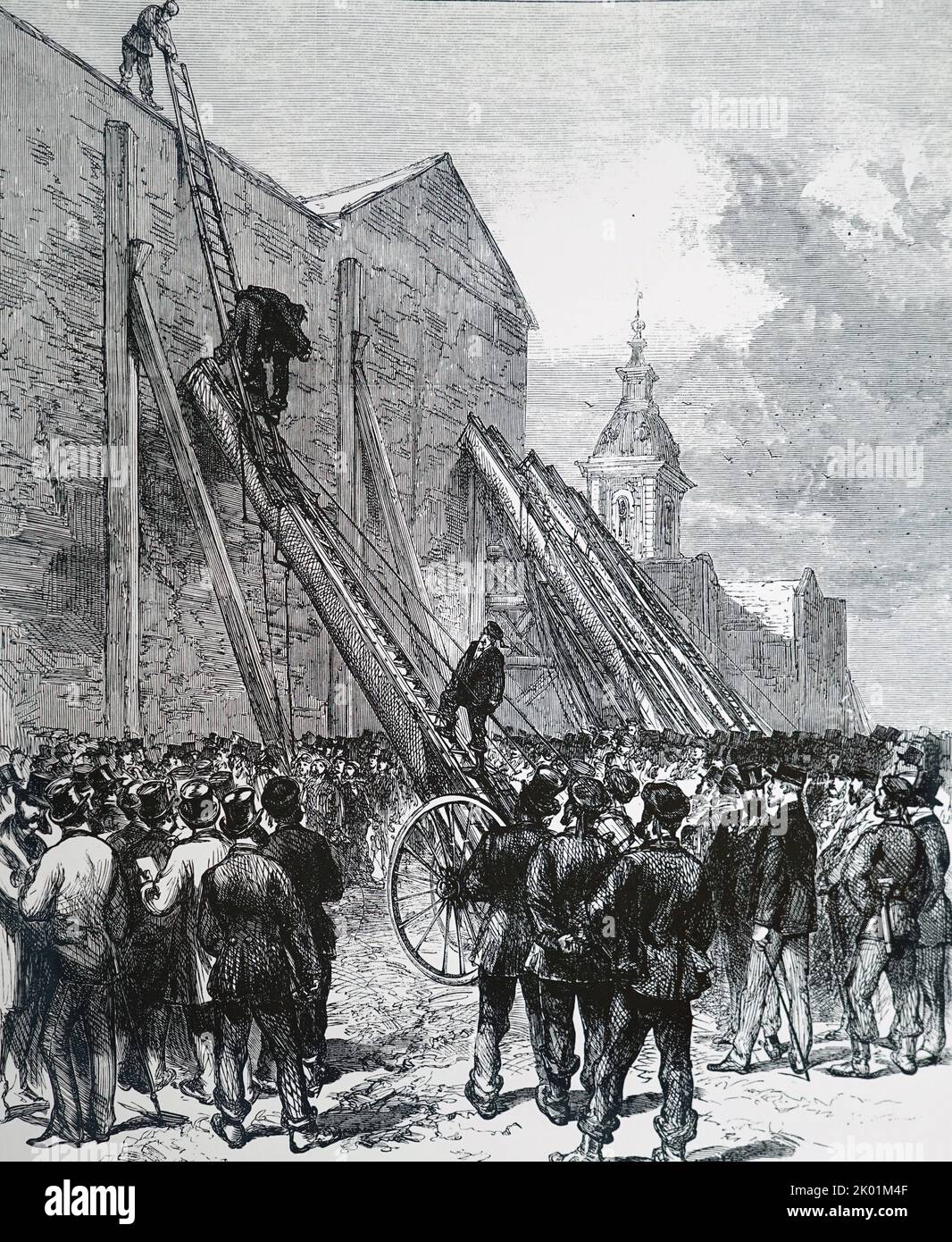 The Metropolitan Fire Brigade testing fire escapes made by EH Bayley & Co. Stock Photohttps://www.alamy.com/image-license-details/?v=1https://www.alamy.com/the-metropolitan-fire-brigade-testing-fire-escapes-made-by-eh-bayley-co-image481928063.html
The Metropolitan Fire Brigade testing fire escapes made by EH Bayley & Co. Stock Photohttps://www.alamy.com/image-license-details/?v=1https://www.alamy.com/the-metropolitan-fire-brigade-testing-fire-escapes-made-by-eh-bayley-co-image481928063.htmlRM2K01M4F–The Metropolitan Fire Brigade testing fire escapes made by EH Bayley & Co.
 Engraving depicting a floating fire engine used on the River Thames. Dated 19th century Stock Photohttps://www.alamy.com/image-license-details/?v=1https://www.alamy.com/engraving-depicting-a-floating-fire-engine-used-on-the-river-thames-dated-19th-century-image186400190.html
Engraving depicting a floating fire engine used on the River Thames. Dated 19th century Stock Photohttps://www.alamy.com/image-license-details/?v=1https://www.alamy.com/engraving-depicting-a-floating-fire-engine-used-on-the-river-thames-dated-19th-century-image186400190.htmlRMMR779J–Engraving depicting a floating fire engine used on the River Thames. Dated 19th century
 The London Fire Brigade at practice on the Thames Embankment, 1868. 'A grand inspection of the engines and firemen belonging to the Metropolitan Fire Brigade...took place...Two floating steam fire-engines on the river, and four land-travelling steam fire-engines, besides a number of the most powerful hand-engines and two fire-escapes, were tried with perfect success; and the men were put through all the manoeuvres of their drill, which they executed with the utmost promptitude and precision. The reorganisation of the Fire Brigade, raising it to its present state of efficiency and completeness Stock Photohttps://www.alamy.com/image-license-details/?v=1https://www.alamy.com/the-london-fire-brigade-at-practice-on-the-thames-embankment-1868-a-grand-inspection-of-the-engines-and-firemen-belonging-to-the-metropolitan-fire-brigadetook-placetwo-floating-steam-fire-engines-on-the-river-and-four-land-travelling-steam-fire-engines-besides-a-number-of-the-most-powerful-hand-engines-and-two-fire-escapes-were-tried-with-perfect-success-and-the-men-were-put-through-all-the-manoeuvres-of-their-drill-which-they-executed-with-the-utmost-promptitude-and-precision-the-reorganisation-of-the-fire-brigade-raising-it-to-its-present-state-of-efficiency-and-completeness-image608998228.html
The London Fire Brigade at practice on the Thames Embankment, 1868. 'A grand inspection of the engines and firemen belonging to the Metropolitan Fire Brigade...took place...Two floating steam fire-engines on the river, and four land-travelling steam fire-engines, besides a number of the most powerful hand-engines and two fire-escapes, were tried with perfect success; and the men were put through all the manoeuvres of their drill, which they executed with the utmost promptitude and precision. The reorganisation of the Fire Brigade, raising it to its present state of efficiency and completeness Stock Photohttps://www.alamy.com/image-license-details/?v=1https://www.alamy.com/the-london-fire-brigade-at-practice-on-the-thames-embankment-1868-a-grand-inspection-of-the-engines-and-firemen-belonging-to-the-metropolitan-fire-brigadetook-placetwo-floating-steam-fire-engines-on-the-river-and-four-land-travelling-steam-fire-engines-besides-a-number-of-the-most-powerful-hand-engines-and-two-fire-escapes-were-tried-with-perfect-success-and-the-men-were-put-through-all-the-manoeuvres-of-their-drill-which-they-executed-with-the-utmost-promptitude-and-precision-the-reorganisation-of-the-fire-brigade-raising-it-to-its-present-state-of-efficiency-and-completeness-image608998228.htmlRM2XAP7CM–The London Fire Brigade at practice on the Thames Embankment, 1868. 'A grand inspection of the engines and firemen belonging to the Metropolitan Fire Brigade...took place...Two floating steam fire-engines on the river, and four land-travelling steam fire-engines, besides a number of the most powerful hand-engines and two fire-escapes, were tried with perfect success; and the men were put through all the manoeuvres of their drill, which they executed with the utmost promptitude and precision. The reorganisation of the Fire Brigade, raising it to its present state of efficiency and completeness
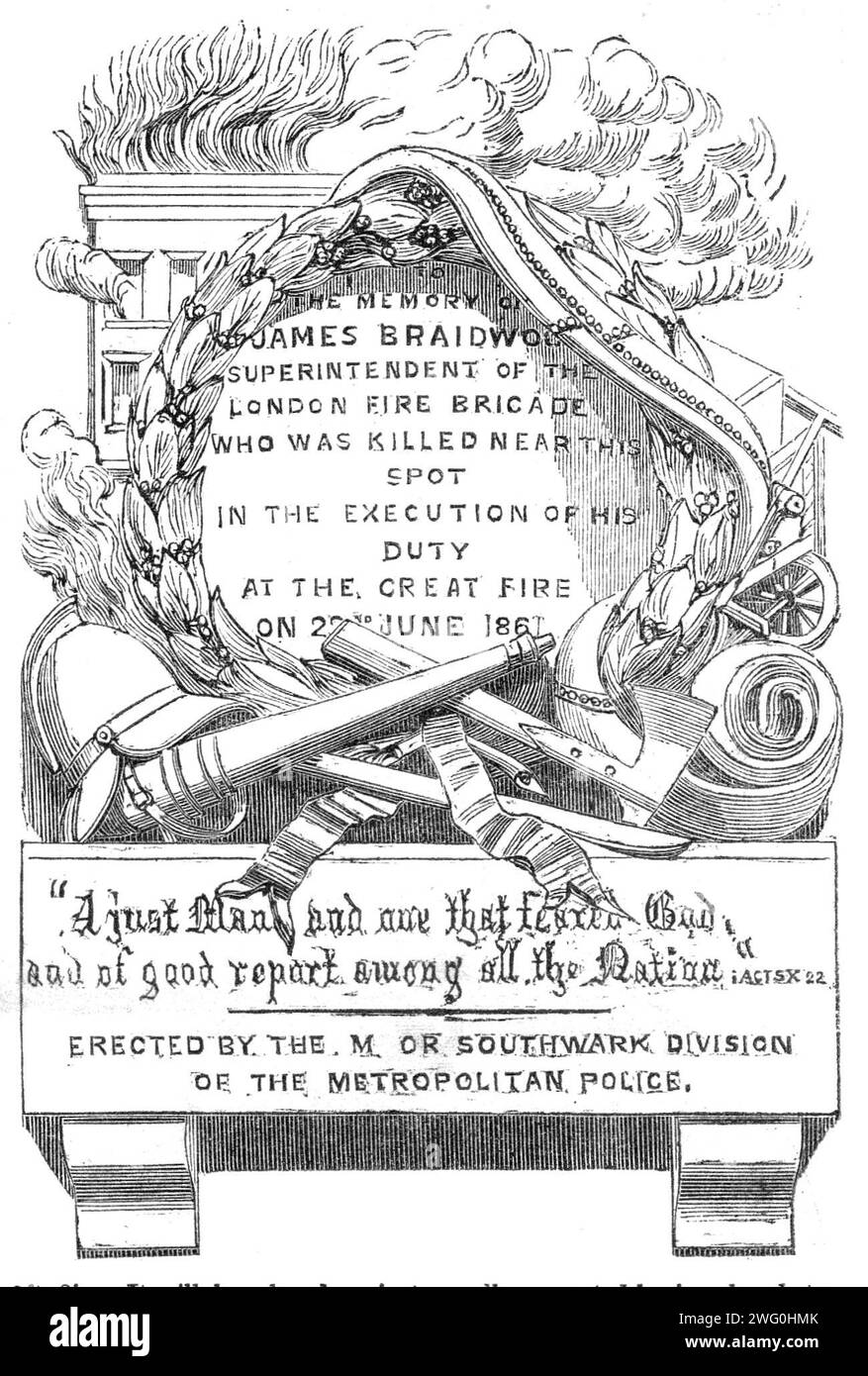 Memorial-stone to the late Mr. Braidwood, 1862. 'The tribute to the memory of the late Mr. Braidwood, Superintendent of the London Fire Brigade, raised by the M division of police, is an effectively-carved monument of Portland stone, designed and executed by Mr. S. H. Gardiner, of the New Kent-road. A wreath of laurel stands out in bold relief, round which entwines a fire-hose, encircling the inscription. At the foot of the wreath, forming the base of the memorial, are carved a fireman's accoutrements, consisting of a helmet, a hose-point, hatchet, crowbar, Ac. On the plinth some lines are ins Stock Photohttps://www.alamy.com/image-license-details/?v=1https://www.alamy.com/memorial-stone-to-the-late-mr-braidwood-1862-the-tribute-to-the-memory-of-the-late-mr-braidwood-superintendent-of-the-london-fire-brigade-raised-by-the-m-division-of-police-is-an-effectively-carved-monument-of-portland-stone-designed-and-executed-by-mr-s-h-gardiner-of-the-new-kent-road-a-wreath-of-laurel-stands-out-in-bold-relief-round-which-entwines-a-fire-hose-encircling-the-inscription-at-the-foot-of-the-wreath-forming-the-base-of-the-memorial-are-carved-a-firemans-accoutrements-consisting-of-a-helmet-a-hose-point-hatchet-crowbar-ac-on-the-plinth-some-lines-are-ins-image595000915.html
Memorial-stone to the late Mr. Braidwood, 1862. 'The tribute to the memory of the late Mr. Braidwood, Superintendent of the London Fire Brigade, raised by the M division of police, is an effectively-carved monument of Portland stone, designed and executed by Mr. S. H. Gardiner, of the New Kent-road. A wreath of laurel stands out in bold relief, round which entwines a fire-hose, encircling the inscription. At the foot of the wreath, forming the base of the memorial, are carved a fireman's accoutrements, consisting of a helmet, a hose-point, hatchet, crowbar, Ac. On the plinth some lines are ins Stock Photohttps://www.alamy.com/image-license-details/?v=1https://www.alamy.com/memorial-stone-to-the-late-mr-braidwood-1862-the-tribute-to-the-memory-of-the-late-mr-braidwood-superintendent-of-the-london-fire-brigade-raised-by-the-m-division-of-police-is-an-effectively-carved-monument-of-portland-stone-designed-and-executed-by-mr-s-h-gardiner-of-the-new-kent-road-a-wreath-of-laurel-stands-out-in-bold-relief-round-which-entwines-a-fire-hose-encircling-the-inscription-at-the-foot-of-the-wreath-forming-the-base-of-the-memorial-are-carved-a-firemans-accoutrements-consisting-of-a-helmet-a-hose-point-hatchet-crowbar-ac-on-the-plinth-some-lines-are-ins-image595000915.htmlRM2WG0HMK–Memorial-stone to the late Mr. Braidwood, 1862. 'The tribute to the memory of the late Mr. Braidwood, Superintendent of the London Fire Brigade, raised by the M division of police, is an effectively-carved monument of Portland stone, designed and executed by Mr. S. H. Gardiner, of the New Kent-road. A wreath of laurel stands out in bold relief, round which entwines a fire-hose, encircling the inscription. At the foot of the wreath, forming the base of the memorial, are carved a fireman's accoutrements, consisting of a helmet, a hose-point, hatchet, crowbar, Ac. On the plinth some lines are ins
![Torch-Light Procession in the Place d'Armes, at Montreal, 1850. '...the citizens of Montreal [in Canada, decided on] the necessity of preparing a suitable display of Canadian industry, for exposition at the Great Industrial Congress of 1851 [to be held in London. It was therefore] '...decided to hold a Grand Provincial Industrial Exhibition, in the city of Montreal'. A celebratory procession was '...conducted by the fire brigade of the city...All the fire companies, with their engines, hose-reels, &c., drawn by horses, richly caparisoned and decorated, formed the procession. They had a mo Stock Photo Torch-Light Procession in the Place d'Armes, at Montreal, 1850. '...the citizens of Montreal [in Canada, decided on] the necessity of preparing a suitable display of Canadian industry, for exposition at the Great Industrial Congress of 1851 [to be held in London. It was therefore] '...decided to hold a Grand Provincial Industrial Exhibition, in the city of Montreal'. A celebratory procession was '...conducted by the fire brigade of the city...All the fire companies, with their engines, hose-reels, &c., drawn by horses, richly caparisoned and decorated, formed the procession. They had a mo Stock Photo](https://c8.alamy.com/comp/2J3H7KK/torch-light-procession-in-the-place-darmes-at-montreal-1850-the-citizens-of-montreal-in-canada-decided-on-the-necessity-of-preparing-a-suitable-display-of-canadian-industry-for-exposition-at-the-great-industrial-congress-of-1851-to-be-held-in-london-it-was-therefore-decided-to-hold-a-grand-provincial-industrial-exhibition-in-the-city-of-montreal-a-celebratory-procession-was-conducted-by-the-fire-brigade-of-the-cityall-the-fire-companies-with-their-engines-hose-reels-ampc-drawn-by-horses-richly-caparisoned-and-decorated-formed-the-procession-they-had-a-mo-2J3H7KK.jpg) Torch-Light Procession in the Place d'Armes, at Montreal, 1850. '...the citizens of Montreal [in Canada, decided on] the necessity of preparing a suitable display of Canadian industry, for exposition at the Great Industrial Congress of 1851 [to be held in London. It was therefore] '...decided to hold a Grand Provincial Industrial Exhibition, in the city of Montreal'. A celebratory procession was '...conducted by the fire brigade of the city...All the fire companies, with their engines, hose-reels, &c., drawn by horses, richly caparisoned and decorated, formed the procession. They had a mo Stock Photohttps://www.alamy.com/image-license-details/?v=1https://www.alamy.com/torch-light-procession-in-the-place-darmes-at-montreal-1850-the-citizens-of-montreal-in-canada-decided-on-the-necessity-of-preparing-a-suitable-display-of-canadian-industry-for-exposition-at-the-great-industrial-congress-of-1851-to-be-held-in-london-it-was-therefore-decided-to-hold-a-grand-provincial-industrial-exhibition-in-the-city-of-montreal-a-celebratory-procession-was-conducted-by-the-fire-brigade-of-the-cityall-the-fire-companies-with-their-engines-hose-reels-ampc-drawn-by-horses-richly-caparisoned-and-decorated-formed-the-procession-they-had-a-mo-image466903127.html
Torch-Light Procession in the Place d'Armes, at Montreal, 1850. '...the citizens of Montreal [in Canada, decided on] the necessity of preparing a suitable display of Canadian industry, for exposition at the Great Industrial Congress of 1851 [to be held in London. It was therefore] '...decided to hold a Grand Provincial Industrial Exhibition, in the city of Montreal'. A celebratory procession was '...conducted by the fire brigade of the city...All the fire companies, with their engines, hose-reels, &c., drawn by horses, richly caparisoned and decorated, formed the procession. They had a mo Stock Photohttps://www.alamy.com/image-license-details/?v=1https://www.alamy.com/torch-light-procession-in-the-place-darmes-at-montreal-1850-the-citizens-of-montreal-in-canada-decided-on-the-necessity-of-preparing-a-suitable-display-of-canadian-industry-for-exposition-at-the-great-industrial-congress-of-1851-to-be-held-in-london-it-was-therefore-decided-to-hold-a-grand-provincial-industrial-exhibition-in-the-city-of-montreal-a-celebratory-procession-was-conducted-by-the-fire-brigade-of-the-cityall-the-fire-companies-with-their-engines-hose-reels-ampc-drawn-by-horses-richly-caparisoned-and-decorated-formed-the-procession-they-had-a-mo-image466903127.htmlRM2J3H7KK–Torch-Light Procession in the Place d'Armes, at Montreal, 1850. '...the citizens of Montreal [in Canada, decided on] the necessity of preparing a suitable display of Canadian industry, for exposition at the Great Industrial Congress of 1851 [to be held in London. It was therefore] '...decided to hold a Grand Provincial Industrial Exhibition, in the city of Montreal'. A celebratory procession was '...conducted by the fire brigade of the city...All the fire companies, with their engines, hose-reels, &c., drawn by horses, richly caparisoned and decorated, formed the procession. They had a mo
 The Fire-Brigade, 1850. Fire in Lambeth, south London: 'In a very short period the window-frames at the back of the houses in the York-road caught fire, and berore any effective means could be adopted to prevent it, the whole range numbered 7, 8, 9, 10, 11, and 12, were enveloped in flame...The firemen worked bravely; but the extent of the catastrophe was appalling'. From "Illustrated London News", 1850. Stock Photohttps://www.alamy.com/image-license-details/?v=1https://www.alamy.com/the-fire-brigade-1850-fire-in-lambeth-south-london-in-a-very-short-period-the-window-frames-at-the-back-of-the-houses-in-the-york-road-caught-fire-and-berore-any-effective-means-could-be-adopted-to-prevent-it-the-whole-range-numbered-7-8-9-10-11-and-12-were-enveloped-in-flamethe-firemen-worked-bravely-but-the-extent-of-the-catastrophe-was-appalling-from-quotillustrated-london-newsquot-1850-image462358838.html
The Fire-Brigade, 1850. Fire in Lambeth, south London: 'In a very short period the window-frames at the back of the houses in the York-road caught fire, and berore any effective means could be adopted to prevent it, the whole range numbered 7, 8, 9, 10, 11, and 12, were enveloped in flame...The firemen worked bravely; but the extent of the catastrophe was appalling'. From "Illustrated London News", 1850. Stock Photohttps://www.alamy.com/image-license-details/?v=1https://www.alamy.com/the-fire-brigade-1850-fire-in-lambeth-south-london-in-a-very-short-period-the-window-frames-at-the-back-of-the-houses-in-the-york-road-caught-fire-and-berore-any-effective-means-could-be-adopted-to-prevent-it-the-whole-range-numbered-7-8-9-10-11-and-12-were-enveloped-in-flamethe-firemen-worked-bravely-but-the-extent-of-the-catastrophe-was-appalling-from-quotillustrated-london-newsquot-1850-image462358838.htmlRM2HT67BJ–The Fire-Brigade, 1850. Fire in Lambeth, south London: 'In a very short period the window-frames at the back of the houses in the York-road caught fire, and berore any effective means could be adopted to prevent it, the whole range numbered 7, 8, 9, 10, 11, and 12, were enveloped in flame...The firemen worked bravely; but the extent of the catastrophe was appalling'. From "Illustrated London News", 1850.
![Chandos-street Fire-Engine Station, [London], 1858. '...one of those places scattered throughout the metropolis where, day and night, a portion of the fire brigade is in readiness to start at a moment's notice to any part of London. At these houses the engines are always in readiness, the horses with their equipments are prepared for instant action, and the men may be said to sleep in harness; so that should an alarm be given in the dead of night the engine is in a few minutes on its way to the place of the fire, rattling over the pavement with that peculiar sound which distinguishes the progr Stock Photo Chandos-street Fire-Engine Station, [London], 1858. '...one of those places scattered throughout the metropolis where, day and night, a portion of the fire brigade is in readiness to start at a moment's notice to any part of London. At these houses the engines are always in readiness, the horses with their equipments are prepared for instant action, and the men may be said to sleep in harness; so that should an alarm be given in the dead of night the engine is in a few minutes on its way to the place of the fire, rattling over the pavement with that peculiar sound which distinguishes the progr Stock Photo](https://c8.alamy.com/comp/2RRJ9W2/chandos-street-fire-engine-station-london-1858-one-of-those-places-scattered-throughout-the-metropolis-where-day-and-night-a-portion-of-the-fire-brigade-is-in-readiness-to-start-at-a-moments-notice-to-any-part-of-london-at-these-houses-the-engines-are-always-in-readiness-the-horses-with-their-equipments-are-prepared-for-instant-action-and-the-men-may-be-said-to-sleep-in-harness-so-that-should-an-alarm-be-given-in-the-dead-of-night-the-engine-is-in-a-few-minutes-on-its-way-to-the-place-of-the-fire-rattling-over-the-pavement-with-that-peculiar-sound-which-distinguishes-the-progr-2RRJ9W2.jpg) Chandos-street Fire-Engine Station, [London], 1858. '...one of those places scattered throughout the metropolis where, day and night, a portion of the fire brigade is in readiness to start at a moment's notice to any part of London. At these houses the engines are always in readiness, the horses with their equipments are prepared for instant action, and the men may be said to sleep in harness; so that should an alarm be given in the dead of night the engine is in a few minutes on its way to the place of the fire, rattling over the pavement with that peculiar sound which distinguishes the progr Stock Photohttps://www.alamy.com/image-license-details/?v=1https://www.alamy.com/chandos-street-fire-engine-station-london-1858-one-of-those-places-scattered-throughout-the-metropolis-where-day-and-night-a-portion-of-the-fire-brigade-is-in-readiness-to-start-at-a-moments-notice-to-any-part-of-london-at-these-houses-the-engines-are-always-in-readiness-the-horses-with-their-equipments-are-prepared-for-instant-action-and-the-men-may-be-said-to-sleep-in-harness-so-that-should-an-alarm-be-given-in-the-dead-of-night-the-engine-is-in-a-few-minutes-on-its-way-to-the-place-of-the-fire-rattling-over-the-pavement-with-that-peculiar-sound-which-distinguishes-the-progr-image565271758.html
Chandos-street Fire-Engine Station, [London], 1858. '...one of those places scattered throughout the metropolis where, day and night, a portion of the fire brigade is in readiness to start at a moment's notice to any part of London. At these houses the engines are always in readiness, the horses with their equipments are prepared for instant action, and the men may be said to sleep in harness; so that should an alarm be given in the dead of night the engine is in a few minutes on its way to the place of the fire, rattling over the pavement with that peculiar sound which distinguishes the progr Stock Photohttps://www.alamy.com/image-license-details/?v=1https://www.alamy.com/chandos-street-fire-engine-station-london-1858-one-of-those-places-scattered-throughout-the-metropolis-where-day-and-night-a-portion-of-the-fire-brigade-is-in-readiness-to-start-at-a-moments-notice-to-any-part-of-london-at-these-houses-the-engines-are-always-in-readiness-the-horses-with-their-equipments-are-prepared-for-instant-action-and-the-men-may-be-said-to-sleep-in-harness-so-that-should-an-alarm-be-given-in-the-dead-of-night-the-engine-is-in-a-few-minutes-on-its-way-to-the-place-of-the-fire-rattling-over-the-pavement-with-that-peculiar-sound-which-distinguishes-the-progr-image565271758.htmlRM2RRJ9W2–Chandos-street Fire-Engine Station, [London], 1858. '...one of those places scattered throughout the metropolis where, day and night, a portion of the fire brigade is in readiness to start at a moment's notice to any part of London. At these houses the engines are always in readiness, the horses with their equipments are prepared for instant action, and the men may be said to sleep in harness; so that should an alarm be given in the dead of night the engine is in a few minutes on its way to the place of the fire, rattling over the pavement with that peculiar sound which distinguishes the progr
!['The Crimean War, 1854-56: The Battle of Balaclava: The Charge of the Light Brigade, October 25, 1854', (1901). Disastrous British cavalry charge, immortalised in Tennyson's poem, in which the Light Brigade suffered 40% casualties as they advanced straight into Russian cannon fire. From "The Illustrated London News Record of the Glorious Reign of Queen Victoria 1837-1901: The Life and Accession of King Edward VII. and the Life of Queen Alexandra". [London, 1901] Stock Photo 'The Crimean War, 1854-56: The Battle of Balaclava: The Charge of the Light Brigade, October 25, 1854', (1901). Disastrous British cavalry charge, immortalised in Tennyson's poem, in which the Light Brigade suffered 40% casualties as they advanced straight into Russian cannon fire. From "The Illustrated London News Record of the Glorious Reign of Queen Victoria 1837-1901: The Life and Accession of King Edward VII. and the Life of Queen Alexandra". [London, 1901] Stock Photo](https://c8.alamy.com/comp/W6P79A/the-crimean-war-1854-56-the-battle-of-balaclava-the-charge-of-the-light-brigade-october-25-1854-1901-disastrous-british-cavalry-charge-immortalised-in-tennysons-poem-in-which-the-light-brigade-suffered-40-casualties-as-they-advanced-straight-into-russian-cannon-fire-from-quotthe-illustrated-london-news-record-of-the-glorious-reign-of-queen-victoria-1837-1901-the-life-and-accession-of-king-edward-vii-and-the-life-of-queen-alexandraquot-london-1901-W6P79A.jpg) 'The Crimean War, 1854-56: The Battle of Balaclava: The Charge of the Light Brigade, October 25, 1854', (1901). Disastrous British cavalry charge, immortalised in Tennyson's poem, in which the Light Brigade suffered 40% casualties as they advanced straight into Russian cannon fire. From "The Illustrated London News Record of the Glorious Reign of Queen Victoria 1837-1901: The Life and Accession of King Edward VII. and the Life of Queen Alexandra". [London, 1901] Stock Photohttps://www.alamy.com/image-license-details/?v=1https://www.alamy.com/the-crimean-war-1854-56-the-battle-of-balaclava-the-charge-of-the-light-brigade-october-25-1854-1901-disastrous-british-cavalry-charge-immortalised-in-tennysons-poem-in-which-the-light-brigade-suffered-40-casualties-as-they-advanced-straight-into-russian-cannon-fire-from-quotthe-illustrated-london-news-record-of-the-glorious-reign-of-queen-victoria-1837-1901-the-life-and-accession-of-king-edward-vii-and-the-life-of-queen-alexandraquot-london-1901-image262332150.html
'The Crimean War, 1854-56: The Battle of Balaclava: The Charge of the Light Brigade, October 25, 1854', (1901). Disastrous British cavalry charge, immortalised in Tennyson's poem, in which the Light Brigade suffered 40% casualties as they advanced straight into Russian cannon fire. From "The Illustrated London News Record of the Glorious Reign of Queen Victoria 1837-1901: The Life and Accession of King Edward VII. and the Life of Queen Alexandra". [London, 1901] Stock Photohttps://www.alamy.com/image-license-details/?v=1https://www.alamy.com/the-crimean-war-1854-56-the-battle-of-balaclava-the-charge-of-the-light-brigade-october-25-1854-1901-disastrous-british-cavalry-charge-immortalised-in-tennysons-poem-in-which-the-light-brigade-suffered-40-casualties-as-they-advanced-straight-into-russian-cannon-fire-from-quotthe-illustrated-london-news-record-of-the-glorious-reign-of-queen-victoria-1837-1901-the-life-and-accession-of-king-edward-vii-and-the-life-of-queen-alexandraquot-london-1901-image262332150.htmlRMW6P79A–'The Crimean War, 1854-56: The Battle of Balaclava: The Charge of the Light Brigade, October 25, 1854', (1901). Disastrous British cavalry charge, immortalised in Tennyson's poem, in which the Light Brigade suffered 40% casualties as they advanced straight into Russian cannon fire. From "The Illustrated London News Record of the Glorious Reign of Queen Victoria 1837-1901: The Life and Accession of King Edward VII. and the Life of Queen Alexandra". [London, 1901]
 Burning of Covent Garden Theatre, 1856 (1897). Artist: Unknown. Stock Photohttps://www.alamy.com/image-license-details/?v=1https://www.alamy.com/burning-of-covent-garden-theatre-1856-1897-artist-unknown-image262783026.html
Burning of Covent Garden Theatre, 1856 (1897). Artist: Unknown. Stock Photohttps://www.alamy.com/image-license-details/?v=1https://www.alamy.com/burning-of-covent-garden-theatre-1856-1897-artist-unknown-image262783026.htmlRMW7EPC2–Burning of Covent Garden Theatre, 1856 (1897). Artist: Unknown.
![Burning of Covent-Garden Theatre, [London], 1856. Inquiry into the cause of the fire: 'John Drake Palmer, gasman, said he had the entire management of the gas-fittings of the theatre, and had fitted up the carpenter's shop with gas just previously to Christmas last. The whole arrangements for lighting the theatre were under the control of himself or his assistants. It was impossible, he thought, for the fire to have originated by reason of any escape of gas in the carpenter's shop. Mr. Henry Sloman, machinist and carpenter to the theatre during the last thirty years, was next examined. He said Stock Photo Burning of Covent-Garden Theatre, [London], 1856. Inquiry into the cause of the fire: 'John Drake Palmer, gasman, said he had the entire management of the gas-fittings of the theatre, and had fitted up the carpenter's shop with gas just previously to Christmas last. The whole arrangements for lighting the theatre were under the control of himself or his assistants. It was impossible, he thought, for the fire to have originated by reason of any escape of gas in the carpenter's shop. Mr. Henry Sloman, machinist and carpenter to the theatre during the last thirty years, was next examined. He said Stock Photo](https://c8.alamy.com/comp/2R4DJ9J/burning-of-covent-garden-theatre-london-1856-inquiry-into-the-cause-of-the-fire-john-drake-palmer-gasman-said-he-had-the-entire-management-of-the-gas-fittings-of-the-theatre-and-had-fitted-up-the-carpenters-shop-with-gas-just-previously-to-christmas-last-the-whole-arrangements-for-lighting-the-theatre-were-under-the-control-of-himself-or-his-assistants-it-was-impossible-he-thought-for-the-fire-to-have-originated-by-reason-of-any-escape-of-gas-in-the-carpenters-shop-mr-henry-sloman-machinist-and-carpenter-to-the-theatre-during-the-last-thirty-years-was-next-examined-he-said-2R4DJ9J.jpg) Burning of Covent-Garden Theatre, [London], 1856. Inquiry into the cause of the fire: 'John Drake Palmer, gasman, said he had the entire management of the gas-fittings of the theatre, and had fitted up the carpenter's shop with gas just previously to Christmas last. The whole arrangements for lighting the theatre were under the control of himself or his assistants. It was impossible, he thought, for the fire to have originated by reason of any escape of gas in the carpenter's shop. Mr. Henry Sloman, machinist and carpenter to the theatre during the last thirty years, was next examined. He said Stock Photohttps://www.alamy.com/image-license-details/?v=1https://www.alamy.com/burning-of-covent-garden-theatre-london-1856-inquiry-into-the-cause-of-the-fire-john-drake-palmer-gasman-said-he-had-the-entire-management-of-the-gas-fittings-of-the-theatre-and-had-fitted-up-the-carpenters-shop-with-gas-just-previously-to-christmas-last-the-whole-arrangements-for-lighting-the-theatre-were-under-the-control-of-himself-or-his-assistants-it-was-impossible-he-thought-for-the-fire-to-have-originated-by-reason-of-any-escape-of-gas-in-the-carpenters-shop-mr-henry-sloman-machinist-and-carpenter-to-the-theatre-during-the-last-thirty-years-was-next-examined-he-said-image553490158.html
Burning of Covent-Garden Theatre, [London], 1856. Inquiry into the cause of the fire: 'John Drake Palmer, gasman, said he had the entire management of the gas-fittings of the theatre, and had fitted up the carpenter's shop with gas just previously to Christmas last. The whole arrangements for lighting the theatre were under the control of himself or his assistants. It was impossible, he thought, for the fire to have originated by reason of any escape of gas in the carpenter's shop. Mr. Henry Sloman, machinist and carpenter to the theatre during the last thirty years, was next examined. He said Stock Photohttps://www.alamy.com/image-license-details/?v=1https://www.alamy.com/burning-of-covent-garden-theatre-london-1856-inquiry-into-the-cause-of-the-fire-john-drake-palmer-gasman-said-he-had-the-entire-management-of-the-gas-fittings-of-the-theatre-and-had-fitted-up-the-carpenters-shop-with-gas-just-previously-to-christmas-last-the-whole-arrangements-for-lighting-the-theatre-were-under-the-control-of-himself-or-his-assistants-it-was-impossible-he-thought-for-the-fire-to-have-originated-by-reason-of-any-escape-of-gas-in-the-carpenters-shop-mr-henry-sloman-machinist-and-carpenter-to-the-theatre-during-the-last-thirty-years-was-next-examined-he-said-image553490158.htmlRM2R4DJ9J–Burning of Covent-Garden Theatre, [London], 1856. Inquiry into the cause of the fire: 'John Drake Palmer, gasman, said he had the entire management of the gas-fittings of the theatre, and had fitted up the carpenter's shop with gas just previously to Christmas last. The whole arrangements for lighting the theatre were under the control of himself or his assistants. It was impossible, he thought, for the fire to have originated by reason of any escape of gas in the carpenter's shop. Mr. Henry Sloman, machinist and carpenter to the theatre during the last thirty years, was next examined. He said
![Ruins of the Great Fire at Bermondsey, [in London], 1850. Firemen at the scene '...of a very extensive conflagration, probably the largest that has occurred in the district for years. The premises on which the fire happened were those of Messrs. H. N. and H. Eason, tanners and leather-dressers...The engine-house stood in about the middle of the principal range, a large lofty barn, in which were 300 loads of bark, of the value of more than £5000, being to the right or north side, and the leather warehouse and another bark store on the left or south side. Almost immediately on the discovery Stock Photo Ruins of the Great Fire at Bermondsey, [in London], 1850. Firemen at the scene '...of a very extensive conflagration, probably the largest that has occurred in the district for years. The premises on which the fire happened were those of Messrs. H. N. and H. Eason, tanners and leather-dressers...The engine-house stood in about the middle of the principal range, a large lofty barn, in which were 300 loads of bark, of the value of more than £5000, being to the right or north side, and the leather warehouse and another bark store on the left or south side. Almost immediately on the discovery Stock Photo](https://c8.alamy.com/comp/2J3H75G/ruins-of-the-great-fire-at-bermondsey-in-london-1850-firemen-at-the-scene-of-a-very-extensive-conflagration-probably-the-largest-that-has-occurred-in-the-district-for-years-the-premises-on-which-the-fire-happened-were-those-of-messrs-h-n-and-h-eason-tanners-and-leather-dressersthe-engine-house-stood-in-about-the-middle-of-the-principal-range-a-large-lofty-barn-in-which-were-300-loads-of-bark-of-the-value-of-more-than-xa35000-being-to-the-right-or-north-side-and-the-leather-warehouse-and-another-bark-store-on-the-left-or-south-side-almost-immediately-on-the-discovery-2J3H75G.jpg) Ruins of the Great Fire at Bermondsey, [in London], 1850. Firemen at the scene '...of a very extensive conflagration, probably the largest that has occurred in the district for years. The premises on which the fire happened were those of Messrs. H. N. and H. Eason, tanners and leather-dressers...The engine-house stood in about the middle of the principal range, a large lofty barn, in which were 300 loads of bark, of the value of more than £5000, being to the right or north side, and the leather warehouse and another bark store on the left or south side. Almost immediately on the discovery Stock Photohttps://www.alamy.com/image-license-details/?v=1https://www.alamy.com/ruins-of-the-great-fire-at-bermondsey-in-london-1850-firemen-at-the-scene-of-a-very-extensive-conflagration-probably-the-largest-that-has-occurred-in-the-district-for-years-the-premises-on-which-the-fire-happened-were-those-of-messrs-h-n-and-h-eason-tanners-and-leather-dressersthe-engine-house-stood-in-about-the-middle-of-the-principal-range-a-large-lofty-barn-in-which-were-300-loads-of-bark-of-the-value-of-more-than-xa35000-being-to-the-right-or-north-side-and-the-leather-warehouse-and-another-bark-store-on-the-left-or-south-side-almost-immediately-on-the-discovery-image466902732.html
Ruins of the Great Fire at Bermondsey, [in London], 1850. Firemen at the scene '...of a very extensive conflagration, probably the largest that has occurred in the district for years. The premises on which the fire happened were those of Messrs. H. N. and H. Eason, tanners and leather-dressers...The engine-house stood in about the middle of the principal range, a large lofty barn, in which were 300 loads of bark, of the value of more than £5000, being to the right or north side, and the leather warehouse and another bark store on the left or south side. Almost immediately on the discovery Stock Photohttps://www.alamy.com/image-license-details/?v=1https://www.alamy.com/ruins-of-the-great-fire-at-bermondsey-in-london-1850-firemen-at-the-scene-of-a-very-extensive-conflagration-probably-the-largest-that-has-occurred-in-the-district-for-years-the-premises-on-which-the-fire-happened-were-those-of-messrs-h-n-and-h-eason-tanners-and-leather-dressersthe-engine-house-stood-in-about-the-middle-of-the-principal-range-a-large-lofty-barn-in-which-were-300-loads-of-bark-of-the-value-of-more-than-xa35000-being-to-the-right-or-north-side-and-the-leather-warehouse-and-another-bark-store-on-the-left-or-south-side-almost-immediately-on-the-discovery-image466902732.htmlRM2J3H75G–Ruins of the Great Fire at Bermondsey, [in London], 1850. Firemen at the scene '...of a very extensive conflagration, probably the largest that has occurred in the district for years. The premises on which the fire happened were those of Messrs. H. N. and H. Eason, tanners and leather-dressers...The engine-house stood in about the middle of the principal range, a large lofty barn, in which were 300 loads of bark, of the value of more than £5000, being to the right or north side, and the leather warehouse and another bark store on the left or south side. Almost immediately on the discovery
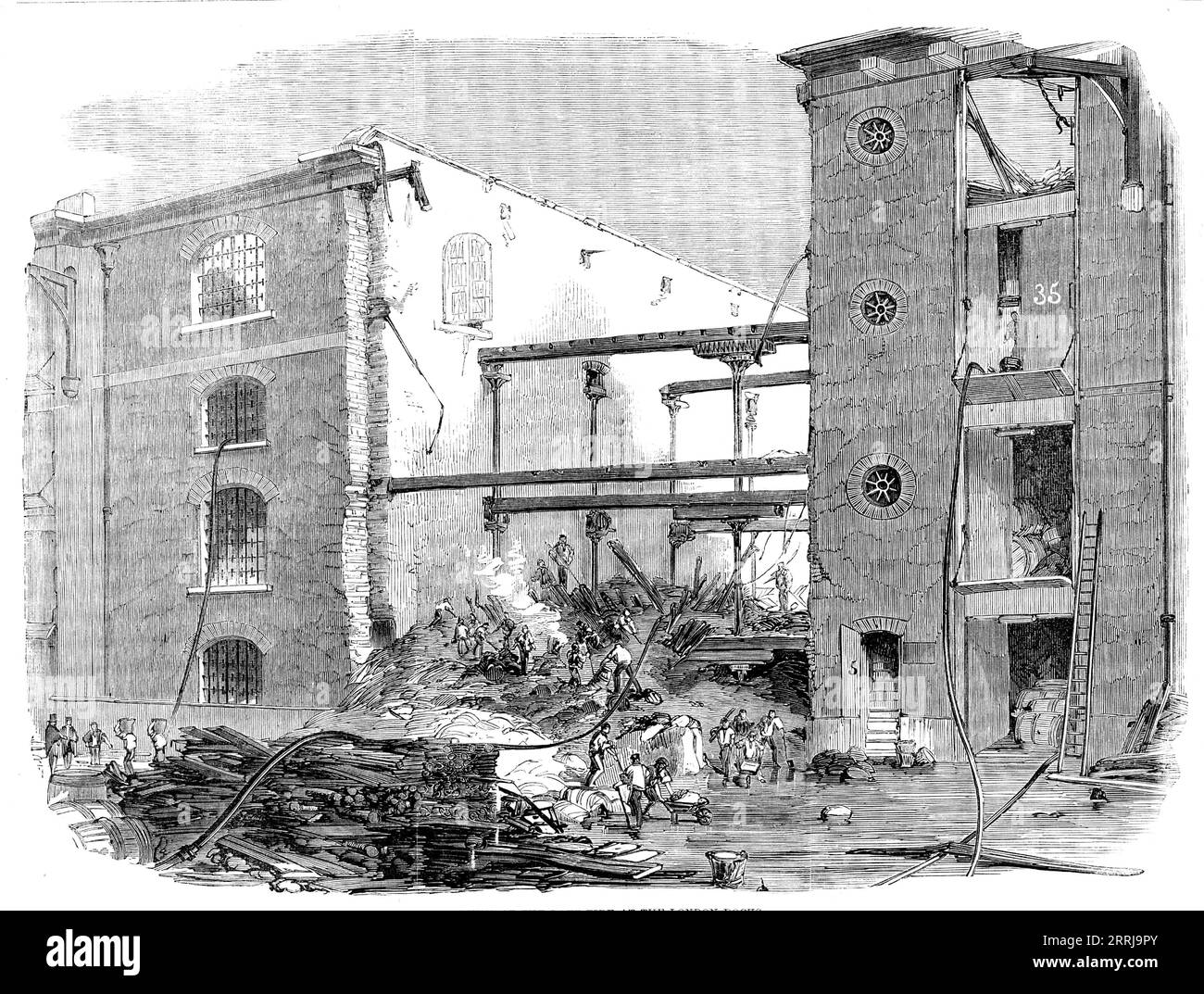 Ruins of the Late Fire at the London Docks, 1858. The fire '...originated in the South Stack Warehouse on the South Quay building, several floors high, each filled with gutta percha, saltpetre, sugar, jute, cider, hemp, ropes, cochineal, saffron, and drugs of great value. To save warehouses containing such combustibles as these proved impossible, and the flames soon got complete possession. The engines arrived very quickly, but torrents of water made no impression on the flames...Just as the conflagration was at its height the gutta percha and indiarubber ran in a state of ignition amongst som Stock Photohttps://www.alamy.com/image-license-details/?v=1https://www.alamy.com/ruins-of-the-late-fire-at-the-london-docks-1858-the-fire-originated-in-the-south-stack-warehouse-on-the-south-quay-building-several-floors-high-each-filled-with-gutta-percha-saltpetre-sugar-jute-cider-hemp-ropes-cochineal-saffron-and-drugs-of-great-value-to-save-warehouses-containing-such-combustibles-as-these-proved-impossible-and-the-flames-soon-got-complete-possession-the-engines-arrived-very-quickly-but-torrents-of-water-made-no-impression-on-the-flamesjust-as-the-conflagration-was-at-its-height-the-gutta-percha-and-indiarubber-ran-in-a-state-of-ignition-amongst-som-image565271699.html
Ruins of the Late Fire at the London Docks, 1858. The fire '...originated in the South Stack Warehouse on the South Quay building, several floors high, each filled with gutta percha, saltpetre, sugar, jute, cider, hemp, ropes, cochineal, saffron, and drugs of great value. To save warehouses containing such combustibles as these proved impossible, and the flames soon got complete possession. The engines arrived very quickly, but torrents of water made no impression on the flames...Just as the conflagration was at its height the gutta percha and indiarubber ran in a state of ignition amongst som Stock Photohttps://www.alamy.com/image-license-details/?v=1https://www.alamy.com/ruins-of-the-late-fire-at-the-london-docks-1858-the-fire-originated-in-the-south-stack-warehouse-on-the-south-quay-building-several-floors-high-each-filled-with-gutta-percha-saltpetre-sugar-jute-cider-hemp-ropes-cochineal-saffron-and-drugs-of-great-value-to-save-warehouses-containing-such-combustibles-as-these-proved-impossible-and-the-flames-soon-got-complete-possession-the-engines-arrived-very-quickly-but-torrents-of-water-made-no-impression-on-the-flamesjust-as-the-conflagration-was-at-its-height-the-gutta-percha-and-indiarubber-ran-in-a-state-of-ignition-amongst-som-image565271699.htmlRM2RRJ9PY–Ruins of the Late Fire at the London Docks, 1858. The fire '...originated in the South Stack Warehouse on the South Quay building, several floors high, each filled with gutta percha, saltpetre, sugar, jute, cider, hemp, ropes, cochineal, saffron, and drugs of great value. To save warehouses containing such combustibles as these proved impossible, and the flames soon got complete possession. The engines arrived very quickly, but torrents of water made no impression on the flames...Just as the conflagration was at its height the gutta percha and indiarubber ran in a state of ignition amongst som
![Arrival of the King of the French during the fire, 1844. Firefighters at New Cross railway station in south-east London: 'His Majesty the King [Louis Philippe] arrived at the station at about eleven o'clock,and on alighting, expressed his great regret at the calamity...One of the most fearful fires that have occurred in the neighbourhood of the metropolis for many years took place...at the works attached to the station of the South Eastern, Brighton, and Croydon Railways at New-cross, resulting in the destruction of property to an enormous amount...It consists of an assemblage of vast workshop Stock Photo Arrival of the King of the French during the fire, 1844. Firefighters at New Cross railway station in south-east London: 'His Majesty the King [Louis Philippe] arrived at the station at about eleven o'clock,and on alighting, expressed his great regret at the calamity...One of the most fearful fires that have occurred in the neighbourhood of the metropolis for many years took place...at the works attached to the station of the South Eastern, Brighton, and Croydon Railways at New-cross, resulting in the destruction of property to an enormous amount...It consists of an assemblage of vast workshop Stock Photo](https://c8.alamy.com/comp/2DCBW7N/arrival-of-the-king-of-the-french-during-the-fire-1844-firefighters-at-new-cross-railway-station-in-south-east-london-his-majesty-the-king-louis-philippe-arrived-at-the-station-at-about-eleven-oclockand-on-alighting-expressed-his-great-regret-at-the-calamityone-of-the-most-fearful-fires-that-have-occurred-in-the-neighbourhood-of-the-metropolis-for-many-years-took-placeat-the-works-attached-to-the-station-of-the-south-eastern-brighton-and-croydon-railways-at-new-cross-resulting-in-the-destruction-of-property-to-an-enormous-amountit-consists-of-an-assemblage-of-vast-workshop-2DCBW7N.jpg) Arrival of the King of the French during the fire, 1844. Firefighters at New Cross railway station in south-east London: 'His Majesty the King [Louis Philippe] arrived at the station at about eleven o'clock,and on alighting, expressed his great regret at the calamity...One of the most fearful fires that have occurred in the neighbourhood of the metropolis for many years took place...at the works attached to the station of the South Eastern, Brighton, and Croydon Railways at New-cross, resulting in the destruction of property to an enormous amount...It consists of an assemblage of vast workshop Stock Photohttps://www.alamy.com/image-license-details/?v=1https://www.alamy.com/arrival-of-the-king-of-the-french-during-the-fire-1844-firefighters-at-new-cross-railway-station-in-south-east-london-his-majesty-the-king-louis-philippe-arrived-at-the-station-at-about-eleven-oclockand-on-alighting-expressed-his-great-regret-at-the-calamityone-of-the-most-fearful-fires-that-have-occurred-in-the-neighbourhood-of-the-metropolis-for-many-years-took-placeat-the-works-attached-to-the-station-of-the-south-eastern-brighton-and-croydon-railways-at-new-cross-resulting-in-the-destruction-of-property-to-an-enormous-amountit-consists-of-an-assemblage-of-vast-workshop-image386265257.html
Arrival of the King of the French during the fire, 1844. Firefighters at New Cross railway station in south-east London: 'His Majesty the King [Louis Philippe] arrived at the station at about eleven o'clock,and on alighting, expressed his great regret at the calamity...One of the most fearful fires that have occurred in the neighbourhood of the metropolis for many years took place...at the works attached to the station of the South Eastern, Brighton, and Croydon Railways at New-cross, resulting in the destruction of property to an enormous amount...It consists of an assemblage of vast workshop Stock Photohttps://www.alamy.com/image-license-details/?v=1https://www.alamy.com/arrival-of-the-king-of-the-french-during-the-fire-1844-firefighters-at-new-cross-railway-station-in-south-east-london-his-majesty-the-king-louis-philippe-arrived-at-the-station-at-about-eleven-oclockand-on-alighting-expressed-his-great-regret-at-the-calamityone-of-the-most-fearful-fires-that-have-occurred-in-the-neighbourhood-of-the-metropolis-for-many-years-took-placeat-the-works-attached-to-the-station-of-the-south-eastern-brighton-and-croydon-railways-at-new-cross-resulting-in-the-destruction-of-property-to-an-enormous-amountit-consists-of-an-assemblage-of-vast-workshop-image386265257.htmlRM2DCBW7N–Arrival of the King of the French during the fire, 1844. Firefighters at New Cross railway station in south-east London: 'His Majesty the King [Louis Philippe] arrived at the station at about eleven o'clock,and on alighting, expressed his great regret at the calamity...One of the most fearful fires that have occurred in the neighbourhood of the metropolis for many years took place...at the works attached to the station of the South Eastern, Brighton, and Croydon Railways at New-cross, resulting in the destruction of property to an enormous amount...It consists of an assemblage of vast workshop
![Scene of the fire at Dockhead, Bermondsey, [London], sketched on Saturday morning, 1864. 'a great fire broke out in the waterside premises of Messrs. Barry Brothers, wharfingers and saltpetre merchants...The warehouses...contained many thousand tons of saltpetre, and, as a strong wind was blowing...the piles and blocks of saltpetre caught fire one after another, sending forth immense volumes of brightly-coloured flame and scattering smoke, ashes, and sparks...Adjoining this capacious warehouse stood another...termed the H Extension Warehouse. This building was filled with several thousand bale Stock Photo Scene of the fire at Dockhead, Bermondsey, [London], sketched on Saturday morning, 1864. 'a great fire broke out in the waterside premises of Messrs. Barry Brothers, wharfingers and saltpetre merchants...The warehouses...contained many thousand tons of saltpetre, and, as a strong wind was blowing...the piles and blocks of saltpetre caught fire one after another, sending forth immense volumes of brightly-coloured flame and scattering smoke, ashes, and sparks...Adjoining this capacious warehouse stood another...termed the H Extension Warehouse. This building was filled with several thousand bale Stock Photo](https://c8.alamy.com/comp/2WRGX6A/scene-of-the-fire-at-dockhead-bermondsey-london-sketched-on-saturday-morning-1864-a-great-fire-broke-out-in-the-waterside-premises-of-messrs-barry-brothers-wharfingers-and-saltpetre-merchantsthe-warehousescontained-many-thousand-tons-of-saltpetre-and-as-a-strong-wind-was-blowingthe-piles-and-blocks-of-saltpetre-caught-fire-one-after-another-sending-forth-immense-volumes-of-brightly-coloured-flame-and-scattering-smoke-ashes-and-sparksadjoining-this-capacious-warehouse-stood-anothertermed-the-h-extension-warehouse-this-building-was-filled-with-several-thousand-bale-2WRGX6A.jpg) Scene of the fire at Dockhead, Bermondsey, [London], sketched on Saturday morning, 1864. 'a great fire broke out in the waterside premises of Messrs. Barry Brothers, wharfingers and saltpetre merchants...The warehouses...contained many thousand tons of saltpetre, and, as a strong wind was blowing...the piles and blocks of saltpetre caught fire one after another, sending forth immense volumes of brightly-coloured flame and scattering smoke, ashes, and sparks...Adjoining this capacious warehouse stood another...termed the H Extension Warehouse. This building was filled with several thousand bale Stock Photohttps://www.alamy.com/image-license-details/?v=1https://www.alamy.com/scene-of-the-fire-at-dockhead-bermondsey-london-sketched-on-saturday-morning-1864-a-great-fire-broke-out-in-the-waterside-premises-of-messrs-barry-brothers-wharfingers-and-saltpetre-merchantsthe-warehousescontained-many-thousand-tons-of-saltpetre-and-as-a-strong-wind-was-blowingthe-piles-and-blocks-of-saltpetre-caught-fire-one-after-another-sending-forth-immense-volumes-of-brightly-coloured-flame-and-scattering-smoke-ashes-and-sparksadjoining-this-capacious-warehouse-stood-anothertermed-the-h-extension-warehouse-this-building-was-filled-with-several-thousand-bale-image599661394.html
Scene of the fire at Dockhead, Bermondsey, [London], sketched on Saturday morning, 1864. 'a great fire broke out in the waterside premises of Messrs. Barry Brothers, wharfingers and saltpetre merchants...The warehouses...contained many thousand tons of saltpetre, and, as a strong wind was blowing...the piles and blocks of saltpetre caught fire one after another, sending forth immense volumes of brightly-coloured flame and scattering smoke, ashes, and sparks...Adjoining this capacious warehouse stood another...termed the H Extension Warehouse. This building was filled with several thousand bale Stock Photohttps://www.alamy.com/image-license-details/?v=1https://www.alamy.com/scene-of-the-fire-at-dockhead-bermondsey-london-sketched-on-saturday-morning-1864-a-great-fire-broke-out-in-the-waterside-premises-of-messrs-barry-brothers-wharfingers-and-saltpetre-merchantsthe-warehousescontained-many-thousand-tons-of-saltpetre-and-as-a-strong-wind-was-blowingthe-piles-and-blocks-of-saltpetre-caught-fire-one-after-another-sending-forth-immense-volumes-of-brightly-coloured-flame-and-scattering-smoke-ashes-and-sparksadjoining-this-capacious-warehouse-stood-anothertermed-the-h-extension-warehouse-this-building-was-filled-with-several-thousand-bale-image599661394.htmlRM2WRGX6A–Scene of the fire at Dockhead, Bermondsey, [London], sketched on Saturday morning, 1864. 'a great fire broke out in the waterside premises of Messrs. Barry Brothers, wharfingers and saltpetre merchants...The warehouses...contained many thousand tons of saltpetre, and, as a strong wind was blowing...the piles and blocks of saltpetre caught fire one after another, sending forth immense volumes of brightly-coloured flame and scattering smoke, ashes, and sparks...Adjoining this capacious warehouse stood another...termed the H Extension Warehouse. This building was filled with several thousand bale
![The Great Fire at Rotherhithe, [east London], 1871. 'The fire which broke out, a quarter before five in the morning, in a phosphate-manure warehouse, and spread to the adjacent granaries, shipwrights' storehouses, and other premises, consumed a vast amount of property...a policeman...gave the alarm and sent for the engines. They came, one after another, to the number of eleven,...with four floating engines; the firemen numbered 139 in all. The water supply was very bad, and it was three quarters of an hour from the discovery of the fire before any could be obtained...Unfortunately, the tide wa Stock Photo The Great Fire at Rotherhithe, [east London], 1871. 'The fire which broke out, a quarter before five in the morning, in a phosphate-manure warehouse, and spread to the adjacent granaries, shipwrights' storehouses, and other premises, consumed a vast amount of property...a policeman...gave the alarm and sent for the engines. They came, one after another, to the number of eleven,...with four floating engines; the firemen numbered 139 in all. The water supply was very bad, and it was three quarters of an hour from the discovery of the fire before any could be obtained...Unfortunately, the tide wa Stock Photo](https://c8.alamy.com/comp/2Y3C008/the-great-fire-at-rotherhithe-east-london-1871-the-fire-which-broke-out-a-quarter-before-five-in-the-morning-in-a-phosphate-manure-warehouse-and-spread-to-the-adjacent-granaries-shipwrights-storehouses-and-other-premises-consumed-a-vast-amount-of-propertya-policemangave-the-alarm-and-sent-for-the-engines-they-came-one-after-another-to-the-number-of-elevenwith-four-floating-engines-the-firemen-numbered-139-in-all-the-water-supply-was-very-bad-and-it-was-three-quarters-of-an-hour-from-the-discovery-of-the-fire-before-any-could-be-obtainedunfortunately-the-tide-wa-2Y3C008.jpg) The Great Fire at Rotherhithe, [east London], 1871. 'The fire which broke out, a quarter before five in the morning, in a phosphate-manure warehouse, and spread to the adjacent granaries, shipwrights' storehouses, and other premises, consumed a vast amount of property...a policeman...gave the alarm and sent for the engines. They came, one after another, to the number of eleven,...with four floating engines; the firemen numbered 139 in all. The water supply was very bad, and it was three quarters of an hour from the discovery of the fire before any could be obtained...Unfortunately, the tide wa Stock Photohttps://www.alamy.com/image-license-details/?v=1https://www.alamy.com/the-great-fire-at-rotherhithe-east-london-1871-the-fire-which-broke-out-a-quarter-before-five-in-the-morning-in-a-phosphate-manure-warehouse-and-spread-to-the-adjacent-granaries-shipwrights-storehouses-and-other-premises-consumed-a-vast-amount-of-propertya-policemangave-the-alarm-and-sent-for-the-engines-they-came-one-after-another-to-the-number-of-elevenwith-four-floating-engines-the-firemen-numbered-139-in-all-the-water-supply-was-very-bad-and-it-was-three-quarters-of-an-hour-from-the-discovery-of-the-fire-before-any-could-be-obtainedunfortunately-the-tide-wa-image621680648.html
The Great Fire at Rotherhithe, [east London], 1871. 'The fire which broke out, a quarter before five in the morning, in a phosphate-manure warehouse, and spread to the adjacent granaries, shipwrights' storehouses, and other premises, consumed a vast amount of property...a policeman...gave the alarm and sent for the engines. They came, one after another, to the number of eleven,...with four floating engines; the firemen numbered 139 in all. The water supply was very bad, and it was three quarters of an hour from the discovery of the fire before any could be obtained...Unfortunately, the tide wa Stock Photohttps://www.alamy.com/image-license-details/?v=1https://www.alamy.com/the-great-fire-at-rotherhithe-east-london-1871-the-fire-which-broke-out-a-quarter-before-five-in-the-morning-in-a-phosphate-manure-warehouse-and-spread-to-the-adjacent-granaries-shipwrights-storehouses-and-other-premises-consumed-a-vast-amount-of-propertya-policemangave-the-alarm-and-sent-for-the-engines-they-came-one-after-another-to-the-number-of-elevenwith-four-floating-engines-the-firemen-numbered-139-in-all-the-water-supply-was-very-bad-and-it-was-three-quarters-of-an-hour-from-the-discovery-of-the-fire-before-any-could-be-obtainedunfortunately-the-tide-wa-image621680648.htmlRM2Y3C008–The Great Fire at Rotherhithe, [east London], 1871. 'The fire which broke out, a quarter before five in the morning, in a phosphate-manure warehouse, and spread to the adjacent granaries, shipwrights' storehouses, and other premises, consumed a vast amount of property...a policeman...gave the alarm and sent for the engines. They came, one after another, to the number of eleven,...with four floating engines; the firemen numbered 139 in all. The water supply was very bad, and it was three quarters of an hour from the discovery of the fire before any could be obtained...Unfortunately, the tide wa
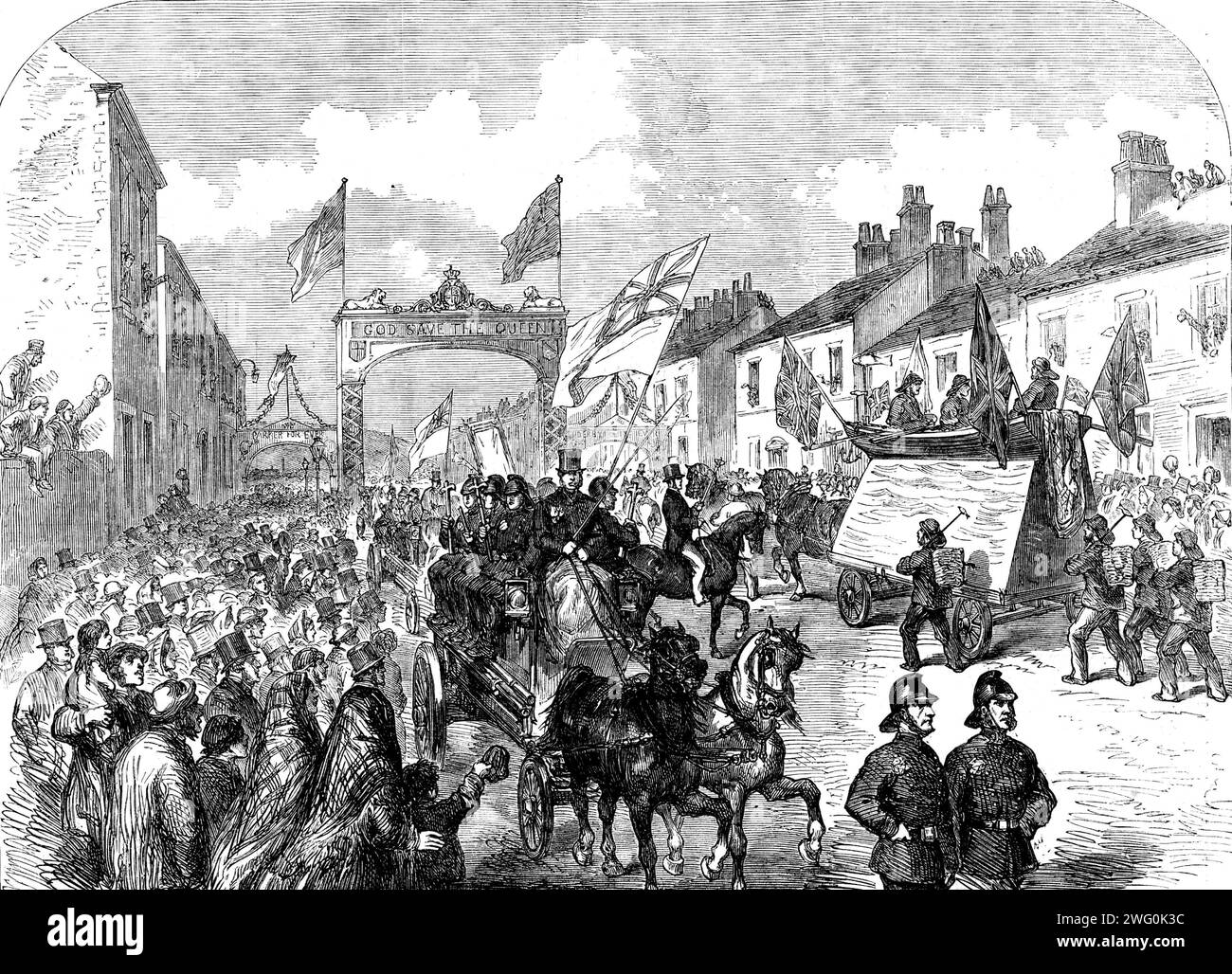 The Preston Guild Festival: the Trades Procession doubling at the triumphal arch, London-road, 1862. 'The trades...had each their appropriate emblems and banners, and a band. Some of the devices were most ingenious and remarkable; the workmen practising the several trades walked in pairs after the banner, the band, and the respective lurry which described their callings. All were neatly dressed, many wore rosettes, and the number of trade emblems and lesser flags which they carried was more than one could count. The fire brigade made a good show; and the procession of the fishermen attracted c Stock Photohttps://www.alamy.com/image-license-details/?v=1https://www.alamy.com/the-preston-guild-festival-the-trades-procession-doubling-at-the-triumphal-arch-london-road-1862-the-tradeshad-each-their-appropriate-emblems-and-banners-and-a-band-some-of-the-devices-were-most-ingenious-and-remarkable-the-workmen-practising-the-several-trades-walked-in-pairs-after-the-banner-the-band-and-the-respective-lurry-which-described-their-callings-all-were-neatly-dressed-many-wore-rosettes-and-the-number-of-trade-emblems-and-lesser-flags-which-they-carried-was-more-than-one-could-count-the-fire-brigade-made-a-good-show-and-the-procession-of-the-fishermen-attracted-c-image595002000.html
The Preston Guild Festival: the Trades Procession doubling at the triumphal arch, London-road, 1862. 'The trades...had each their appropriate emblems and banners, and a band. Some of the devices were most ingenious and remarkable; the workmen practising the several trades walked in pairs after the banner, the band, and the respective lurry which described their callings. All were neatly dressed, many wore rosettes, and the number of trade emblems and lesser flags which they carried was more than one could count. The fire brigade made a good show; and the procession of the fishermen attracted c Stock Photohttps://www.alamy.com/image-license-details/?v=1https://www.alamy.com/the-preston-guild-festival-the-trades-procession-doubling-at-the-triumphal-arch-london-road-1862-the-tradeshad-each-their-appropriate-emblems-and-banners-and-a-band-some-of-the-devices-were-most-ingenious-and-remarkable-the-workmen-practising-the-several-trades-walked-in-pairs-after-the-banner-the-band-and-the-respective-lurry-which-described-their-callings-all-were-neatly-dressed-many-wore-rosettes-and-the-number-of-trade-emblems-and-lesser-flags-which-they-carried-was-more-than-one-could-count-the-fire-brigade-made-a-good-show-and-the-procession-of-the-fishermen-attracted-c-image595002000.htmlRM2WG0K3C–The Preston Guild Festival: the Trades Procession doubling at the triumphal arch, London-road, 1862. 'The trades...had each their appropriate emblems and banners, and a band. Some of the devices were most ingenious and remarkable; the workmen practising the several trades walked in pairs after the banner, the band, and the respective lurry which described their callings. All were neatly dressed, many wore rosettes, and the number of trade emblems and lesser flags which they carried was more than one could count. The fire brigade made a good show; and the procession of the fishermen attracted c
![Leith Pier on fire, 1871. 'Last Saturday, between 800 and 900 yards of the West Pier at Leith [a port area in the north of Edinburgh, Scotland], was destroyed by fire'. From "Illustrated London News", 1871. Stock Photo Leith Pier on fire, 1871. 'Last Saturday, between 800 and 900 yards of the West Pier at Leith [a port area in the north of Edinburgh, Scotland], was destroyed by fire'. From "Illustrated London News", 1871. Stock Photo](https://c8.alamy.com/comp/2Y3BYW9/leith-pier-on-fire-1871-last-saturday-between-800-and-900-yards-of-the-west-pier-at-leith-a-port-area-in-the-north-of-edinburgh-scotland-was-destroyed-by-fire-from-quotillustrated-london-newsquot-1871-2Y3BYW9.jpg) Leith Pier on fire, 1871. 'Last Saturday, between 800 and 900 yards of the West Pier at Leith [a port area in the north of Edinburgh, Scotland], was destroyed by fire'. From "Illustrated London News", 1871. Stock Photohttps://www.alamy.com/image-license-details/?v=1https://www.alamy.com/leith-pier-on-fire-1871-last-saturday-between-800-and-900-yards-of-the-west-pier-at-leith-a-port-area-in-the-north-of-edinburgh-scotland-was-destroyed-by-fire-from-quotillustrated-london-newsquot-1871-image621680565.html
Leith Pier on fire, 1871. 'Last Saturday, between 800 and 900 yards of the West Pier at Leith [a port area in the north of Edinburgh, Scotland], was destroyed by fire'. From "Illustrated London News", 1871. Stock Photohttps://www.alamy.com/image-license-details/?v=1https://www.alamy.com/leith-pier-on-fire-1871-last-saturday-between-800-and-900-yards-of-the-west-pier-at-leith-a-port-area-in-the-north-of-edinburgh-scotland-was-destroyed-by-fire-from-quotillustrated-london-newsquot-1871-image621680565.htmlRM2Y3BYW9–Leith Pier on fire, 1871. 'Last Saturday, between 800 and 900 yards of the West Pier at Leith [a port area in the north of Edinburgh, Scotland], was destroyed by fire'. From "Illustrated London News", 1871.
 Burning of Irwell Buildings, Manchester, 1844. Firefighters attempting to extinguish a fire: 'The night was somewhat stormy; occasionally heavy showers fell, but without producing the slightest effect on the fire ; and the wind, which was high and gusty, carried the flames across the Parsonage to the Blackfriars Inn...'. From "Illustrated London News", 1844, Vol I. Stock Photohttps://www.alamy.com/image-license-details/?v=1https://www.alamy.com/burning-of-irwell-buildings-manchester-1844-firefighters-attempting-to-extinguish-a-fire-the-night-was-somewhat-stormy-occasionally-heavy-showers-fell-but-without-producing-the-slightest-effect-on-the-fire-and-the-wind-which-was-high-and-gusty-carried-the-flames-across-the-parsonage-to-the-blackfriars-inn-from-quotillustrated-london-newsquot-1844-vol-i-image386265642.html
Burning of Irwell Buildings, Manchester, 1844. Firefighters attempting to extinguish a fire: 'The night was somewhat stormy; occasionally heavy showers fell, but without producing the slightest effect on the fire ; and the wind, which was high and gusty, carried the flames across the Parsonage to the Blackfriars Inn...'. From "Illustrated London News", 1844, Vol I. Stock Photohttps://www.alamy.com/image-license-details/?v=1https://www.alamy.com/burning-of-irwell-buildings-manchester-1844-firefighters-attempting-to-extinguish-a-fire-the-night-was-somewhat-stormy-occasionally-heavy-showers-fell-but-without-producing-the-slightest-effect-on-the-fire-and-the-wind-which-was-high-and-gusty-carried-the-flames-across-the-parsonage-to-the-blackfriars-inn-from-quotillustrated-london-newsquot-1844-vol-i-image386265642.htmlRM2DCBWNE–Burning of Irwell Buildings, Manchester, 1844. Firefighters attempting to extinguish a fire: 'The night was somewhat stormy; occasionally heavy showers fell, but without producing the slightest effect on the fire ; and the wind, which was high and gusty, carried the flames across the Parsonage to the Blackfriars Inn...'. From "Illustrated London News", 1844, Vol I.
 Fire at Richmond, 1844. A crowd outside the Cricketers' Tavern, Greenside, Richmond, west London: '...the policeman on duty, whilst going past the Cricketers, observed smoke issuing through the crevices of the shutters. He raised an alarm; and, on the door being forced open, the whole of the bar was found to be in flames. The engines soon arrived, but the flames had got such a hold of the building, that they were of very little use'. From "Illustrated London News", 1844, Vol V. Stock Photohttps://www.alamy.com/image-license-details/?v=1https://www.alamy.com/fire-at-richmond-1844-a-crowd-outside-the-cricketers-tavern-greenside-richmond-west-london-the-policeman-on-duty-whilst-going-past-the-cricketers-observed-smoke-issuing-through-the-crevices-of-the-shutters-he-raised-an-alarm-and-on-the-door-being-forced-open-the-whole-of-the-bar-was-found-to-be-in-flames-the-engines-soon-arrived-but-the-flames-had-got-such-a-hold-of-the-building-that-they-were-of-very-little-use-from-quotillustrated-london-newsquot-1844-vol-v-image397471155.html
Fire at Richmond, 1844. A crowd outside the Cricketers' Tavern, Greenside, Richmond, west London: '...the policeman on duty, whilst going past the Cricketers, observed smoke issuing through the crevices of the shutters. He raised an alarm; and, on the door being forced open, the whole of the bar was found to be in flames. The engines soon arrived, but the flames had got such a hold of the building, that they were of very little use'. From "Illustrated London News", 1844, Vol V. Stock Photohttps://www.alamy.com/image-license-details/?v=1https://www.alamy.com/fire-at-richmond-1844-a-crowd-outside-the-cricketers-tavern-greenside-richmond-west-london-the-policeman-on-duty-whilst-going-past-the-cricketers-observed-smoke-issuing-through-the-crevices-of-the-shutters-he-raised-an-alarm-and-on-the-door-being-forced-open-the-whole-of-the-bar-was-found-to-be-in-flames-the-engines-soon-arrived-but-the-flames-had-got-such-a-hold-of-the-building-that-they-were-of-very-little-use-from-quotillustrated-london-newsquot-1844-vol-v-image397471155.htmlRM2E2JAEB–Fire at Richmond, 1844. A crowd outside the Cricketers' Tavern, Greenside, Richmond, west London: '...the policeman on duty, whilst going past the Cricketers, observed smoke issuing through the crevices of the shutters. He raised an alarm; and, on the door being forced open, the whole of the bar was found to be in flames. The engines soon arrived, but the flames had got such a hold of the building, that they were of very little use'. From "Illustrated London News", 1844, Vol V.
 Interior of Naworth Castle, during the conflagration, 1844. 'By eight o'clock, the castle was burnt down, with the exception of the steward's residence on the western and a portion of Belted Willie's Tower on the eastern side of the quandrangle. The amount of property saved is more than might have been expected, but the damage done is altogether irreparable. Much of the magnificent tapestry has been consumed, and the stately halls are utterly destroyed. The regret and consternation which this disastrous fire has spread through the country cannot be described'. From "Illustrated London New Stock Photohttps://www.alamy.com/image-license-details/?v=1https://www.alamy.com/interior-of-naworth-castle-during-the-conflagration-1844-by-eight-oclock-the-castle-was-burnt-down-with-the-exception-of-the-stewards-residence-on-the-western-and-a-portion-of-belted-willies-tower-on-the-eastern-side-of-the-quandrangle-the-amount-of-property-saved-is-more-than-might-have-been-expected-but-the-damage-done-is-altogether-irreparable-much-of-the-magnificent-tapestry-has-been-consumed-and-the-stately-halls-are-utterly-destroyed-the-regret-and-consternation-which-this-disastrous-fire-has-spread-through-the-country-cannot-be-described-from-quotillustrated-london-new-image386265250.html
Interior of Naworth Castle, during the conflagration, 1844. 'By eight o'clock, the castle was burnt down, with the exception of the steward's residence on the western and a portion of Belted Willie's Tower on the eastern side of the quandrangle. The amount of property saved is more than might have been expected, but the damage done is altogether irreparable. Much of the magnificent tapestry has been consumed, and the stately halls are utterly destroyed. The regret and consternation which this disastrous fire has spread through the country cannot be described'. From "Illustrated London New Stock Photohttps://www.alamy.com/image-license-details/?v=1https://www.alamy.com/interior-of-naworth-castle-during-the-conflagration-1844-by-eight-oclock-the-castle-was-burnt-down-with-the-exception-of-the-stewards-residence-on-the-western-and-a-portion-of-belted-willies-tower-on-the-eastern-side-of-the-quandrangle-the-amount-of-property-saved-is-more-than-might-have-been-expected-but-the-damage-done-is-altogether-irreparable-much-of-the-magnificent-tapestry-has-been-consumed-and-the-stately-halls-are-utterly-destroyed-the-regret-and-consternation-which-this-disastrous-fire-has-spread-through-the-country-cannot-be-described-from-quotillustrated-london-new-image386265250.htmlRM2DCBW7E–Interior of Naworth Castle, during the conflagration, 1844. 'By eight o'clock, the castle was burnt down, with the exception of the steward's residence on the western and a portion of Belted Willie's Tower on the eastern side of the quandrangle. The amount of property saved is more than might have been expected, but the damage done is altogether irreparable. Much of the magnificent tapestry has been consumed, and the stately halls are utterly destroyed. The regret and consternation which this disastrous fire has spread through the country cannot be described'. From "Illustrated London New
 'Fire at Messrs Harper and Brothers' Printing and Publishing Establishment, New York', 1854. From "Cassells Illustrated Family Paper; London Weekly 31/12/1853 - 30/12/1854". Stock Photohttps://www.alamy.com/image-license-details/?v=1https://www.alamy.com/fire-at-messrs-harper-and-brothers-printing-and-publishing-establishment-new-york-1854-from-quotcassells-illustrated-family-paper-london-weekly-31121853-30121854quot-image481979551.html
'Fire at Messrs Harper and Brothers' Printing and Publishing Establishment, New York', 1854. From "Cassells Illustrated Family Paper; London Weekly 31/12/1853 - 30/12/1854". Stock Photohttps://www.alamy.com/image-license-details/?v=1https://www.alamy.com/fire-at-messrs-harper-and-brothers-printing-and-publishing-establishment-new-york-1854-from-quotcassells-illustrated-family-paper-london-weekly-31121853-30121854quot-image481979551.htmlRM2K041RB–'Fire at Messrs Harper and Brothers' Printing and Publishing Establishment, New York', 1854. From "Cassells Illustrated Family Paper; London Weekly 31/12/1853 - 30/12/1854".
 The fire at Canterbury Cathedral, 1872. Fire '...caused by the upsetting of a pot of burning charcoal used by the plumbers employed to solder the leaden covering of the roof. The molten lead poured through to the woodwork below, and the roof in that part was soon on fire...The organ-blower had the presence of mind to go to the tower and ring the great bell...Smoke and flames were soon seen issuing in volumes from that part of the east end of the roof...the hose belonging to the Phoenix and Kent Fire Offices and to the City Volunteer Fire Brigade was of sufficient length to be affixed to the hy Stock Photohttps://www.alamy.com/image-license-details/?v=1https://www.alamy.com/the-fire-at-canterbury-cathedral-1872-fire-caused-by-the-upsetting-of-a-pot-of-burning-charcoal-used-by-the-plumbers-employed-to-solder-the-leaden-covering-of-the-roof-the-molten-lead-poured-through-to-the-woodwork-below-and-the-roof-in-that-part-was-soon-on-firethe-organ-blower-had-the-presence-of-mind-to-go-to-the-tower-and-ring-the-great-bellsmoke-and-flames-were-soon-seen-issuing-in-volumes-from-that-part-of-the-east-end-of-the-roofthe-hose-belonging-to-the-phoenix-and-kent-fire-offices-and-to-the-city-volunteer-fire-brigade-was-of-sufficient-length-to-be-affixed-to-the-hy-image635651517.html
The fire at Canterbury Cathedral, 1872. Fire '...caused by the upsetting of a pot of burning charcoal used by the plumbers employed to solder the leaden covering of the roof. The molten lead poured through to the woodwork below, and the roof in that part was soon on fire...The organ-blower had the presence of mind to go to the tower and ring the great bell...Smoke and flames were soon seen issuing in volumes from that part of the east end of the roof...the hose belonging to the Phoenix and Kent Fire Offices and to the City Volunteer Fire Brigade was of sufficient length to be affixed to the hy Stock Photohttps://www.alamy.com/image-license-details/?v=1https://www.alamy.com/the-fire-at-canterbury-cathedral-1872-fire-caused-by-the-upsetting-of-a-pot-of-burning-charcoal-used-by-the-plumbers-employed-to-solder-the-leaden-covering-of-the-roof-the-molten-lead-poured-through-to-the-woodwork-below-and-the-roof-in-that-part-was-soon-on-firethe-organ-blower-had-the-presence-of-mind-to-go-to-the-tower-and-ring-the-great-bellsmoke-and-flames-were-soon-seen-issuing-in-volumes-from-that-part-of-the-east-end-of-the-roofthe-hose-belonging-to-the-phoenix-and-kent-fire-offices-and-to-the-city-volunteer-fire-brigade-was-of-sufficient-length-to-be-affixed-to-the-hy-image635651517.htmlRM2YX4BYW–The fire at Canterbury Cathedral, 1872. Fire '...caused by the upsetting of a pot of burning charcoal used by the plumbers employed to solder the leaden covering of the roof. The molten lead poured through to the woodwork below, and the roof in that part was soon on fire...The organ-blower had the presence of mind to go to the tower and ring the great bell...Smoke and flames were soon seen issuing in volumes from that part of the east end of the roof...the hose belonging to the Phoenix and Kent Fire Offices and to the City Volunteer Fire Brigade was of sufficient length to be affixed to the hy
 Great fire at the New-Cross Railway Station, on Monday last, October, 1844. Firefighters at the scene in south-east London: 'One of the most fearful fires that have occurred in the neighbourhood of the metropolis for many years took place...at the works attached to the station of the South Eastern, Brighton, and Croydon Railways at New-cross, resulting in the destruction of property to an enormous amount...It consists of an assemblage of vast workshops, large lathe and planing machine rooms, furnace rooms, carpenters' and painters' rooms, carriage and fire engine houses; and a grand octagonal Stock Photohttps://www.alamy.com/image-license-details/?v=1https://www.alamy.com/great-fire-at-the-new-cross-railway-station-on-monday-last-october-1844-firefighters-at-the-scene-in-south-east-london-one-of-the-most-fearful-fires-that-have-occurred-in-the-neighbourhood-of-the-metropolis-for-many-years-took-placeat-the-works-attached-to-the-station-of-the-south-eastern-brighton-and-croydon-railways-at-new-cross-resulting-in-the-destruction-of-property-to-an-enormous-amountit-consists-of-an-assemblage-of-vast-workshops-large-lathe-and-planing-machine-rooms-furnace-rooms-carpenters-and-painters-rooms-carriage-and-fire-engine-houses-and-a-grand-octagonal-image386265144.html
Great fire at the New-Cross Railway Station, on Monday last, October, 1844. Firefighters at the scene in south-east London: 'One of the most fearful fires that have occurred in the neighbourhood of the metropolis for many years took place...at the works attached to the station of the South Eastern, Brighton, and Croydon Railways at New-cross, resulting in the destruction of property to an enormous amount...It consists of an assemblage of vast workshops, large lathe and planing machine rooms, furnace rooms, carpenters' and painters' rooms, carriage and fire engine houses; and a grand octagonal Stock Photohttps://www.alamy.com/image-license-details/?v=1https://www.alamy.com/great-fire-at-the-new-cross-railway-station-on-monday-last-october-1844-firefighters-at-the-scene-in-south-east-london-one-of-the-most-fearful-fires-that-have-occurred-in-the-neighbourhood-of-the-metropolis-for-many-years-took-placeat-the-works-attached-to-the-station-of-the-south-eastern-brighton-and-croydon-railways-at-new-cross-resulting-in-the-destruction-of-property-to-an-enormous-amountit-consists-of-an-assemblage-of-vast-workshops-large-lathe-and-planing-machine-rooms-furnace-rooms-carpenters-and-painters-rooms-carriage-and-fire-engine-houses-and-a-grand-octagonal-image386265144.htmlRM2DCBW3M–Great fire at the New-Cross Railway Station, on Monday last, October, 1844. Firefighters at the scene in south-east London: 'One of the most fearful fires that have occurred in the neighbourhood of the metropolis for many years took place...at the works attached to the station of the South Eastern, Brighton, and Croydon Railways at New-cross, resulting in the destruction of property to an enormous amount...It consists of an assemblage of vast workshops, large lathe and planing machine rooms, furnace rooms, carpenters' and painters' rooms, carriage and fire engine houses; and a grand octagonal
 London fires, 1887. Artist: Unknown Stock Photohttps://www.alamy.com/image-license-details/?v=1https://www.alamy.com/london-fires-1887-artist-unknown-image262762061.html
London fires, 1887. Artist: Unknown Stock Photohttps://www.alamy.com/image-license-details/?v=1https://www.alamy.com/london-fires-1887-artist-unknown-image262762061.htmlRMW7DRK9–London fires, 1887. Artist: Unknown
 Charge of the Chasseurs d'Afrique, October 25, 1854. Crimean War, Battle of Balaclava, extract from French commander Canrobert's description: '"...my brigade of the Chasseurs d'Afrique, on the left of the English army in the plain, endeavoured to come to its assistance, which it succeeded in doing by a bold and much-remarked manoeuvre, which consisted in attacking on the left a battery of artillery that had been keeping up a murderous fire on the English battalions, and which it drove back. We lost about twenty men killed and wounded, and two officers. The loss of the enemy on this point Stock Photohttps://www.alamy.com/image-license-details/?v=1https://www.alamy.com/charge-of-the-chasseurs-dafrique-october-25-1854-crimean-war-battle-of-balaclava-extract-from-french-commander-canroberts-description-quotmy-brigade-of-the-chasseurs-dafrique-on-the-left-of-the-english-army-in-the-plain-endeavoured-to-come-to-its-assistance-which-it-succeeded-in-doing-by-a-bold-and-much-remarked-manoeuvre-which-consisted-in-attacking-on-the-left-a-battery-of-artillery-that-had-been-keeping-up-a-murderous-fire-on-the-english-battalions-and-which-it-drove-back-we-lost-about-twenty-men-killed-and-wounded-and-two-officers-the-loss-of-the-enemy-on-this-point-image481978862.html
Charge of the Chasseurs d'Afrique, October 25, 1854. Crimean War, Battle of Balaclava, extract from French commander Canrobert's description: '"...my brigade of the Chasseurs d'Afrique, on the left of the English army in the plain, endeavoured to come to its assistance, which it succeeded in doing by a bold and much-remarked manoeuvre, which consisted in attacking on the left a battery of artillery that had been keeping up a murderous fire on the English battalions, and which it drove back. We lost about twenty men killed and wounded, and two officers. The loss of the enemy on this point Stock Photohttps://www.alamy.com/image-license-details/?v=1https://www.alamy.com/charge-of-the-chasseurs-dafrique-october-25-1854-crimean-war-battle-of-balaclava-extract-from-french-commander-canroberts-description-quotmy-brigade-of-the-chasseurs-dafrique-on-the-left-of-the-english-army-in-the-plain-endeavoured-to-come-to-its-assistance-which-it-succeeded-in-doing-by-a-bold-and-much-remarked-manoeuvre-which-consisted-in-attacking-on-the-left-a-battery-of-artillery-that-had-been-keeping-up-a-murderous-fire-on-the-english-battalions-and-which-it-drove-back-we-lost-about-twenty-men-killed-and-wounded-and-two-officers-the-loss-of-the-enemy-on-this-point-image481978862.htmlRM2K040XP–Charge of the Chasseurs d'Afrique, October 25, 1854. Crimean War, Battle of Balaclava, extract from French commander Canrobert's description: '"...my brigade of the Chasseurs d'Afrique, on the left of the English army in the plain, endeavoured to come to its assistance, which it succeeded in doing by a bold and much-remarked manoeuvre, which consisted in attacking on the left a battery of artillery that had been keeping up a murderous fire on the English battalions, and which it drove back. We lost about twenty men killed and wounded, and two officers. The loss of the enemy on this point
 The International Exhibition: fire-engine presented to Mr. Hodges by the inhabitants of Lambeth, 1862. 'Mr. Hodges is the head of a large and old-established distillery, situated in Pratt-street, Lambeth, to which undertaking he devotes the whole of his energies...A fire-engine, which is a necessary portion of the plant of an establishment of this kind, was not likely to be allowed by Mr. Hodges to remain quietly in its shed when his neighbour's house was on fire. He therefore very soon distinguished himself by superior courage and skill in its management, and with his fire brigade, which he h Stock Photohttps://www.alamy.com/image-license-details/?v=1https://www.alamy.com/the-international-exhibition-fire-engine-presented-to-mr-hodges-by-the-inhabitants-of-lambeth-1862-mr-hodges-is-the-head-of-a-large-and-old-established-distillery-situated-in-pratt-street-lambeth-to-which-undertaking-he-devotes-the-whole-of-his-energiesa-fire-engine-which-is-a-necessary-portion-of-the-plant-of-an-establishment-of-this-kind-was-not-likely-to-be-allowed-by-mr-hodges-to-remain-quietly-in-its-shed-when-his-neighbours-house-was-on-fire-he-therefore-very-soon-distinguished-himself-by-superior-courage-and-skill-in-its-management-and-with-his-fire-brigade-which-he-h-image595001996.html
The International Exhibition: fire-engine presented to Mr. Hodges by the inhabitants of Lambeth, 1862. 'Mr. Hodges is the head of a large and old-established distillery, situated in Pratt-street, Lambeth, to which undertaking he devotes the whole of his energies...A fire-engine, which is a necessary portion of the plant of an establishment of this kind, was not likely to be allowed by Mr. Hodges to remain quietly in its shed when his neighbour's house was on fire. He therefore very soon distinguished himself by superior courage and skill in its management, and with his fire brigade, which he h Stock Photohttps://www.alamy.com/image-license-details/?v=1https://www.alamy.com/the-international-exhibition-fire-engine-presented-to-mr-hodges-by-the-inhabitants-of-lambeth-1862-mr-hodges-is-the-head-of-a-large-and-old-established-distillery-situated-in-pratt-street-lambeth-to-which-undertaking-he-devotes-the-whole-of-his-energiesa-fire-engine-which-is-a-necessary-portion-of-the-plant-of-an-establishment-of-this-kind-was-not-likely-to-be-allowed-by-mr-hodges-to-remain-quietly-in-its-shed-when-his-neighbours-house-was-on-fire-he-therefore-very-soon-distinguished-himself-by-superior-courage-and-skill-in-its-management-and-with-his-fire-brigade-which-he-h-image595001996.htmlRM2WG0K38–The International Exhibition: fire-engine presented to Mr. Hodges by the inhabitants of Lambeth, 1862. 'Mr. Hodges is the head of a large and old-established distillery, situated in Pratt-street, Lambeth, to which undertaking he devotes the whole of his energies...A fire-engine, which is a necessary portion of the plant of an establishment of this kind, was not likely to be allowed by Mr. Hodges to remain quietly in its shed when his neighbour's house was on fire. He therefore very soon distinguished himself by superior courage and skill in its management, and with his fire brigade, which he h